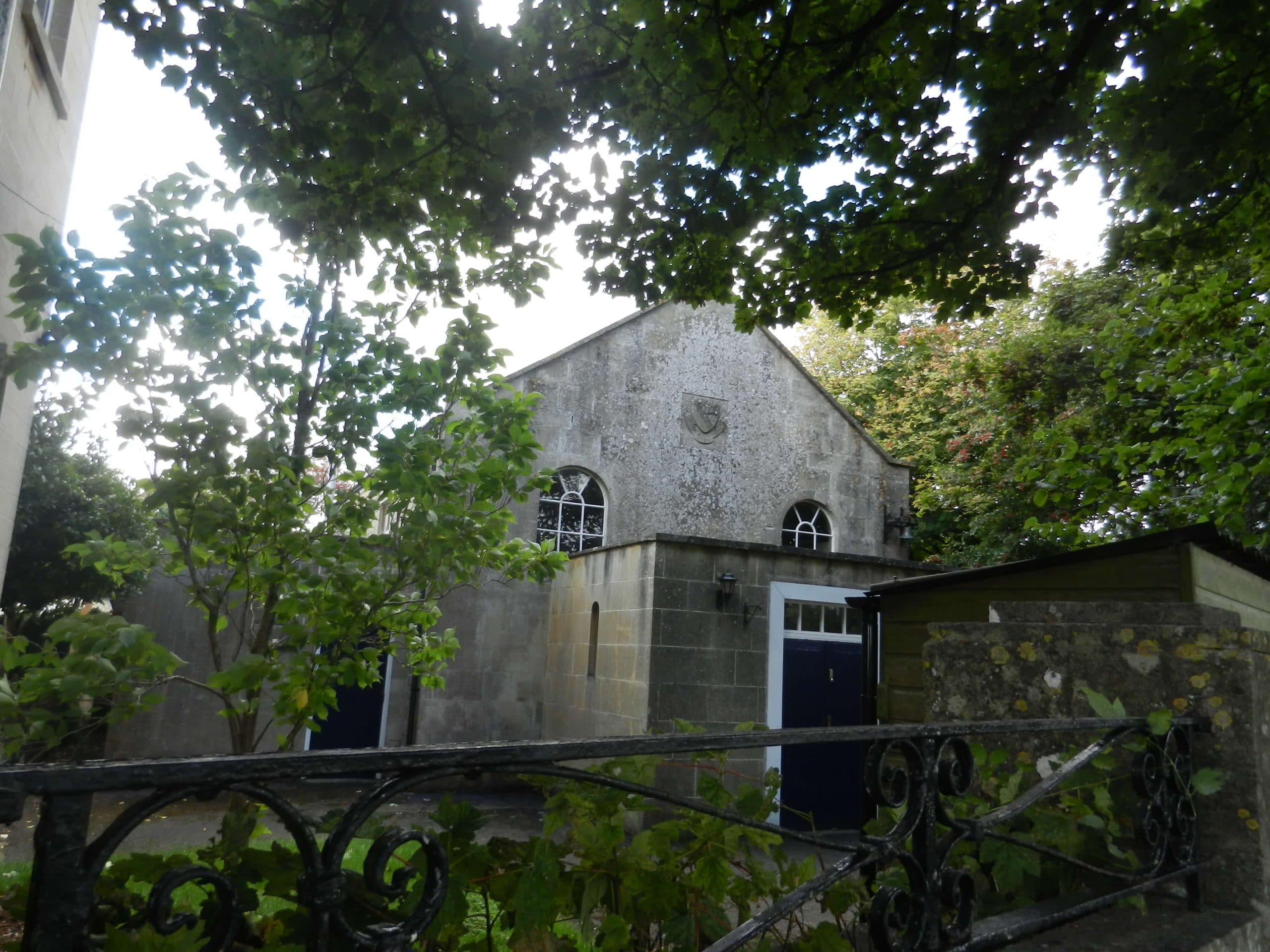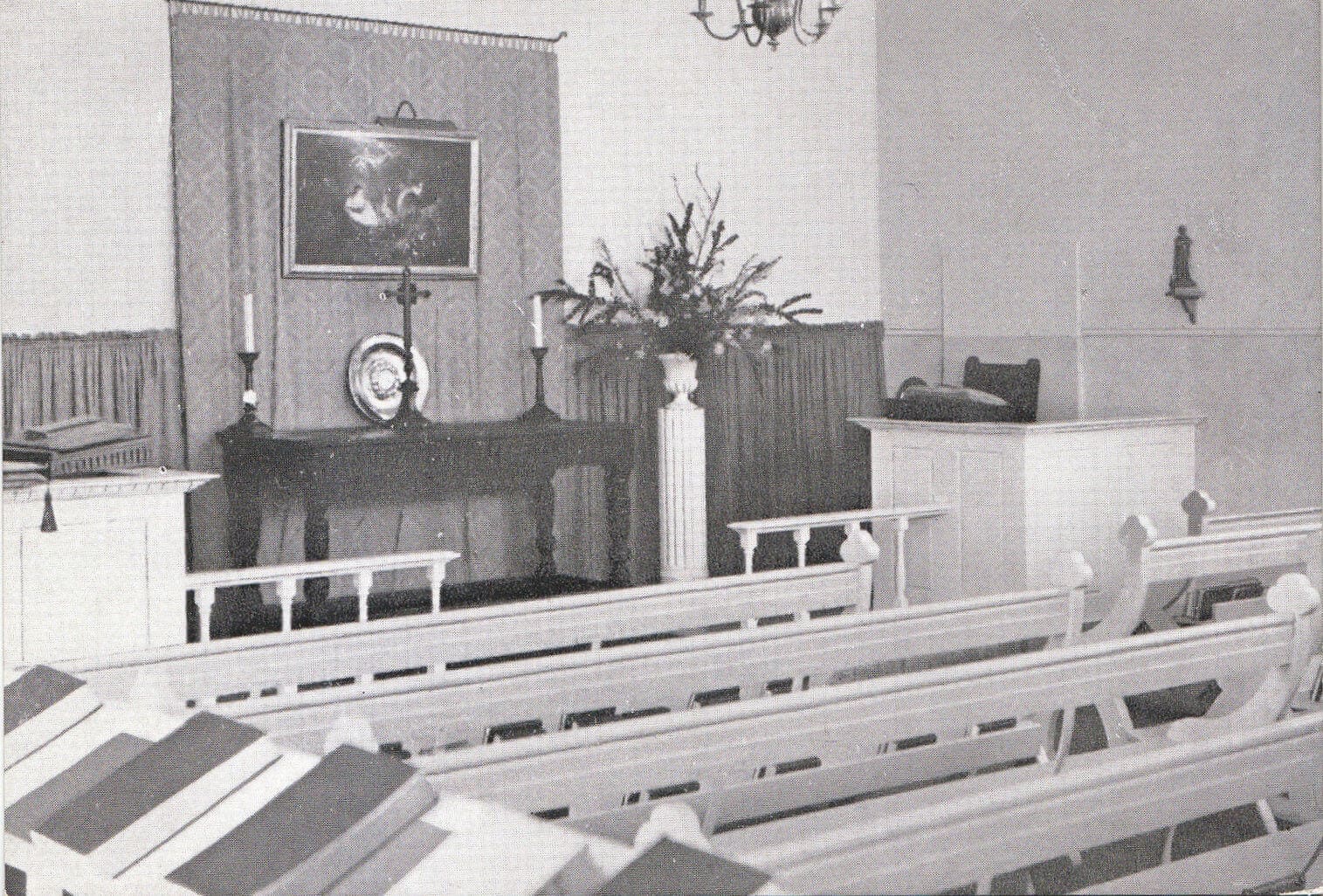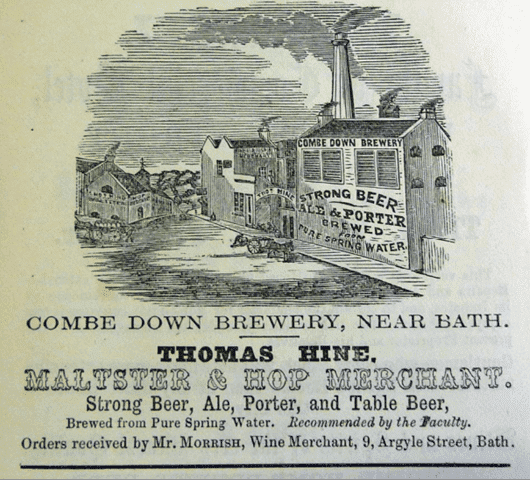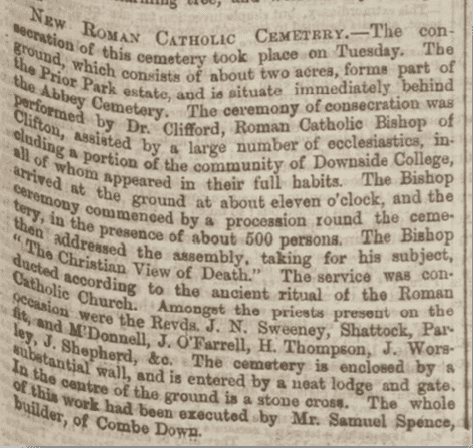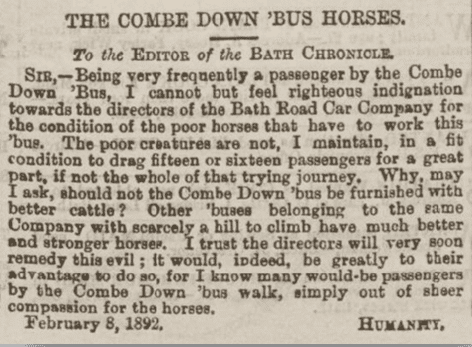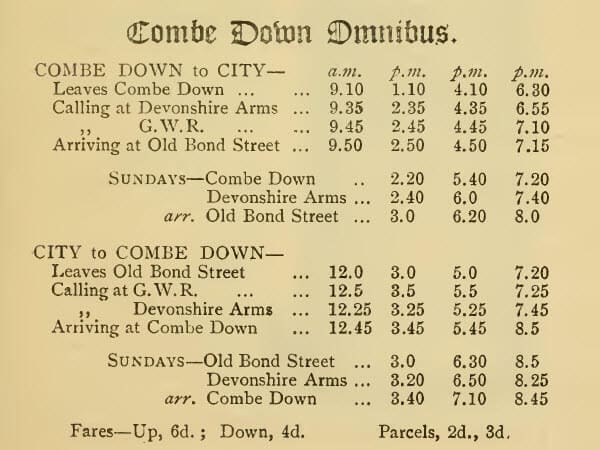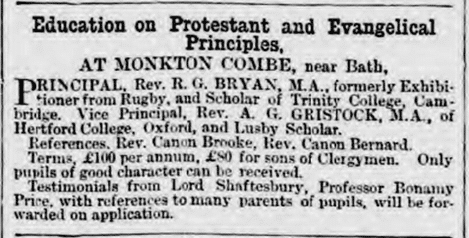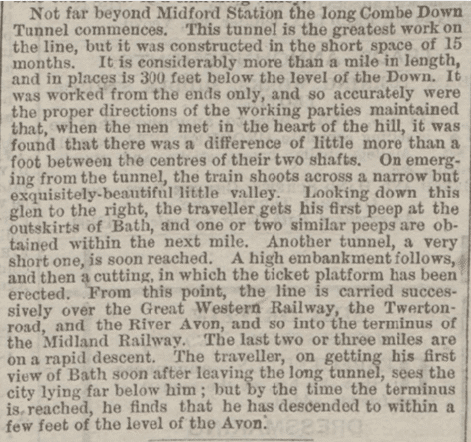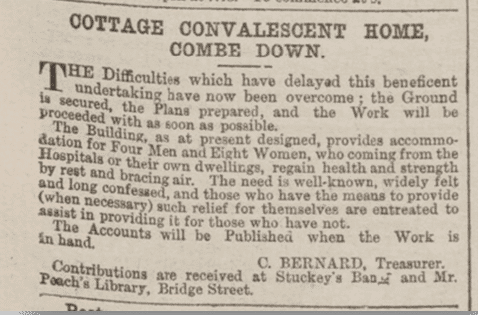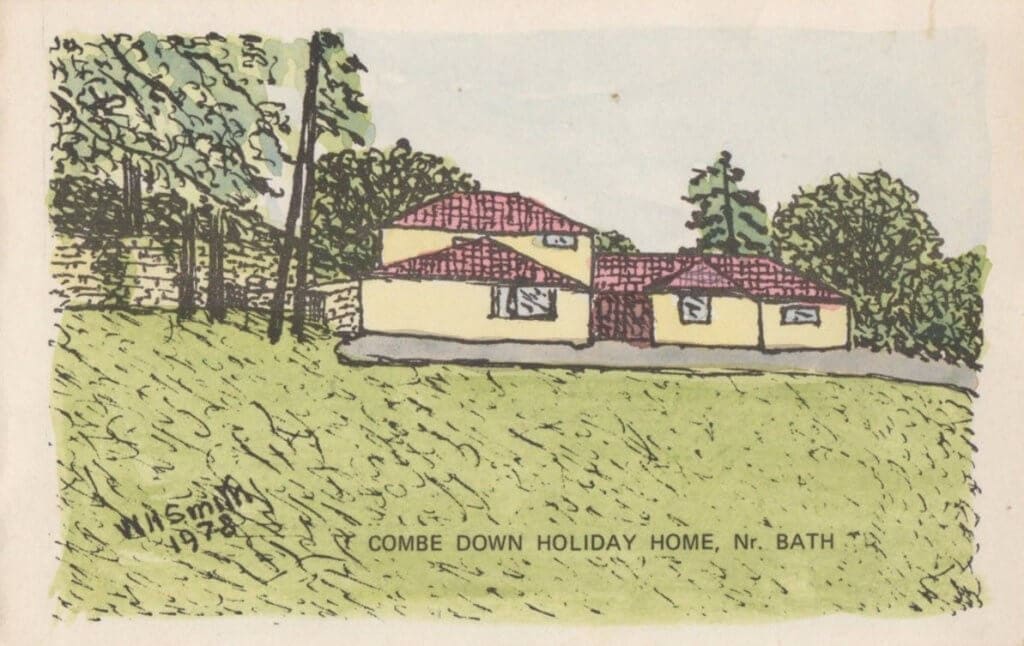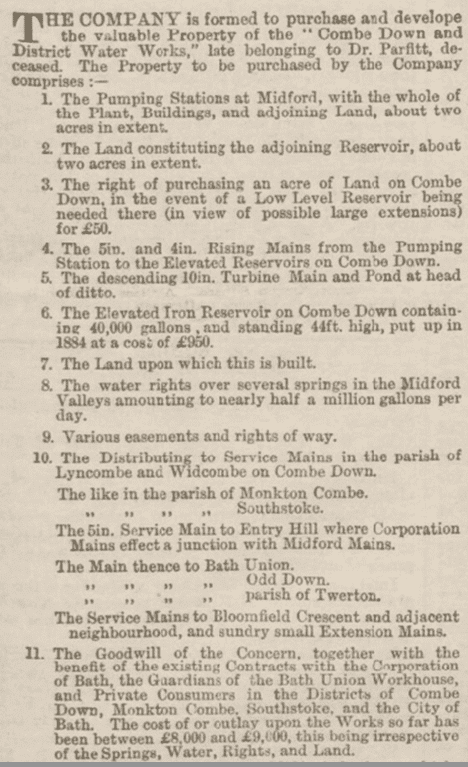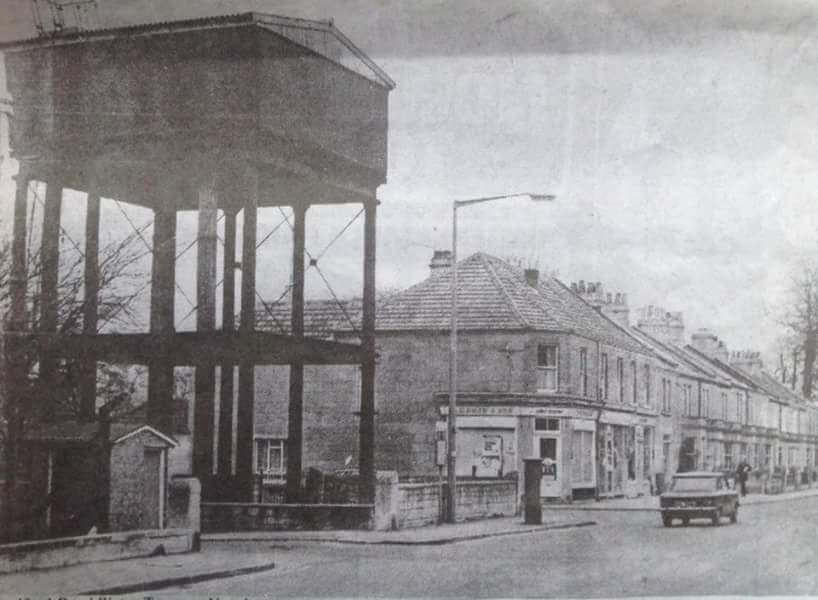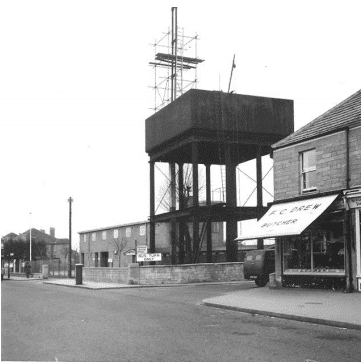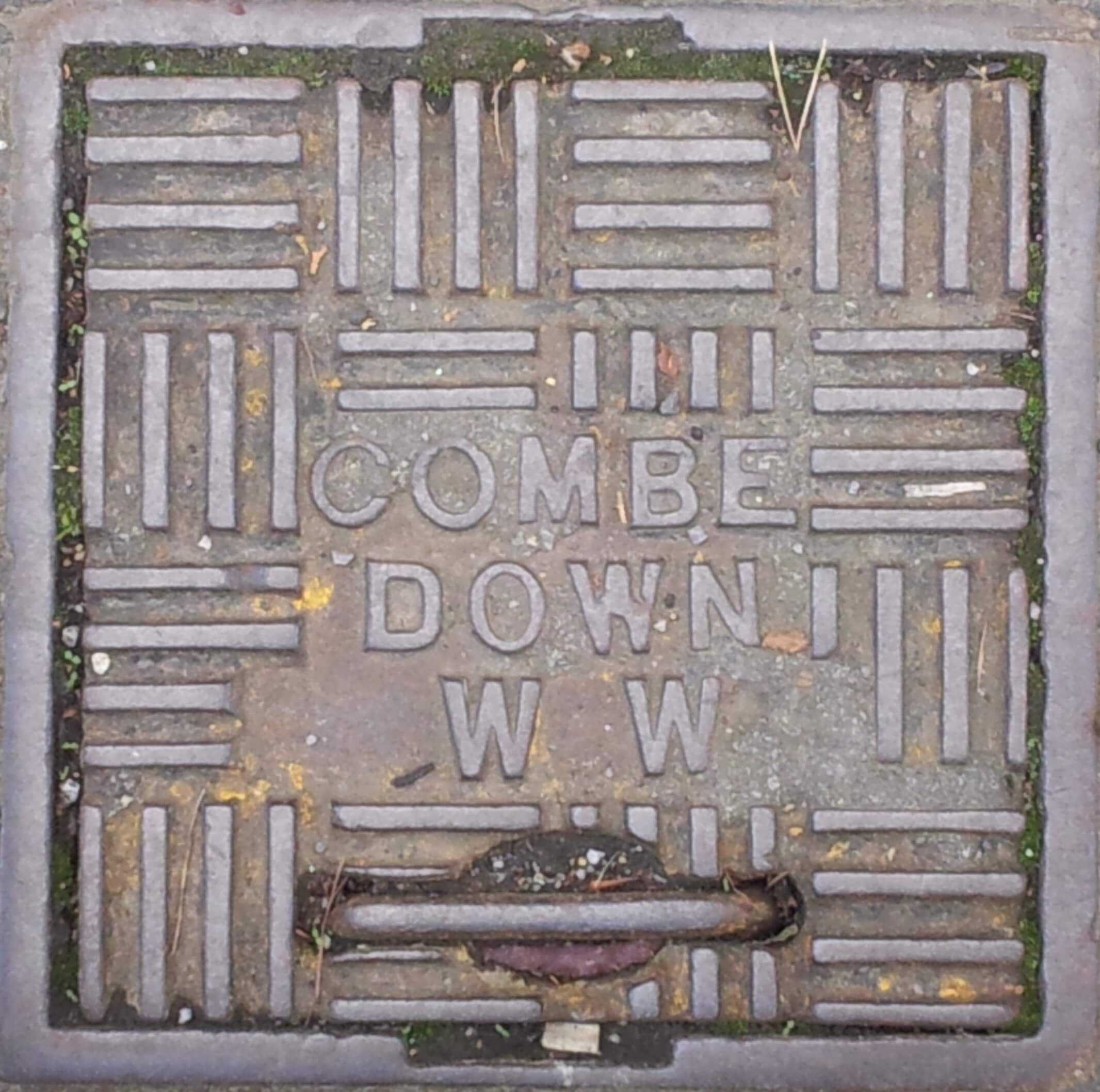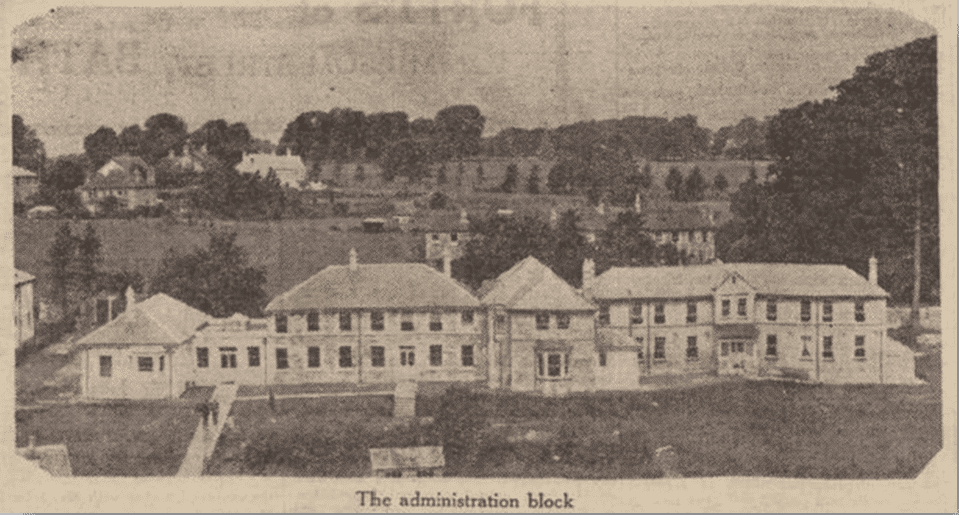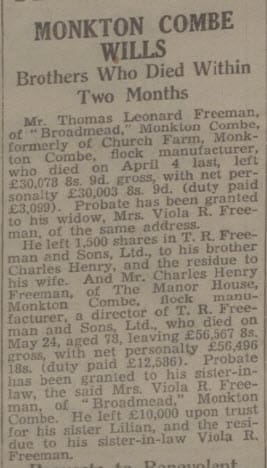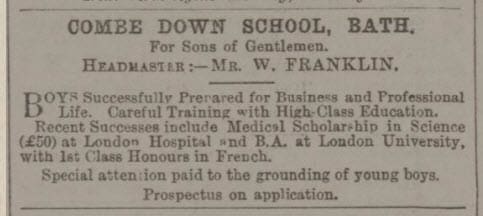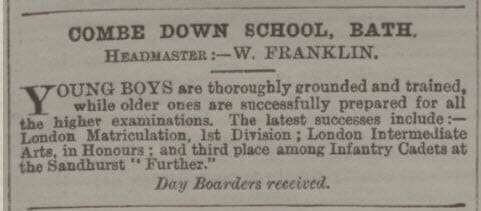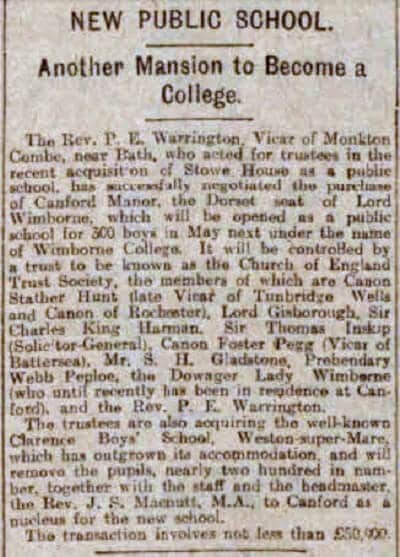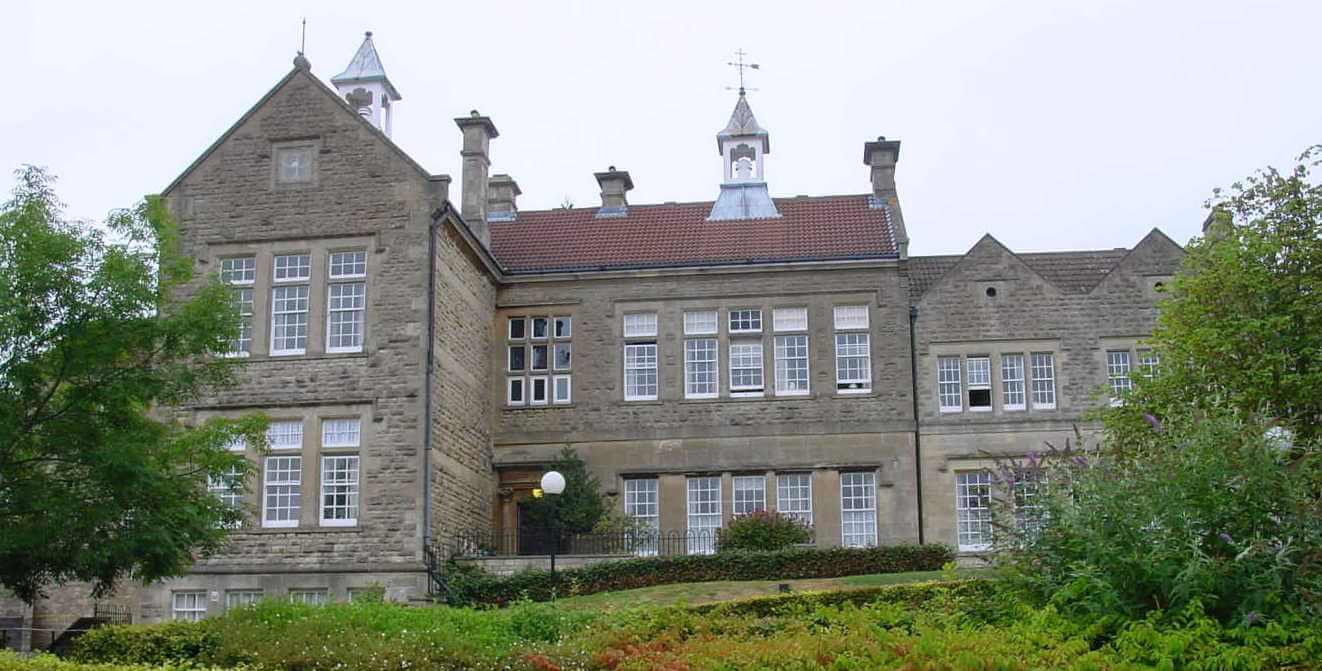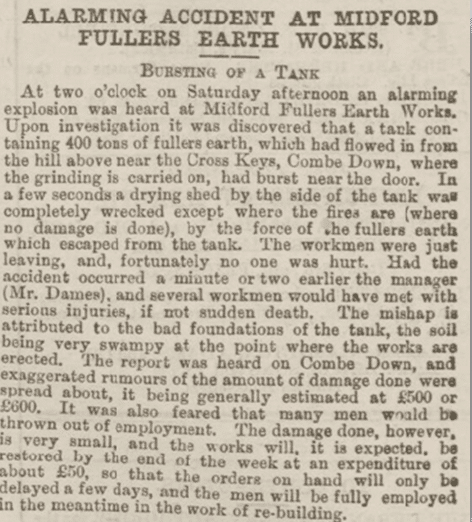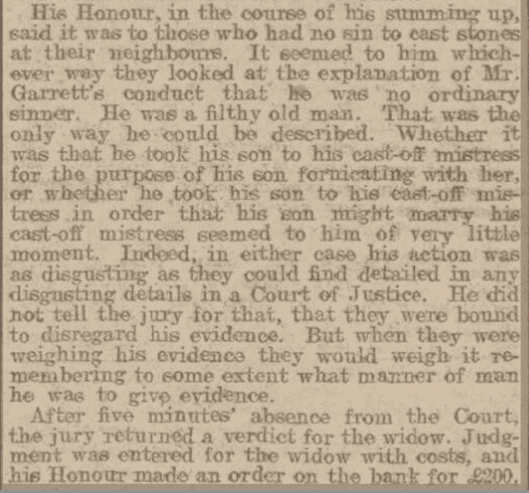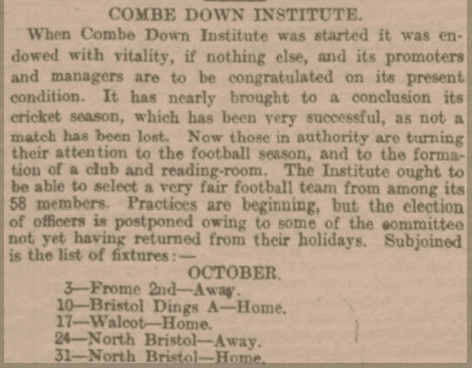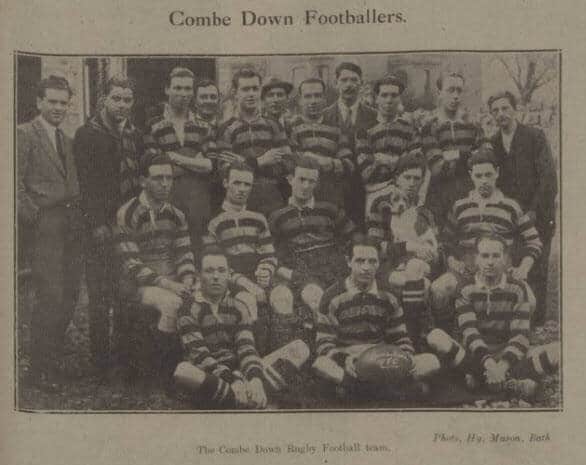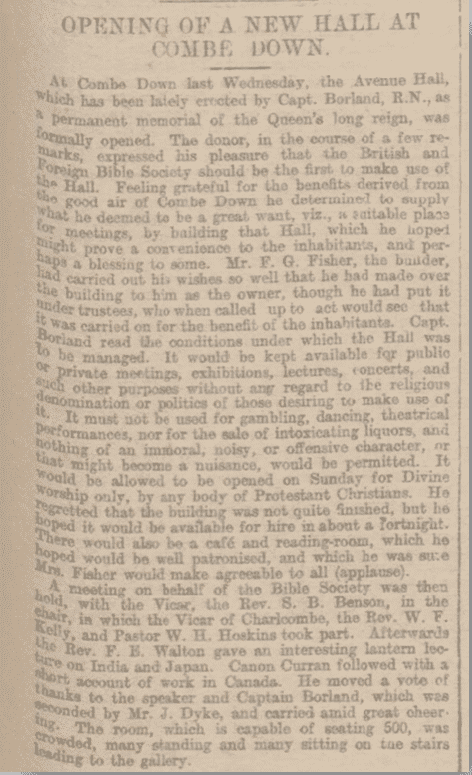Combe Down
Combe Down
In ‘Rambles about Bath’, Tunstall says about Monkton Combe:
“In 1780, it paid £103 poor rates, its population being 280; in 1841, from the great increase of the village of Combe Down, its population was 1,107. This is steadily increasing.”
In 1831 Samuel Lewis put the population of “Combe (Moncton)” at 855.[1] Looking at the census allows us to chart the population growth.
Properties & Population on Combe Down 1841 to 1901 from census reports (see Census summaries)
| 1841 | 1851 | 1861 | 1871 | 1881 | 1891 | 1901 | |
| Properties | 294 | 339 | 375 | 421 | 444 | 554 | 527 |
| Males | 758 | 829 | 803 | 886 | 955 | 1,192 | 1,186 |
| Females | 862 | 909 | 959 | 1,059 | 1,120 | 1,375 | 1,256 |
| Total population | 1,600 | 1,738 | 1,762 | 1,945 | 2,075 | 2,567 | 2,372 |
It’s clear that the rate of growth was fastest before 1840 and then steady.
Unfortunately, the census boundaries for each enumeration district change census by census and so whilst it is theoretically possible to look at Monkton Combe village, Combe Down Village and the areas on Greendown separately, to do it with any real accuracy would be a major task.
By 1850, the stone quarries, the reason for Ralph Allen to establish Combe Down village in the first place, were in decline[2] with the quarries having been fairly well worked.
Meanwhile vast quantities of good quality Bath stone had been discovered at Box when Brunel built the Great Western Railway.
This stone was also, of course, right beside the new railway, making transport simple. In these new quarries the total quarried area is approximately 2 miles long and a mile wide and has some 15 miles or more of tunnels.[3]
Roman Villa
Roman Villa
1852 saw the discovery of Roman remains on Combe Down. In 1822 Henry Mingden Scarth wrote:
“Two Stone Coffins were found near Burnt House Turnpike Gate (in the line of the Foss Road), and previously to this two others near Claremont Place, Combe Down.[4] ……It was discovered while making a garden to a new villa, and served as the covering stone for the lower part of a Stone Coffin, in which was a perfect skeleton. This spot has since proved to have been the site of a Roman villa, and many objects of interest which have been discovered there, are carefully preserved by the owner. Five Stone Coffins have been found on the spot, besides urns containing burnt bones, and a stone box containing the head of a Horse. The Inscription, which is not deeply cut, is difficult to read, owing to the decomposition of the stone. It is as follows: ‘For the safety of the Emp. Cms. Marcus Aurelius, Antoninus, the pious, fortunate, invincible Augustus, Naevius Freedman of the Emperor, and assistant of the procurators, restored the chief military quarters which had fallen to ruin’."[5]
The words “while making a garden to a new villa” indicate Belmont House as the likely site as it was being constructed at this time, which is reinforced by the article in the Chronicle. In 1867 it was felt that the villa may have been a ‘Sanatorium’:
Allotments
Allotments

Allotments on Combe Down were introduced by Rev G W Newnham in 1852.
The allotments were in the area bounded by North Road and Combe Road as shown on the map.
This is the area to the South of Westerleigh Road, above Combe Road Close and to the West of Rock Lane. There were some 40 – 50 allotments of about 1/8 of an acre and the rules from 1884 were published in Around Combe Down by Peter Addison.
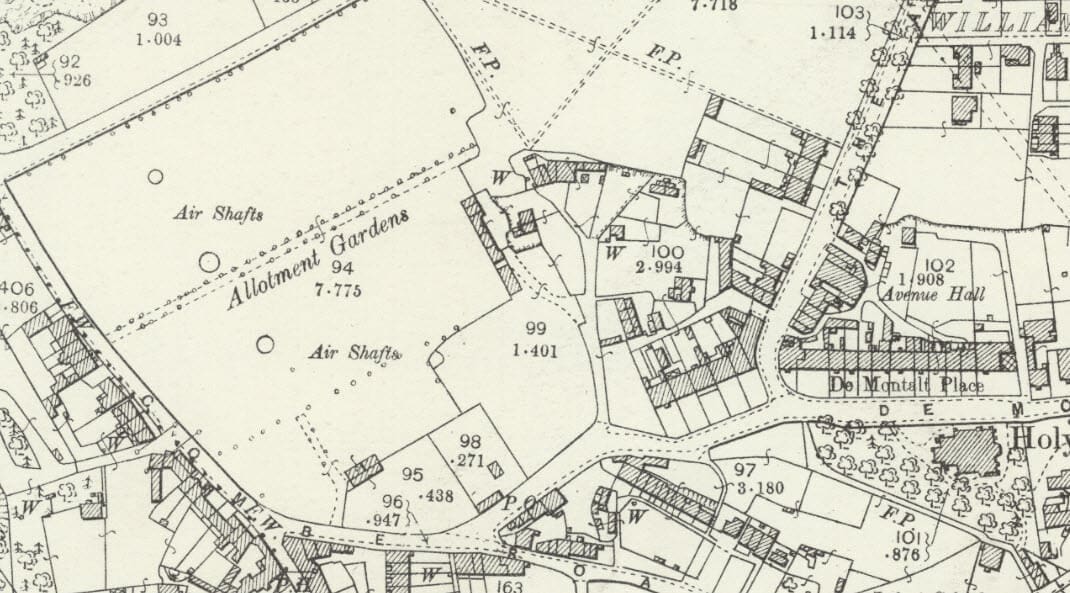

There were allotments in the Westerleigh Road area until 1938 when there was a story in the Bath Chronicle and Weekly Gazette, Saturday 8 October 1938 stating that tenants had been given notice to quit.
This left some allotments in the area the junior school’s log cabin now stands that were there from the early 20th century.
The current allotments between Hancock’s quarry and Monkton Combe school were certainly there by the turn of the 20th century – as the map below illustrates.
History of allotments
Allotments have been in existence for hundreds of years. Under the feudal system the open field system, a furlong was split into strips, of about half an acre. Each peasant had several strips allocated at a public meeting at the start of the year. They were scattered to prevent one person getting all the good land.
Peasants also had common land for grazing, fuel etc. As the population grew, the lack of land made it difficult to maintain the system and, from the 16th century, enclosure started to occur, as landowners saw they could make more money by having larger farms where they would decide the arable or livestock farming and the farming practices. In addition there was a growing population which lead to pressure on the open field and common land system.
When enclosing some landowners were unscrupulous and just evicted tenants, but if they could prove documentary evidence of their open field and common land rights some received an allotment of land in compensation. Enclosure lead to the agricultural revolution and a prosperous group of landed gentry but a many more landless and hungry poor.
Over 3,500 Acts of Parliament were passed between 1700 and 1860 to enclose over 5 million acres of common fields and land and less than 12% of people who worked on the land owned any. As enclosure increased, and the industrial revolution grew, more people moved into towns. It soon became clear that both rural and city poor needed something to help alleviate their poverty. Allotments were one answer but were strongly resisted by many farmers and landowners.
The food shortages experienced during the Napoleonic Wars led to some changes in thinking and the Select Vestries Act 1819, gave churchwardens and Poor Law Overseers authority to purchase or lease up to 20 acres of land and let it to the poor and unemployed of the parish as allotments.
The Swing Riots of 1830 and 1831 and fear of further unrest and Labourer’s Friend Society promoted extension to 50 acres, achieved by three acts passed in 1831 and 1832.
The General Inclosure Act 1845 required that the landless poor be provided with ‘field gardens’ as the rural land was enclosed. This helped in the countryside but city folk had no access to land. They began to push for allotments and urban allotment development began.
More progressive landowners, employers and clergy recognised that allotments could improve living standards and with the Allotment Extension Act 1882 that required trustees holding charity land for the use of the poor to set aside part of that land for use as allotments; the Allotment Extension Act 1885 allowing allotments to be let at the same rate as surrounding farmland and Allotment Extension Act 1887, that enabled Sanitary Districts to provide allotments by the compulsory purchase of land.
By 1890 County Councils were required to have an Allotment Committee responsible for holding inquiries if a Sanitary District failed to provide allotments.
At the beginning of the 19th century there were roughly 250,000 allotments.
In 1908 the Small Holdings and Allotments Act came into force and local authorities had to provide all the allotments demanded.
During WWI the number of allotments rose to 1.5 million.
After the war to help returning service men the Land Settlement Facilities Act 1919 was passed.
Allotment holders rights were strengthened through the Allotments Act 1922 and the Allotments Act 1925.
The latter established statutory allotments which local authorities could not sell or convert without ministerial consent. Under the Local Government Act 1929 agricultural and allotment land became non-rateable. There were 819,000 plots in 1939, 80% of which were urban plots, which increased 1.4 million during WWII with the Dig for Victory campaign, but the number fell to 300,000 by 2009.

An extract from “God speed the spade”: The History of Combe Down’s Allotments by Jacqueline Burrows
Jacqueline has been researching the history of Combe Down’s allotments since recent planning applications have revealed how little is known about their heritage, exposing the ease with which such cherished village assets can be threatened. She hopes to publish their complete story soon.
In 1851, Rev Newnham (1806-1893) developed the field garden allotment system “for the benefit of the labourers of Combe Down”, with yearly rents due each Michaelmas quarter day (29 September).
Tenants paid their sixpences at an annual allotment supper in the village schoolroom at which, amidst much excitement, they were waited on by the Vicar and his second wife Catherine, together with the schoolmaster and some of the local gentry.
This happy event can be traced over the next twenty-five years, until reports cease shortly before Revd Newnham retired in 1877. By October 1855, the Bath Chronicle tells us there were at least 31 allotments in Combe Down, managed by a committee.
Allotmenteering soon spread down the hill to Monkton Combe and in 1857, gardeners from both villages joined the annual meeting in the schoolroom. Rents paid and the Committee’s report read, a “comfortable hot supper” was served to the 44 tenants who were again waited on by Rev and Mrs Newnham and some of the local gentlemen.
A “small exhibition of large vegetables” took place.In October 1860, the coldest and wettest year on record, most of the 39 tenants in Combe Down made it to the annual event in the large new schoolroom, although fewer than half of the 17 Monkton Combe tenants ventured up the steep, muddy hill in the dark.
The meal was – as always – beef, with allotment vegetables and coffee to follow, with some “fine samples” of produce on show. After paying their sixpences, tenants were each given a penny halfpenny back to make up for the failure of the important potato harvest.
Then, as now, everyone went home hoping for better returns in 1861, when the tenth anniversary supper took place.
It didn’t take long to include a prize competition.
In 1863, rents were “for the most part, punctually and cheerfully paid” and a prize fund collection raised £8. Half was awarded to growers whose vegetables “would have done credit to Sydney Gardens”.
Everyone voted that the balance be spent on providing half-price steel forks for all, then went home at 9pm in “happy harmony.
Sadly, 1863 was to be the last joint supper: Monkton Combe’s allotment land was required for a grand new vicarage (now Westfield).
In 1865, the show was extended to include entries from private gardens. ‘It is hoped that this wholesome rivalry in honest labour and skill may tend to raise the character of the labourers, while the prizes offered by their richer neighbours proves their interest in the work.’
The supper was a grander affair too, with waiters being sent across from the vicarage. However, Rev Newnham didn’t come; Catherine had died a few months earlier giving birth to their sixteenth child.
He missed the 1866 supper too: he was in Weston Super Mare getting married for the third time!
By 1868, the show was taking place in the daytime and included entries from across the Down, including grasses and wildflowers from local schoolchildren, and the rent supper had become a separate evening affair.
By 1871 the annual show had become a major event, with the Vicar putting up his own money for larger cash prizes, attracting entries from a wide range of professional growers, gardeners and ‘cottagers’. It was even reported in the Bristol newspapers.
At the rent supper in 1872, the tenants presented Rev Newnham with the traditional inkstand, “in thanks for his kind services to them for twenty-one years”.
October 1875 saw the last report of a Combe Down allotment rent supper, at which the meal was “presided over” by Rev Newnham, now approaching his seventies. In 1877 he left Combe Down after 35 years as its vicar and retired to Corsham.
By 1895, responsibility for the village allotments had been taken over by Monkton Combe Parish Council and the annual rent collection had become an administrative task, carried out by a councillor without ceremony.
Perhaps the allotment supper on the Down with a small show of “fine vegetables” is a village tradition that could be resurrected, once we’ve all emerged from the complications of COVID19!
Jacqueline Burrows, Plot 8A2, Combe Down, 8 July 2020
Wesleyan Chapel
Wesleyan Chapel
Behind Glenburnie and adjacent to Gladstone Road is the Wesleyan Chapel which. according to Around Combe Down by Peter Addison was started in August 1854 and is confirmed by a cutting on the Bath in Time website.
It seems it was not a chapel for long becoming the coach house for Alma Villa (now Glenburnie). From 1922 when Edward Dudley (1847 – 1922), who had owned Glenburnie, died.
Glenburnie was then owned by Monkton Combe Junior School and the chapel became a dining hall. In WWII it was used as a food store then, after the war, as a playroom.
In March 1952 when Bryan Morris became Headmaster he felt that Monkton Combe Junior School ought to have its own chapel and in March 1952 the old Wesleyan chapel became a church once again and was dedicated by Bishop Bradfield of Bath and Wells.
By 2020 it had been converted into a private home.
Brewery
Combe Down Brewery
In 1851 the Hulonce family, who were quarry masters, sold the remainder of their 99 year lease, which included the Lyncombe & Widcombe side of Ralph Allen Yard, to Henry Morrish (1804 – 1892), a Bath wine and spirit merchant, who paid off the £413 15s. 2d mortgage the Hulonces owed.
Some time later he formed a partnership with Thomas Hine (1819 – 1868), landlord of the King William IV. Together they developed the Combe Down Brewery, with a large brewery above the pub and a maltings on the upper part of Ralph Allen Yard.[6]
Henry Morrish and Thomas Hine were probably related. Thomas’ father Richard Hine (1786 – 1859) had married a Mary Morrish (1797 – 1877) in 1818 and it seems likely that she was a cousin or aunt of Henry Morrish.
In January 1889 Cumberland & Green, a brewery in Limpley Stoke, bought Combe Down Brewery.
As noted in the Bath Chronicle and Weekly Gazette of Thursday 18 July 1889 they sold themselves to the Bath Brewery Company which was expanding and taking over smaller brewers. Combe Down Brewery was a casualty and closed, though, of course, the King William IV continued as did the malting yard.
By 1910 James D Taylor & Sons maltsters had taken over the maltings. They remained in operation until 1923 when they and the Bath Brewery Company were acquired by the Bristol Brewery (Georges & Co Ltd.). The company had begun acquiring its smaller rivals in and around Bristol from 1889 up until the 1950s, its last great acquisition Bristol United Breweries Ltd., in 1956.
In 1961 they, in turn, were acquired by Courage, Barclay & Simmonds Ltd. Its name was simplified to Courage Ltd. in October 1970. Courage was taken over by the Imperial Tobacco Group Ltd. two years later.
The maltings and yard were taken over by the local authority after the brewery was sold in 1923 and seems to have been used as stores until the outbreak of WW2 when it became a base for the ARP.
In 1968 it was still being used as a Council Depot.
In about 1970 the yard became known as Gammon’s Yard as Gammon Plant Hire took over ownership using the maltings for storage and the yard for heavy plant machinery.
It has now become Ralph Allen CornerStone and housing.
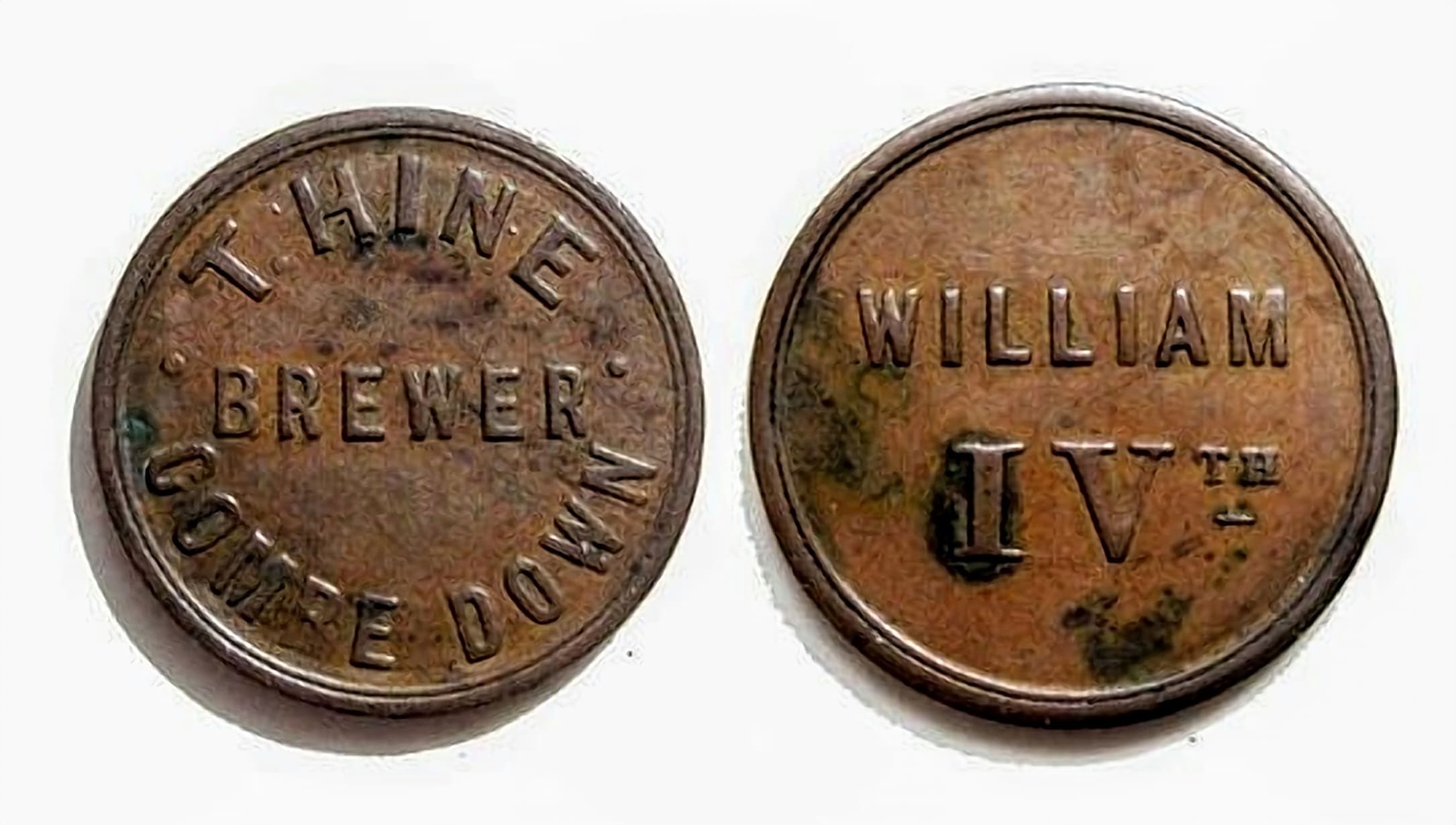
Public Lighting
Public lighting on Combe Down
In 1818, an Act of Parliament was obtained for lighting Bath with gas. The gasometer was located near the Upper Bristol road and over eighteen miles of pipe were laid; general lighting of the city started on 29th September 1819.[18]
By Thursday 2nd September 1830 the Bath Gas Company was extending the work and laying pipes in Lyncombe and Widcombe according to the Bath Chronicle. Over the years attempts were made to get the gas mains extended to Combe Down but the cost seemed to be prohibitive.[19]
It would take an Act of Parliament in 1865 to allow the Bath Gas Company to expand its capital, use rail transport instead of the Kennet & Avon canal and thus expand to include Bathampton, Bathford, Monkton Combe, Claverton, Englishcombe, Newton St. Loe, Corston, Saltford, Kelston, Weston, Box and Ditteridge.[20]
By 26th October 1865 the mains had been extended to Combe Down and public lighting was switched on.
Catholic Cemetery
Perrymead Catholic cemetery
Perrymead Catholic cemetery at Pope’s Walk, off Perrymead, is adjacent to Bath Abbey cemetery.
It was consecrated in 1858. It has a mortuary chapel and the foundation stone for the chapel was laid on Thursday 2nd September 1858.[21]
It has a separate chapel for the Eyre family, members of which are buried in its crypt.[22]
The architect for this was Charles Francis Hansom and the chapel was built following the death of John Eyre (d.1861) who was a Count of the Holy Roman Empire.
The chapel was consecrated, on 13th October 1863, by the Roman Catholic Bishop of Clifton.
The Count’s two sons, Monsignor Vincent Eyre, Rector of Hampstead, and Father William Eyre SJ, assisted the Bishop at the ceremony. The vault under the chapel is still used for family burials.[23]
Omnibus
Combe Down Omnibus
An omnibus is a public transport vehicle carrying many passengers generally quite short distances.
John Greenwood ran the first English omnibus service in 1824 on the Manchester to Liverpool turnpike. He had a horse and a cart with several seats and offered a service that was different from a stagecoach as no booking was necessary and the driver picked up or set down passengers anywhere on request.
In 1829 George Shillibeer started operating a horse drawn omnibus service from Paddington to the City of London.[24] Omnibus services had started in Bath by 1840:
“Mr. Lane of the White Lion coach office, Mr. Reilly, of the York House, Mr. Pickwick, of the White Hart, and Mr. Clarke, of the Greyhound have started omnibuses, &c, to convey passengers to and from the Railway Station at 6d. each this judiciously making the best of circumstances, and getting all they can out of their gigantic rival.”[25]
The ‘gigantic rival’ was the railway.
A service was operating to Combe Down by 1866.
The horse drawn service continued until the advent of the electric trams in 1904. But the service was not without its problems. Horses could only work limited hours, had to be housed, groomed, fed and cared for and produced large amounts of manure, which the omnibus company had to dispose of. Probably ten or more horses were needed to work each bus in a day. Ill treatment of the horses was a problem.
“George Head of 3 Isabella Cottages, Combe Down, a driver in the employ of the Bath Road Car and Tramways Company was summoned for ill treating a horse, by working it in an unfit state and was fined £2 2s and costs.”[26]
There was much sympathy for the horses as letters to the Bath Chronicle show.[27] In 1892 it seems that the fare was 9d. down and 1s. up though Mr. T. Gould, who had, it seems, sold his business to the Bath Road Car Company says that when he ran it, it was only:
“……one shilling to and from Bath, with much cleaner and better accommodation than at the present time.”[28]
Monkton Combe School
Monkton Combe School
Monkton Combe School was founded in 1868 by the vicar of Monkton Combe at the time, the Rev Francis Pocock (1829 – 1919).
There were six pupils for the Lent term who were taught in his home.
In 1875 Rev Pocock became vicar of St. Paul’s in Poole[29] and the Rev Henry Wright ‘acquired the interest of the school’[30] which then had 18 pupils. He also purchased the advowson of the St Michael’ s church and conveyed it to the Oxford Churches Trust making it the church patron and affecting the appointment of the vicars of Monkton Combe for many years.
Henry Wright (d.1880) was Honorary Clerical Secretary of the Church Missionary Society and well off – he left £120,000 in his will[31] after he drowned in Coniston Lake having leapt from a boat but, becoming exhausted, failed to reach the shore.[32]
He appointed Rev Reginald Guy Bryan (1819 – 1912) as headmaster.
Rev Bryan was the Perpetual Curate at Fosbury, Wiltshire, where he had been for some 20 years and brought some of his pupils to the school. He was soon advertising for more pupils.
By the prize day reported in the Bath Chronicle in 1878[33] the school had 65 pupils.
Over the years the school has grown to over 350 pupils.
The Junior School was established with four pupils in 1888 in a private house in Church Road, Combe Down by Mrs. Howard (the daughter of the senior school principal Rev Reginald Guy Bryan) and moved into its current premises in June 1907.
The school chapel was opened in 1927.
The pre-prep was added in 1929[34] and moved into new premises in 2016.
Over the years the school has used many buildings in the area: Combe Grange, Combe Lodge, Combe Ridge, Scott House, Southfield, Glenburnie inter-alia.
Tunnel
Combe Down Tunnel
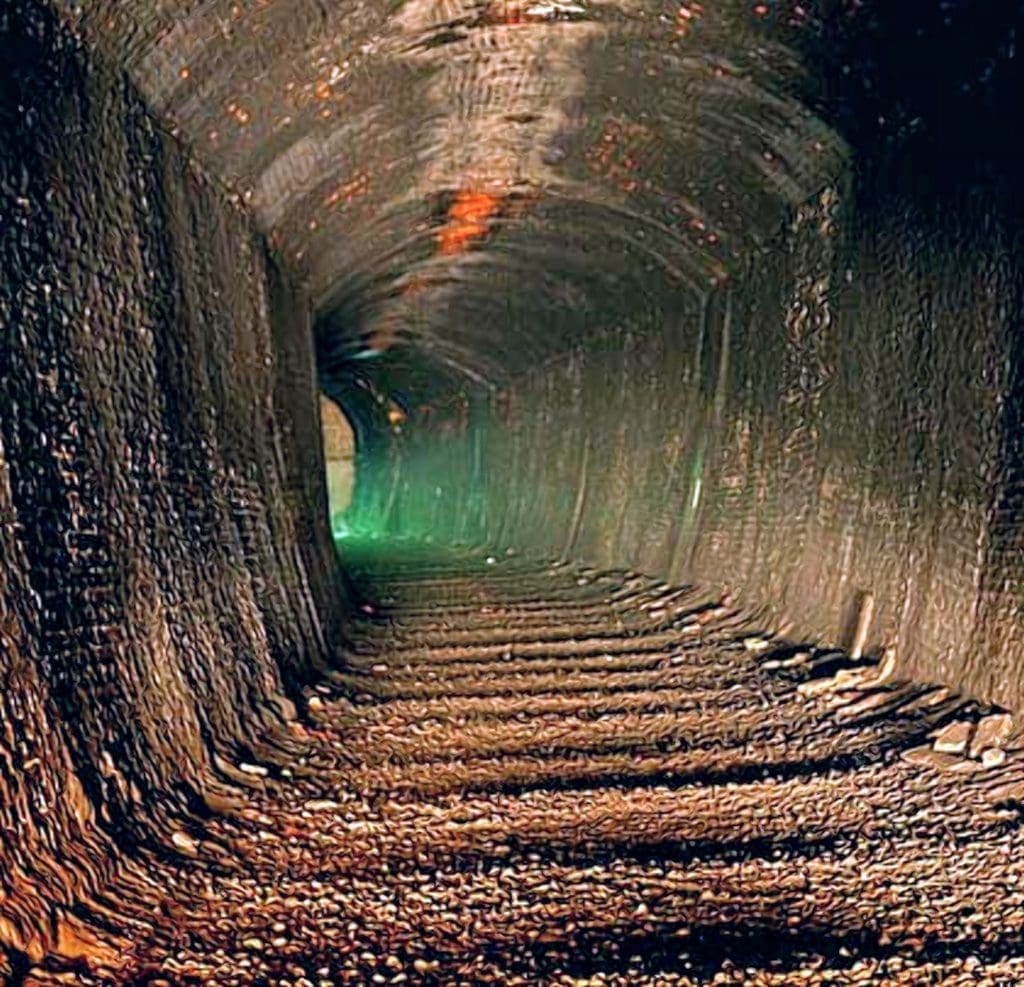
The Somerset and Dorset Railway (S&D) was formed in 1862 by the amalgamation of Somerset and Dorset Central Railways.
In 1870, plans were made to build an extension to create a direct link between Bath and the Midlands with the South coast.
Work started in 1872. It cost £400,000 to build 26 miles and although it was successful the Company, which was not strong anyway, went into receivership and in 1875 it became jointly owned by the Midland Railway and the London & South West Railway.
On 20th July 1874 the Combe Down tunnel for the S&D opened to regular traffic.
The tunnel is 1,829 yards (1,672 metres) long and was the UK’s longest without intermediate ventilation. Combe Down tunnel was closed in 1967 but was reopened in 2013 as the two tunnels greenway walking and cycling scheme.
Whilst in use it was quite often more than a little problematic.
The article below shows how the great length of the tunnel combined with its lack of ventilation and the gradients of the line combined to cause those problems.
THE 1929 TRAIN WRECK
DRIVER TELLS OF FUMES IN COMBE DOWN TUNNEL.
MINISTRY’S INQUIRY INTO BATH TRAIN WRECK
Theory that footplate men were gassed
ANOTHER DRIVER’S GRAPHIC STORY
Journey through tunnel with handkerchief tied over face after spending a part of Thursday morning, and the whole of afternoon taking evidence, Col. A. C. Trench adjourned sine die his on behalf of the Ministry of Transport into the recent accident on a Somerset and Dorset mineral train just outside the L.M. &S. station in Bath. It will be resumed when the injured men —Guard Wagner and Pearce —are well enough to give evidence.
Somewhat conflicting evidence was given as to the smoky state of the Combe Down tunnel. One said he had found it very difficult to owing to the fumes when going slow.
Another said that when tender first he had never had a bad trip, and generally under those it was possible conditions it was generally possible to discern the roof. As the train tore by several witnesses none of them saw anyone on footplate and no one heard a whistle or a warning shout.
There was plenty of evidence that the brakes were on.

The Inspector first inspected the scene accident, and also the Combe Down Inspector rode the footplate from Midford into Bath to make himself conversant with track and other geographical conditions .
Among those present at the enquiry were George H. Wheeler (Traffic Superintendent, S. and D Railway), Mr. I W, (Traffic Department), Mr. R. C Archbutt. (resident mechanical engineer, (Highhridge), Mr. A. H. II . (Chief of Loco Department, Bath), Mr. Fox (Permanent J Resident Engineer, S. and D.), Mr. H. Rhymes (Chief Mechanical Engineer), Mr. G. (district Controller, L.M.S.), Mr. INT L – M – ‘ ineerin I j’tnient, Walsall), Mr. Worboys and I (Carriage and Wagon Depart\S \ M. and S.), Mr. Fisher (L.M. S), Mr. George Brown (representing South Western District, N.U.R.), Gregory (representing the Society of Locomotive Engineers & Firemen). Witness was Signalman W. H. who was charge of the junction signal box. He stated that the train correctly accepted, and came past his a very high speed. He did not whistle, and, far as he could tell the line was quiet..
SINTER’S GRAPHIC STORY.
Henry Wm. Crew said there was a din and heard the train go by at speed. He leaned out then and saw the tail end of the train down to the siding about 300 yards. He heard the engine leave then the crash. It was like the collision of a lot of coal. He rushed down to the siding it was mess said the witness. “I could spend years on the account. I felt the cabin shake way that made me think ‘what was going like that. Raw sparks from the brake van, but & probably have seen any from owing to the distance. I made way to the cabin, and was pushed back twice before I was successful- had my lamp, but could not see the steam. I judged from the hat the safety valve was blowing.
W F added that on the second he tried to enter the cabin hen’s legs protruding. He felt the end found it was beating. He got down put it on something inside ‘ and then found the head of *** up with his coat. I put ”************************” and the answer came *** “” ************* » a bad to scrape it out of eyes. Gas from the broken ***** office was coming over my bad to retreat. It was the I felt a afraid – Then I *********************************************************************************** his head, I think was deliberately wrapped over head. I found his clothes were smouldering and that was rubbed out. was driven back the intense heat, but there was very little steam then. then found another man lying in the permanent way. Meanwhile others had got into the cabin. The firebox was practically full, and it turned over it was coming over the bridge on to the footplate, where the men were lying.
The Inspector : When the engine came round as far as the junction, were you surprised it kept the rails?
Witness: I was surprised, and the feeling of the movement of the hut made me look out. The Inspector congratulated Mr. Crew on his efforts to get Fireman Pearce out.
Shunter C. H. Hill was next called, and he told how he and two others were standing on the bridge over the road waiting for the train to come in when Inspector Norman came out and shouted: “Clear away. Look at this engine.”
SPEED OF TRAIN.
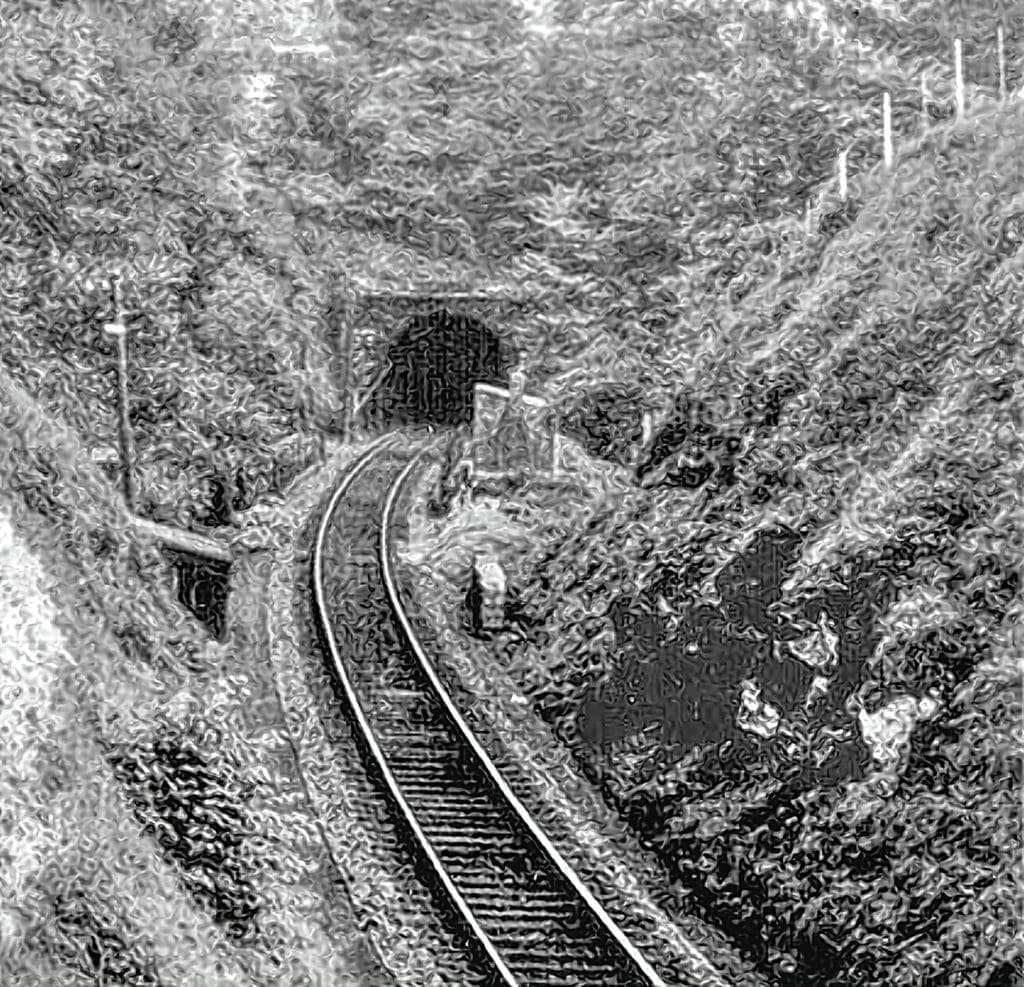
Witness estimated the speed of the train at from to 60 miles an hour. Spirals were coming f;om the w heels of the engine it passed “The wheels were all afire.”
The Inspector : Did you see the driver or fireman on the engine it passed?
Witness: No, did not sir. Witness proceeded to describe how he came across the body of Loder, and took part in the rescue operations Shunter W. F. Day gave evidence supporting that of the previous witness. Checker Richards, who .aw the train coming down into the siding faster than usual and was obliged to run clear, said there was no shout of warning. Sparks were coming from the tender wheels. He could not see the inside of the cab from where he was. It passed him at be 50 and 100 miles an hour.
Driver White, who was taking his engine into the S. & D.J.R. sheds, and was attracted to the ill-fated train by the tremendous noise, said he saw the whole train pass at a very high speed. His experience of these engines was that when the brakes were on there was a distinct rail fire round the tread. Sparks came from the top of the wheel, not the bottom. At the time he thought the brakes were on. It did not appear to him, on consideration, that they were. The sparks at the top of the wheels were, he suggested, caused by the tremendous rock of the engine, which resulted in contact between the flange and the frame of the engine. There were no sparks from the tender wheels.
The Inspector: I take it that is opinion you give with some reserve. You would not like to express very definite opinion. It is only a suggestion? ,
Witness: That is so.
TROUBLE FROM GASSES.
Witness added that his impression was that steam was on. He did not recollect seeing steam coming from the chimney. The engine was making a tremendous noise, and there was rattle of the wheels different from what had heard before.
Witness did not examine the engine. “I was too shaken. could not seem go near it There were plenty more around her,” added witness. Witness had worked trains over, the same section of line.
The Inspector: Have you ever had any trouble with that tunnel?
Witness: Yes, sir.
The Inspector: What trouble?
Witness: Trouble from gasses.
The Inspector: What do you mean, that breathing has been difficult?
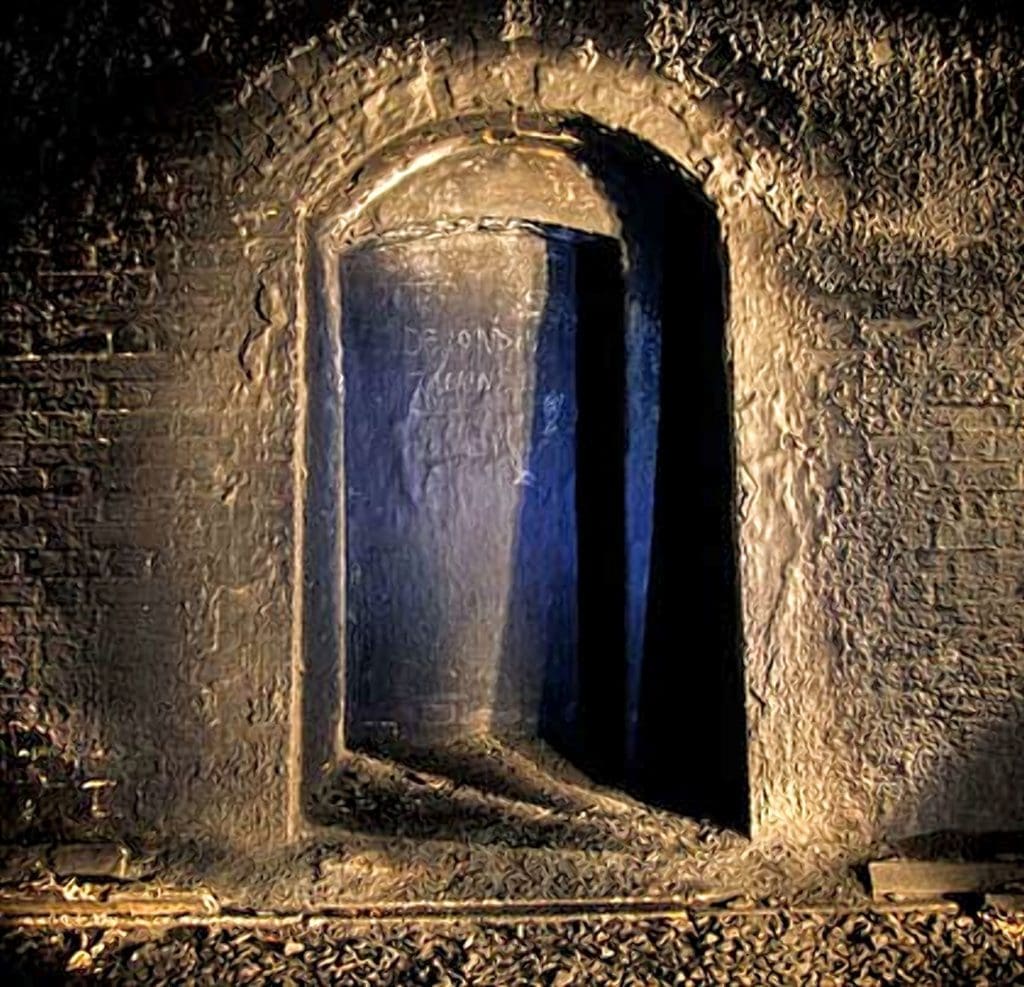
Witness: Very difficult. He related one experience early this year. He started at dead from with a similar engine and full load, reaching Midford tunnel always at walking pace. He was tender first.” Just inside the fireman cried out. The smoke was bad. He tied a handkerchief over his nose and told the fireman to do the same, which he did. He crouched down on the footplate with his bead just outside the tender wall to catch the current of air; his left hand continually working the sanding gear. The steam made things worse. jumped and added coal to the fire, getting down again sharply. He wanted to keep the boiler pressure up to keep moving. The fireman did the same. The engine was not slipping. The tunnel was often wet and wanted care in the use of sand. They managed to crawl out of the tunnel very very slowly. soon as he saw a gleam of daylight he shut off the steam and was prepared to stop as soon as he got outside the tunnel and see how things were before going into Bath. He did not stop, but took five, eight or 10 minutes to reach the mouth of Combe Down tunnel. Replying to further questions witness said he felt the effects of it for a day or two afterwards and his fireman also complained about it. He thought the fumes were from his own engine, because the wind was following and keeping with them all the time.
AUTHOR
HIS THEORY.
The Inspector: Have you any views to what happened on this occasion ?
Witness: That the only thing. They were overcome by fumes and down there and did not know what was happening.
The Inspector pointed out that they had had a good deal of evidence that the brakes were on.
Witness expressed the view that possibly the steam pressure may have dropped back owing to the circumstances, and could not operate the vacuum. The brakes on that type engine were really good brakes, and his opinion was if they had been applied they would have been bound to have stopped the train. In answer to Mr. Symes, witness said he was having a little trouble with the engine and for that reason it took him much longer to get to the mouth of the tunnel. He usually entered the tunnel much faster. He knew was in for a bad time. The stand at Midford did not improve the fire.
DISLIKED STOP AT MIDFORD.
Mr. G. Brown asked witness his opinion of the causes why the train, which came to grief, was long on the up-gradient? Did he think it arose from falling steam pressure in climbing the gradient, especially as the load was under schedule ?
Witness said he would put it another way. Witness and his fireman were in full possession of their faculties, and were keeping up the steam. If the other two men were down and out through gases the train would come through very slowly.
Inspector: Would it keep on without firing ?
Witness: I think so. explained that drivers were anxious to get steam up as much as possible before entering the tunnel to avoid firing in the tunnel, and especially was this the case if there had been a stop at Midford.

Mr. Brown : Is the anxiety to avoid the chance of sticking in the tunnel or slow running through the tunnel? — The two things together. glow running would probably mean a stick.
Mr. Brown: I am asking what the anxiety arose from ? —To get through the tunnel.
Inspector : And to get through quickly ?
—Yes. Witness said he were working a train with a full load and knew there wae passenger train coming from Bath he would endeavour to regulate his time and speed so as to get a clear run through Midford.
PUTTING ON THE BRAKES.
Mr. Brown asked if any special instructions had been given for working on an incline, other than the ordinary rules? Mr. Wheeler remarked that they understood the load capacity had been governed by the holding power of the brake. He did not think the question of engines not being able to hold the load had ever arisen. Mr. Symes asked what was the practice with regard to the manipulation of the brakes coming out of the tunned in the ordinary way. Witness replied that in the ordinary way the moment he saw daylight at the end of the tunnel he should shut the steam off. He would then on the level and the train would “drive” out of the tv The fireman, immediately on coming out, would screw his own brake on tight. Witness would apply the steam brake and the guard would, of course, use his judgment then to apply his brakes.
BRAKES NOT APPLIED.
Signalman Gardiner, whose home Pigwood Road, said he was standing at the back door of his house within about 20 yards of the track and saw the train going by. The engine was in full steam, which was coming from the chimney. The speed was roughly 50 miles an hour, and he saw sparks flying from the wheels, but the brakes did not appear to be applied.
PREVIOUS PASSENGER TRAIN.

Driver Bowles, who had driven a passenger train into Bath, which had preceded the ill-fated train, said when he came through the tunnel it was much the same as usual. Witness’s engine was not steaming more than usual.
The Inspector: Have you ever lad difficulty in breathing there?
Witness: Oh yes. Several years ago it was very bad. He proceeded to state that being a passenger driver he would not be in the tunnel so long as a goods driver. The tunnel was clearer now than in the old days of saturated steam.
Relating his story of the accident, he said he was walking home in the road about 100 yards from the track when his attention was drawn to the trucks passing at a higher speed than usual. He saw sparks coming from two or three of the wagons. He did not think it was from the brakes. It was probably the result of derailment. * Colonel Trench elicited that the pressure fell so low that it would not maintain the vacuum the steam brake went on. “That,” added the Inspector, “is the position here as we understand it.”
BEEN HAVING TROUBLE.
Signalman E. J. Larcombe, who was Midford signal box on the day of the accident, said the train left Wellow at 4.53 p.m. and arrived outside the outer-house signal at 5.2 p.m. He gave particulars of the movements of certain trains during the afternoon hours.
After the Bournemouth passenger had passed, Driver Jennings came to him and said he had been having trouble, and asked to be allowed to stand until the passenger train had got to Bath. He asked to be allowed to take the “tablet” with him so as not to have to slow up to take it as he passed—to get a better run. He gave no idea to what was the matter, except that he was having steaming trouble.
He realised he had a heavy load. Witness had known drivers fail to get through the tunnel and come back. There some wind on the afternoon, which, possibly, might easterly. The tunnel cleared quicker some days than others— when the wind was north or south. When the driver passed witness’s box was doing what was the usual speed of trains similarly situated—ls to 20 miles an hour. Examining Fitter Bolt, S. and D. Joint Railway sheds, said on the Wednesday before the accident.be tested the brakes on the engine and found them all right. He signed the examination book to that effect.
SAW NO ONE ON THE FOOTPLATE.
Driver Frank Porter, L.M.S. driver who was working with a shunting engine was at a dead end near the junction signal box. The train passed the next line to witness, and he heard no whistling. The speed he estimated to be 45 to 50 miles an hour. Pie saw sparks coming from the engine wheels, and it seemed to him the brakes were on He saw no signs of any steam. The tender brakes were on, but he would not give a definite opinion that the engine brakes were on owing to the spark blowing back. In the case of the brake van also the brakes were on. He could not see any figures the footplate as the train passed, and was rather surprised not to see any. He was looking out for the tablet to be thrown out, which was done into a net. The engine was swaying. Fireman Shipp, mate to the previous witness, gave evidence of a similar nature. “As I looked at the engine to try and see who was driving I could see no one on the footplate. The footplate was in darkness. I did not see any smoke or steam of any description,” said witness.
PREFERRED TENDER FIRST
Driver Hockey, of the S. and D.J.R., who worked the same engine the previous day, said he took slightly heavier load to Evercreech—the opposite way— and beyond Masbury there were gradients as had as this end—a good deal, 1 in 50. The engine was steaming fairly well, and, considering the load, did very well.
Asked he had any trouble with slipping, he said all of these engines slipped. He returned with a train rather tight. The sanding was all right with engine 89. The tunnel in question was a bit dirty, and engine first it was sometimes bit nasty. He had been tender first with these engines as often as anybody, but he had never had a bad trip. Asked he preferred going tender first, he said, Yes, if we were not dealing with the weather; and have been advising turn-table at Bath. (Laughter). would,” he added, prefer going through a tunnel tender first. Ninety times out of hundred they could examine the top of the tunnel, the atmosphere was so clear. one were engine first it had only to make slip or two and it was difficult to see whether the engine was going forwards or backwards.
Once had asked his fireman to see which way they were going. (Laughter). Coming tender first he had never had a bad trip.” What beat him was that Driver Jennings and his mate found it so bad. Replying the Inspector, witness said he went through the tunnel on the 5.15 p.m. goods out of Bath, and did not then find it very bad. This would be about 40 minutes before the train which met with the accident. Replying to Mr. Brown, witness said a full head of steam on this particular engine was 1901bs, and going up Radstock bank he would not want to drop much below 170lbs. J he Inspector asked the witness if could envisage the possibility of both the driver and fireman being overcome as they came out of the tunnel, and the engine worked up uncontrolled just managed to come out of the tunnel, with steam pressure falling to about l00lbs., and then letting the vacuum brake on
Witness: I never entertained that myself, sir.
The Inspector: What is your solution
THOUGHT THEY OVER-RAN.
Witness: I think they overran coming out of the tunnel. I think they came oux a bit reckless. But there i» one solution to that I cannot fathom. Why did not the men blow the whistle to warn the people down here? Replying to a question by Mr. Brown, witness said perhaps the word reckless was hardly the right one to use. What he meant was, he came out of the tunnel at too fast speed for the condition of his engine. If he had not sufficient steam should have come out carefully as he would not have sufficient braking power. Driver Iley, S. and D.J.R., stated that he drove the same engine on the Friday previous, to Evercreech Junction, with a full load. The engine was not steaming well. Some were better than others. He could not give any reason. He had difficulty in getting the bank, and lost five minutes between Bath and Masbury. He had had other engines of this type, and occasionally they were in poor condition. He had never had any trouble with the brakes. They were good brakes. In answer to Mr. Symes, he said soma days an engine would steam well and some days would not.
THE LOCO. SUPT.
Mr. Whittaker, the Locomotive Supt., said on his arrival at the scene of the accident his attention was drawn to the fire-box because a fireman wanted to squirt water into it. He said he must do on no account. He could through looking through the ashpan, there was nothing inside to hurt. There was a fire in it, but it was well contained and not spreading. He then got on the footplate to see whether there was any pressure. None was showing on the gauge. The reversing gear vas almost in full gear and locked. The regulator one-third open; that was, to the pilot jet. There was no steam at all. He did look at the brake blocks till next day. The steam pipes were all intact, and the connections of the brakes were also all intact. The next day found tho brake blocks holding on to the engine wheels. They were in good condition, and well fitting throughout. The sanding apparatus was open.
Inspector: Was there any sign of the regulator of its having been pushed opea a blow?
—I found nothing like that.
I suppose there is no chance of the reverse gear being moved accidentally?
—It was impossible, because the cab had been forced against it. Mr. Whittaker said on getting into the cab he found the hand brake moved a little. From an examination after the engine had been shifted, he concluded that it was clean off.
The Inspector said the steam brake was on, but when steam died away the brake came off. Mr. Brown said he was under the impression all the time that the under brake was on.
The Inspector: I think the under brake ,was on, but not enough for hard brake application. enquiry was then adjourned, the Inspector intimating they would have to meet again when the injured guard and fireman were well enough to attend.
~ ~ ~ ~ ~ ~~ ~ ~ ~ ~ ~~ ~ ~ ~ ~ ~
BATH RUNAWAY TRAIN DISASTER
Inspectors Report to the Ministry of Transport
ENGINE CREW GASSED COMBE DOWN TUNNEL
Risk Removed by Lightening North Bound Train-Loads “I am led to the conclusion that both driver and fireman were overcome by smoke and fumes while passing through Combe Down Tunnel, and that the engine emerged from the tunnel uncontrolled.”

In this sentence of his report to the Ministry of Transport, Col. A. C. Trench, the inspector who investigated the recent Bath train smash, epitomises his view of the cause of the disaster.
“The tunnel has been in use fifty years without any similar case of the engine crew being overcome by fumes, but, although the chances of a recurrence of the adverse factors which prevailed on the day of the smash may be remote, the Inspector holds that the risk not one that should be taken.”
SAFEGUARDS.
The most obvious safeguard, he says, is by improvement in the tunnel’s ventilation, either by a vertical shaft or by fan or forced draught, but these measures would entail so heavy a cost to be hardly justifiable, and the remedy he recommends instead is that there shall be a substantial reduction in the load north-bound trains to Bath. The Railway Company, we understand, have already put this recommendation into operation, and have reduced the loads by twenty-five per cent. There have been no complaints of difficulty since.
THE INSPECTOR’S CONCLUSIONS.
The accident, it will be remembered, mentioned under (b) below, occurred about 6.37 p.m. on November Overpowering of engine by weight of 20th in the Bath Station Yard on the train and/or brake failure. The weight of the train was within the authorised L.M. and S. Railway. The 3.25 Somerset. made for thigs class of engine being met and Dorset goods train, Evercreech Q quarters,’ as against 172 to Bath, ran away down the steep quarters maximum permissible, gradient from Combe Down tunnel to (This system of reckoning based on the Bath Junction, and, after being ********** loaded mineral wagon countrailed, at high speed, at the entrance our quarters,” and heavier to the Bath Yard, collided with and vehicles proportion, according to a completely wrecked the near end a fixed scale).
The brake equipment building used by the railway clearing was found to be in good order after the house staff. accident, with the exception of Three men were killed—Driver J. H. breakage on the Bissei truck, Jennings, Inspector Norman and Mr. Dentiy due to derailment. The brake Jack Loder, a railway clerk ; Fireman blocks had been reported by a driver Pearce and Guard Wagner were seriously previous as requiring injured. taking up and they had accordingly After reviewing the evidence taken at adjusted on the morning of the his inquiry at considerable length, accident. They were in good condition Colonel Trench sets forth his conclusions and had required nothing more than follows:— normal attention. The rail was dry. Certain points regarding this case may ************* engine was be disposed of very briefly. There are no ********** but after accident questions of defective condition or era *********** found the sand ************ of points, signals or permanent way. used There is no doubt that the speed of the ‘ train at the moment of passing Bath-
BRAKES NOT OVERPOWERED
****************************** The evidence of several drivers with or safe, and various witnesses experience of this type of engine and similar pressed surprise that the ************** kept to the loads on this line was unanimous in that rails when negotiating the facing points they had never had any trouble with and curvature this point. The final de-braking. railment was the natural and almost The most definite objection to the theory inevitable result of this excessive speed. of overpowering is, however, the fact that The investigation must, therefore be attempt had been made to reverse the directed to the determination of the cause engine nor to apply the hand brake on the of the excessive speed. *************; the question of when the steam Possible causes of excessive speed are brake was applied on the engine and tender (a) Carelessness or reckless driving on the discussed further below, but it was ***************** of the driver at the top ************* not applied for most of the descent, down gradient, with subsequent in- addition, it is guile clear that there ability to stop.
NO CARELESSNESS.
************************* think, may dismissed at once, (c) possibilities (a) and (b) above being Driver Jennings was a man of 57 years of thus ruled out, the only reasonable age, with 39 years’ railway service, passed alternative is that during the descent driver in 1915 and made driver in 1919. He from Combe Down tunnel neither of was intimately acquainted with the line, the men on the footplate was in a the engine, and the working of similarly condition capable of taking any action laden trains, and he had a very good to control the train, ************ record. It inconceivable that he could ported by the following evidence, as wittingly have allowed his train to attain well by a number of the preceding such an excessive speed on this steep items. gradient, having regard also to the points
The evidence of Fireman Pearco and enter the tunnel (from the Midford end) at a fair speed, they are not in the tunnel long enough for conditions to become ‘ serious, and that trouble is liable to arise only when they are stopped at Midford and have to re-start with a heavy lead up the severe gradient leading to the tunnel.
There appears to be no question of any difficulty in traversing the tunnel in the south-bound direction. The simplest remedy would be, therefore, to make a substantial reduction in the permissible loading (north-bound; over this section of the line, or, necessary to provide a banking engine from Midford the southern entrance the tunnel. In addition this, it would be desirable to arrange as far as possible that north-bound goods trains, which have to detained on the south side of the tunnel, should be detained at Wellow rather than at Midford, so that they can run through Midford and not have to start against the severe gradient.
Combe Down tunnel gas and crash
Owing to the limitations of single line working, recognise that this may not always be convenient. I understand that the question of the reduction of permissible loads is now under consideration by the Company. would recommend that a close watch be kept on the results attained by any such reduction, with a view to confirming the adequacy thereof, or, if necessary, the consideration of further measures of amelioration, such arrangements for ventilation.
“TENDER-FIRST” DISCOMFORTS.
A further point which arose in the course of my Inquiry the fact that, owing to these engines being too large for the turntables available, they have to work through the tunnel tender leading when travelling towards Bath. Some of the evidence inclined to a theory that operation with tender leading accentuates the discomfort of the smoke and fumes, by reason the engine cab forming cup which tills the tunnel, and tends to collect and intensify them. On the other hand, it evident that, with this arrangement, the chimney being in rear of the cab, there must be a tendency to leave behind the smoke from engine itself, and, except perhaps when the engine is moving at an unusually low speed, one would expect that the tender leading arrangement might be preferable. The evidence of driver on this point was neither unanimous nor convincing, and 1 doubt whether “the fact of working tender leading had any direct bearing on the regrettable accident. It may noted that the first five of this class of engine, constructed in 1914, were fitted originally with tender cabs, but 1921 the cabs were removed from the tenders, view of complaints that they were inconvenient and uncomfortable. It should be possible to form a fairly conclusive opinion tunnel conditions, tender leading compared with chimney leading, from the results of a few practical experiments, and, before it is decided to continue indefinitely a regular practice working these large engines tender leading, I consider that such investigations would very desirable. If the results were such to support the argument that working tender first seriously objectionable, the provision of adequate turning arrangements should receive further consideration by the Company.
‘STIP’-STONE.
Former Bath ********** Illness After Tunnel Trip. “The report of the Government Inspector on the train smash at Bath, in Saturday issue must have been specially interesting reading to any who remember the construction of the line and the early days of the tunnel,” writes an old Bathonian. “As a school pupil’ whose master was keenly interested in his pupils and imbued them with a love of nature study, we were encouraged to find out all we could about the fossils and rocks, and the uncommon botanical growths which billowed their removal to the open. What appealed most, perhaps, to the boys was the “stink stone” which the navvies found in the tunnel. For a considerable time after the tunnel was first opened complaints were very general on the part of passengers, and gave the officials of the line much anxiety, of the foul gases which prevailed in the tunnel. There were many complaints of illness popularly attributed to smells in the tunnel; notably the illness and death of the Rev. Charles Kemble, Rector of Bath. It was a considerable time before adequate ventilation was secured to overcome the trouble.” Guard Wagner, that the tunnel wa6 on this occasion exceptionally hot and smoky and that after a short distance Pearce had to wrap a coat round his, head and sit down, after which he remembered no more. The fact that after the accident the position of the bodies of Driver Jennings and Fireman Pearce was such that it seems probable they must have been lying on the footplate at the moment of derailment. The fact that none of the nine or ten ‘ witnesses who saw the tram pass more or less close proximity saw anyone on the footplate.
IN THE TUNNEL.
The evidence that the tram was an unusually long time in the tunnel, and the inference that the engine was probably labouring heavily for most of the time. I am therefore led to the conclusion that both driver and fireman were overcome by smoke and fumes while passing through Combe Down Tunnel, and that the engine emerged from the tunnel uncontrolled.
Having regard to the falling gradient, it can be shown by calculation that, even assuming the engine was only just moving at the exit from the tunnel, it might well have attained a speed of 60 miles an hour or more at the foot of the gradient, in spite of the guard’s brake application. The above conclusion has been confirmed by medical evidence at the adjourned inquest on 17th February, when the medical officer who had been asked the Coroner make a post-mortem examination of Driver Jennings, stated that he had found there was at least per cent, saturation of the blood with carbon monoxide, and that as a result Driver Jennings must have been either unconscious, or on the borderline of unconsciousness, in such condition as to be helpless to perform his duties.
The fact that the engine and tender brake blocks were found applied after the accident can be explained in two ways, either that the fracture of the tender vacuum connection applied the brakes while turning over, or that the engine descending the gradient at high speed in full gear, with regulator partly open, drained the boiler of steam to euch an extent that the vacuum ejector failed to maintain the vacuum and thus applied the steam brakes. It was found by experiment that when boiler pressure had fallen to lbs. the vacuum failed to the degree necessary to apply the steam brakes Such application would, of course, be gradual, and the retarding effect the steam brake with such low steam pressure would be trifling. The point is not, however, very material, as, whether the brakes were not applied until the derailment or only lightly applied near the end of the run, in neither case would they have had any appreciable retarding effect.
RECOMMENDATIONS.
Lightening the Load of North- Bound Trains. This tunnel has been in use for over years without any similar case of the engine crew being overcome by fumes, and for the last years this class of goods engine, with practically the same maximum loading, has been traversing the line; from the evidence of a number of drivers and others it is fairly clear that under normal circumstances the atmospheric conditions are not euch as to involve any risk or thing more than a degree of discomfort.
All witnesses agreed, however, that occasionally conditions were very bad, and it seems probable that such conditions are produced by a combination of adverse factors, such as smoke from trains immediately preceding, an engine labouring heavily, and, possibly, slipping, and unfavourable weather conditions, with high humidity and absence of wind. All these factors were present to a marked degree on the occasion of this accident. Although the chance or the recurrence this combination of the adverse factors may remote. I cannot think that the risk om. that should be taken, having regard to the evidence given to me by various drivers and others, and I discussed with the Company’s officers the various means of avoiding such risk in future.
VENTILATION MEASURES TOO COSTLY.
The most obvious method of doing this by improvement of ventilation, either by vertical shaft or by some arrangement of a fan and forced draught. Unfortunately, either of these schemes would very costly and can hardly justified, any rate until simpler schemes have been tried.
~ ~ ~ ~ ~ ~~ ~ ~ ~ ~ ~~ ~ ~ ~ ~ ~
RUNAWAY BATH TRAIN MYSTERY SOLVED
Practically Unconscious on Footplate
CONTROL LOST THROUGH BEING GASSED
Doctor’s Emphatic Evidence
SATURATION OF BLOOD WITH CARBON MONOXIDE
Evidence was forthcoming at the resumed inquest on Rail Crash victims on Monday confirming the theory crew of the ill-fated coal train were ” gassed
DRIVER ALMOST UNCONSCIOUS
75 Per Cent. Saturation of the Blood With Carbon Monoxide. The Coroner said that after the inquest was opened he had one or two interviews with officials and he asked Dr. Scott White to make another post-mortem, because they considered there was probably some evidence to the driver having been gassed.
That evidence he had not heard, and he would ask Dr. Scott White to give now. Dr. E. Scott White, ot Green Park, said on November 23rd he made a further examination of Jennings, and confirmed his previous findings as to the injuries, and also made a further examination of his blood. He first of all stated that in the left lung he found some old pleurisy. Apart from that the organs were normal to his age. On putting the blood to spectroscopic and clinical tests, found that there was at least 75 per oent. saturation of the blood with carton monoxide. ” In my opinion at the time he would certainly be unconscious.”
The Coroner: Are you speaking of the time of the death?
— Yes. Tbe degrees of unconsciousness vary in each individual, and it is impossible for me to state what degree it would be his case.
You say he would be unconscious? —He would have been on the border-line of unconsciousness one way or the other.
What you found was what you expected to find ?
—On the Thursday got, practically the same test. Of course, on the Saturday I took larger quantity of blood.
On the Thursday you did not find any trace?
—Oh, yes, did. But you did not ask me anything about it then.
GASSED IN THE TUNNEL.
In further answer to the Coroner, the doctor said the real cause of death was the injuries, but the state of unconsciousness undoubtedly led to them.
The Foreman: tn order that we may clearly understand, would you put it down to asphyxiation in the tunnel ?
-lt is quite a totally different thing. That word is usually used where there a lack of oxygen. I do not think there is any I lack of oxygen in the tunnel. The same thing you get in coal gas poisoned him. Was he actually gassed the tunnel rendering him helpless to perform his duties?
— That is my opinion.
THE GUARD EVIDENCE.
Never Known the Conditions So Bad Before.
Christopher George Wagner, of Belvoir Road, a goods guard on the L.M. and S Rlw., gave evidence which bore out that which he gave at the resumed hearing before the Ministry of Transport inquiry. He told how he realised the train was cut of control and made up his mind to jump, and how the atmosphere of the tunnel seemed thicker than usual. Replying to the Foreman of the jury witness” said his brake was a 21-ton brake. They might have been 10 or 11 minutes coming through but he had known them 1 do the journey in eight or nine minutes. He had never known the conditions quite so bad before. He could not say whether it was better for the train to come through with the engine first, thereby dispersing the* fumes to some extent and keeping them from the men on the engine. There was no ventilation in the tunnel, Walter Henry John Cooper, of Staple Hill, Bristol, relief signalman, who was on duty at Bath Junction signal box, stated that the train passed his box at 60 miles an hour. He was surprised that kept the rails. He received no indication from the train crew that the train running away and no whistle sounded. He looked for the tablet after the train had but could not find it. There was a limit of five mile at that point.
SMART BIT OF WORK.
Henry William Crew, Coronation Avenue, a shunter, said was in his cabin at the time and the train, which wa» going at a faster pace than any he had seen before, shook it. He ran out and saw the crash. He ran to the spot and groped about in the wreckage for any bodies. Fireman Pearce was covered with coal and there wa6 a coat over 1m head. Pearce was got out. He did not know till afterwards that tbe body of Jennings was underneath. Mr. Beale (for the Company) thought witness did a very smart piece of work finding the puss in Pearce’s leg to ascertain if he were alive. It showed the value of his ambulance ability. Only a trained man could have fastened on the spot under those difficult conditions. He (Mr. Beale) had not previously heard of the fact. The Coroner said he agreed with those remarks and was glad to tell witness that Pearce was really getting quite well again. The jur; endorsed what had been said about witness’s skill.
BETTER ENGINE FIRST.
George Thomas Boushor, of Ringwood Road, a driver on the L.M. and S., who was a witness at the Ministry of Transport inquiry, also gave evidence. He usually put handkerchief round his mouth when going through the tunnel. It was only occasionally when conditions were bad. He had always found the brake power of the type of engine involved in the accident sufficient. There was no wind on the day of the accident to blow the vapours through the tunnel. Replying to the Foreman, witness said they found it better going through the tunnel engine first than tender first, especially on the higher engines. The Foreman: Tho engines are so big that they fill the hole in the tunnel?— Yes. The Foreman: It ought not to be called tunnel really. Witness added that bad coal affected the conditions in the tunnel. To another question by the foreman, witness said there was no turntable at Bath large enough on which to turn engines of the type involved. That was partly the reason why they came in tender first, so as to have the engine first going out of Bath when they had a heavier load.
CORONER’S SUMMING UP.
The Coroner, summing up, said that was the whole of the evidence he thought it absolutely necessary to bring before the jury. He had been able to see the statements ‘of other witnesses who appeared before the Ministry of Transport inquiry, but he did not think they would help very much in arriving at their verdict. He had hoped that they would have had the report of the Transport inquiry there for the jury to consider, but that inquiry had not been actually concluded yet, and therefore he could not bring it before them. was terrible accident, and the more one lingered it the more terrible appeared the loss of lives to the relatives and friends. There was only one thing he could advise. The deaths were due to injuries received through an accident, and that accident arose through the train being out of control. There was a brief consultation between the Coroner and the Foreman, and the jury then retired. The Coroner mentioned that the foreman had simply asked a question in connection with the men being gassed. He said if the men were gassed that was how the train came to be out ot control. That probably was so, but as a matter fact, the jury had not to inquire how the train got out of control. He ‘the Coroner) suggested to him that all they really had to inquire into was, what was the cause of death, and death was caused because the train was out of control. He did not think they could go any further into it, and saj why the train was out of control. The jury commended Shunter Crew and P.C. Bransgrove for the assistance they rendered.
THE VERDICT.
Loss of Control Through Being “Gassed.” After a brief retirement the Foreman said the jury’s verdict was that Driver Jennings’ death was caused by his losing control of his train by being rendered helpless by gas fumes in the tunnel. This loss , of control caused the deaths of Sidney John Loder and Inspector .John Norman, and serious injury to Fireman Pearce and Guard Wagner. They wished to associate themselves sincerely with the Coroner in his sympathy with the relatives and to commend Shunter Crew and P.C. Bransgrove for the prompt assistance they gave at the time of the accident.
The Coroner: I take that is verdict of “Accidental death” in the case ot Jennings in the first place.
The Foreman said the jury could not get away from the fact that the doctor s evidence showed that the driver was rendered helpless or unconscious by fumes in the tunnel and lost control of the train.
The Coroner: That is case of Accidental death” of course.
The Foreman: If you feel that construction upon it we can say it was accidental
The Coroner said it was accidental death in each case through losing control of the train owing to the gas in the tunnel. The Coroner: It is merely case of accidental death in all three cases. Mr. Beale : There is no criminal liability, and therefore it must be so.
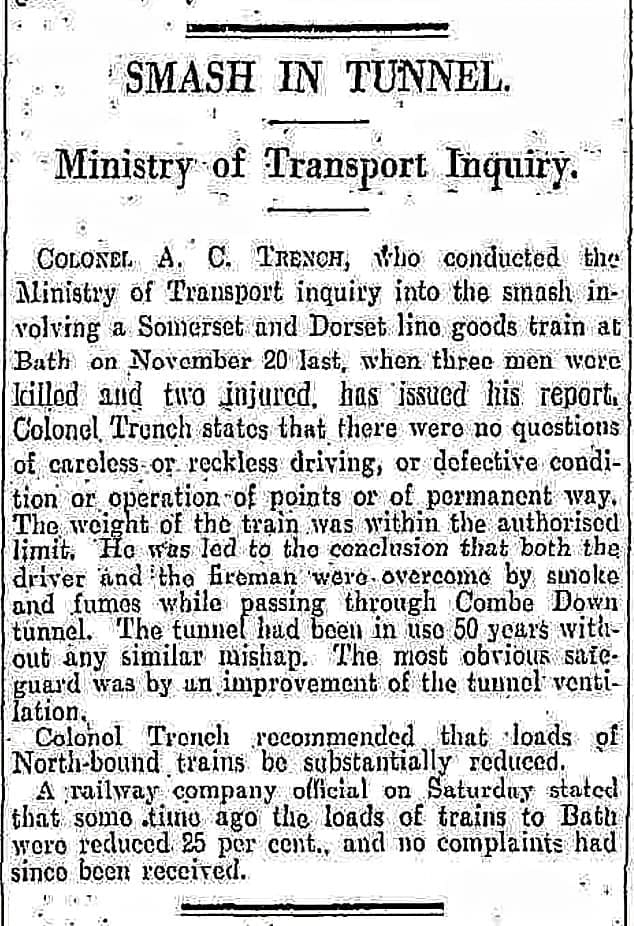
~ ~ ~ ~ ~ ~~ ~ ~ ~ ~ ~~ ~ ~ ~ ~ ~
Convalescent Home
Combe Down Convalescent Home
The Combe Down Convalescent Home was founded in 1870[35] but soon proved inadequate in size.
Many bazaars and concerts were held over a number of years to raise the money to build a larger home.
By 1880 enough money for a 12 person home had been raised, though fundraising continued. An acre of land was donated by Mr. Vaughan Jenkins of Combe Grove.[36]
The foundation stone was laid on Thursday May 27th 1880 by the Mayor of Bath[37] and was open for business in 1881.
Convalescents had come to Combe Down since the late 18th century, but the changing nature of medicine in Victorian times – more medical training and doctors, nurses and hospitals to go along with the scientific advances based on Louis Pasteur’s work on germ theory and Joseph Lister’s introduction of antiseptic processes – meant that more and more people actually survived illness and surgery and needed to convalesce.
Those with enough money wanted to do so in pleasant surroundings with trained staff. Over the years the convalescent home expanded to treat over 400 patients a year.
According to Dr David Carr the home was taken over by the RAF during WW2.
After the war it reopened as a private home for women patients but with the founding of the NHS on 5 July 1948 it began to take in post operative convalescent cases, mainly from uterine surgery, from the Birmingham area NHS.
As the NHS and medical practices progressed convalescence became less of an issue and numbers began to fall.
In the 1960s Bath Association for Disabled People were looking for somewhere to buy so that they could offer respite to carers and holidays for the disabled. They bought Combe Down Convalescent Home from the RAF and set up Combe Down Holiday Home for the Disabled.
It was not a great place to bring the disabled being a 3 storey Victorian building with doors that were too narrow for wheelchair access. The building burnt down in 1971.
Luckily it was insured and Dr Sandy Neill and like minded colleagues ensured that a modern building with all the necessary facilities for disabled access atc was built.
It had about 20 rooms and provided excellent holiday/respite care.
The home operated with success for 20 years, but changes in Local Government funding and increasing costs forced the Trustees to review the management of the home.
By the 1990s they decided to sell the home and invest the proceeds and seek a different role based on the holiday/respite care principle.
In 1993 the Trust was reconstituted as Combe Down Holiday Trust with the sole aim of providing holidays, short breaks and respite care for disabled people and/or their carers who live within the Bath & North East Somerset area.
The site was sold for development in 1996.
In 1999 Linden Homes built Quad Villas on the site.
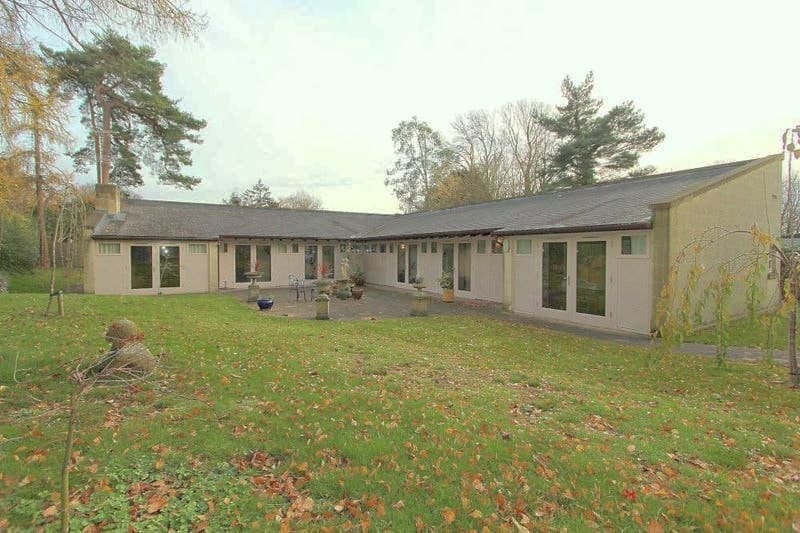
Waterworks
Combe Down Waterworks
Most people used shared wells with the well shafts passing through quarries below. The water from wells was often boiled first for use as drinking water. People also collected rainwater from their gutters, collecting it into a tank for domestic use, though not as drinking water.
Harry Patch says that:
“Apart from the wells, there were two iron water butts in Combe Down fed from the mains. When a handle was turned on the side of the butt a chain ran down over a pulley and opened a stopcock at the base, bringing water out of an ornamental lion’s mouth. One butt was just outside the church, the other opposite the pub, the Wheelwright Arms. If you didn’t have access to a well in the garden, you could draw water from there. Behind both butts was a wooden trough into which water was poured for horses to drink from.”[38]
The mains supply was from the Combe Down (Bath) and General Waterworks Company.
It had a forerunner, the Bath and District High Level Waterworks Company which had been set up in 1887 after the death of the Right Reverend Monsignor Dr. Charles Parfitt (1816 – 1886) of Midford Castle who had set up the original waterworks at Midford Springs.
Dr. Parfitt had inherited Midford Castle from Mrs. Jane Conolly (1798 – 1871), the widow of Mr. Charles Thomas Conolly (1791 – 1850) who was the son of Charles Conolly (d.1828) who had bought Midford and funded William Smith’s quarry.
Soon after taking over Dr. Parfitt started the Combe Down and District Waterworks to take water from the Midford Springs. The water was pumped by a water wheel using the water from the Whittaker springs to carry water from the Midford sands.[39]
He was soon supplying the Workhouse and Bath Town Council considered buying the waterworks.[40]
By 1883 the Rural District Council were informed that:
“Combe Down is also more largely supplied from Dr. Parfitt’s private source and many of the wells in the neighbourhood have been closed.”[41]
By February 1886 Bath Town Council had agreed to buy Combe Down and District Waterworks.[42]
A new main from Tucking mill to Entry Hill was laid,[43] and the water supply turned on.[44] #
Storage was by the Combe Down elevated tank standing opposite what is, now, the Forester & Flower. It was a cast iron tank on 8 cast iron legs with a capacity of 40,000 gallons with a roof of iron sheets.[45]
However, Dr. Parfitt became unwell and died in June before the agreement to purchase the waterworks could be completed.
When Dr. Parfitt died his trustees did not want to continue managing the waterworks[46] and a new joint stock company, the Bath and District High Level Waterworks Company Ltd., was incorporated with a capital of £20,000 in shares of £10 each.
In 1890 the Hampton Down reservoir was constructed on land leased for 99 years. It was a stone structure approximately 61’ by 20’ 6” with a capacity of 100,000 gallons.[47] The Bath and District High Level Waterworks Company Ltd. ran until 1901 but was then put into receivership.
Once again the council considered buying the waterworks but decided not to do so.[48] However in 1902 they reconsidered and took powers to purchase the concern.[49]
It was not to be. The receiver put the business up for sale as a going concern. It was bought for £7,000[50] along with the Somerset Coal Canal, which had fallen into disuse and disrepair and had complaints of being in an “insanitary state”.[51]
By 1902 a liquidator for the Somerset Coal Canal Company had been appointed.[52] The canal, as well as being an asset in its own right was to be used to supply more water to the Combe Down Waterworks Company.[53] He sold the coal canal soon after though to the GWR for their Camerton and Limpley Stoke line.[54]
Both businesses were bought by Edward Herbert Bayldon D.L., J.P. (1854 – 1912), who was High Sherriff of Devon in 1905.[55] He had interests in South African gold mines before turning his attention to Dartmoor tin mines in the late 1890s.[56]
He soon gained agreements with Bath Corporation to supply water to areas the council could not as the council was in short supply of water.[57]
In 1906 a 6” main was laid from Tucking Mill to Hampton Down.[58]
From about 1905 there was a move to close wells due to poor water quality and by 1928 the Combe Down (Bath) and General Waterworks Company Ltd. supplied 337 of the 440 houses in the parish of Monkton Combe with 53 being supplied by the Rural District Council.[59] Presumably the other 50 were still relying on wells etc.
The Hayeswood Reservoir was constructed in 1927. It was a reinforced concrete covered tank with 8’ thick walls and a 37’ diameter and held 100,000 gallons.[60]
By the 1950s the staff included a chief inspector and 3 shift workers and was pumping 268,000 gallons per day.[61]
In 1954 the Bath Corporation Water Order, under the Water Act 1945, transferred Combe Down Waterworks to Bath Corporation.
Under the Water Act 1973, the Wessex Water Authority was created in 1974. In 1989 the water boards were privatised and in May 2002 YTL Power International of Kuala Lumpur acquired Wessex Water and hence the waterworks at Tucking Mill etc.
Hospital
Bath Statutory Hospital
Many towns had some form of isolation hospital from the eighteenth century, usually a ‘pest house’, where infectious people were treated.
It was not, however, until the late nineteenth century that the formal treatment of infectious diseases, such as scarlet fever, typhoid, diphtheria, measles, tuberculosis and smallpox, was considered.
The Poor Law Amendment Act 1868 dealt briefly with the subject, since most patients with infectious diseases found their way into the workhouse infirmaries because voluntary hospitals could and did refuse to admit them.
The Public Health Act 1875 enabled any local authority to provide hospital accommodation for the treatment of patients with infectious diseases paid for by the rates.
In 1877 the Bath Statutory Hospital was established at the corner of Brassknocker Hill. By 1880 it was being used, along with the Workhouse Union Hospital, to cover a smallpox outbreak and taking 21 cases [62]
The hospital occupied a site of about 8 acres near the top of Brassknocker Hill. A house and a gardener’s cottage were purchased in 1876. The first patient was admitted in October 1876 suffering from scarlet fever. Two small and two large wooden pavilions were added on the south side of the house providing a total hospital accommodation for 70 patients together and some resident staff. By 1877 it had three large wooden blocks for patients, an administration block, a small discharging block, a laundry and a cottage.[63]
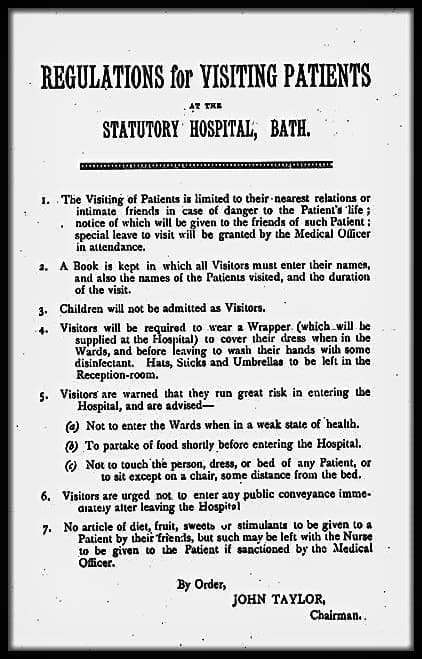
In 1930 work started on a new hospital in two phases. In 1931 the new hospital was first used and in 1932 the new purpose built hospital was officially opened on the site as the old hospital had:
“woodwork that was seen to be perishing and...lighting…of a very inferior order…Fifty years ago they were expected as a temporary expedient by Mr. Charles Wibley. They were erected in a panic, and in a piecemeal and temporary fashion, and the amazing thing is that the hospital has done such good work over such a long period.”[64]
The second stage was opened in 1934.
In the early days, admissions were largely for cases of scarlet fever and diphtheria. Between 1895 and 1899, there was annual average admission rate of 137 of which 78% were patients with scarlet fever and 22% diphtheria. Only 7 out of 137 were for other conditions, for example smallpox. Before 1900, many doctors did not always insist on admission of infectious cases to the hospital but attitudes changed in the early twentieth century. Between 1895 and 1900, only 41% of known diphtheria cases were admitted whereas between 1940 and 1945, 97% were removed from home to hospital.
The development of antibiotics – sulphonamides became available in 1935, penicillin in 1944 and streptomycin in 1947 – led to the closure of many isolation hospitals soon after the Second World War but the Bath Statutory Hospital was taken over by the NHS in 1948 and renamed Claverton Down Hospital. For some years it continued in its role as an infectious diseases hospital and treated many children with polio during the epidemics of the early post war years. The hospital purchased a number of Drinker respirators, popularly known as iron lungs. After the introduction of polio vaccination, there were no further cases fell the artificial respirators were removed.
Bath Statutory Hospital became associated more with chest infections and convalescence and closed in 1986. The site lay derelict until 1997 when Wessex Water acquired the site.
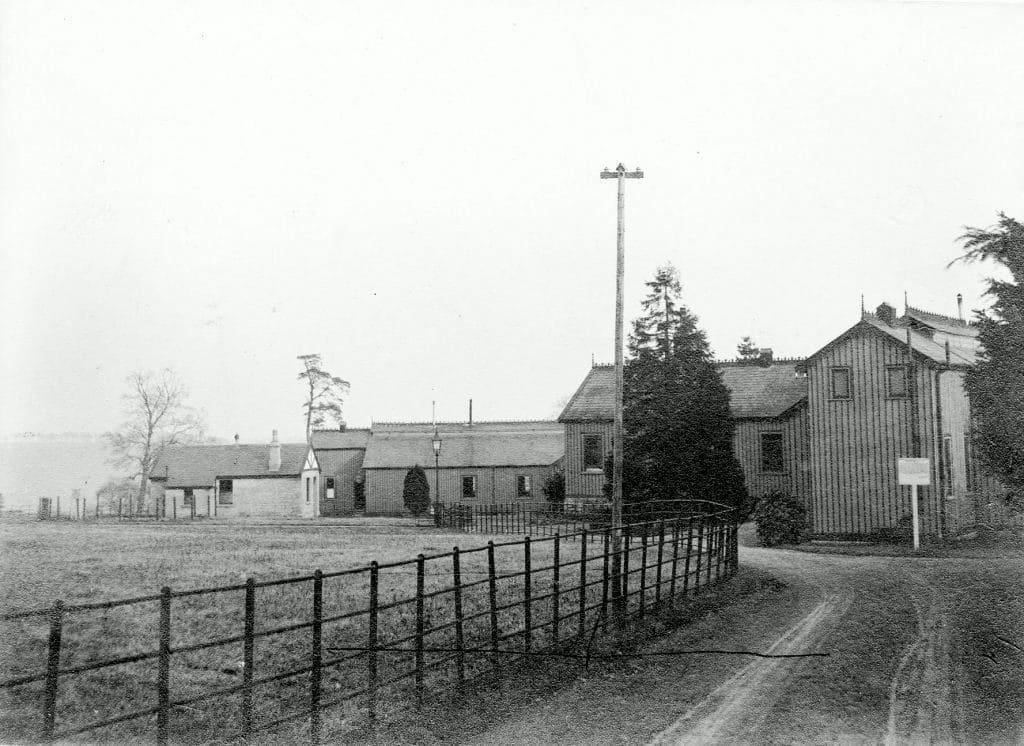


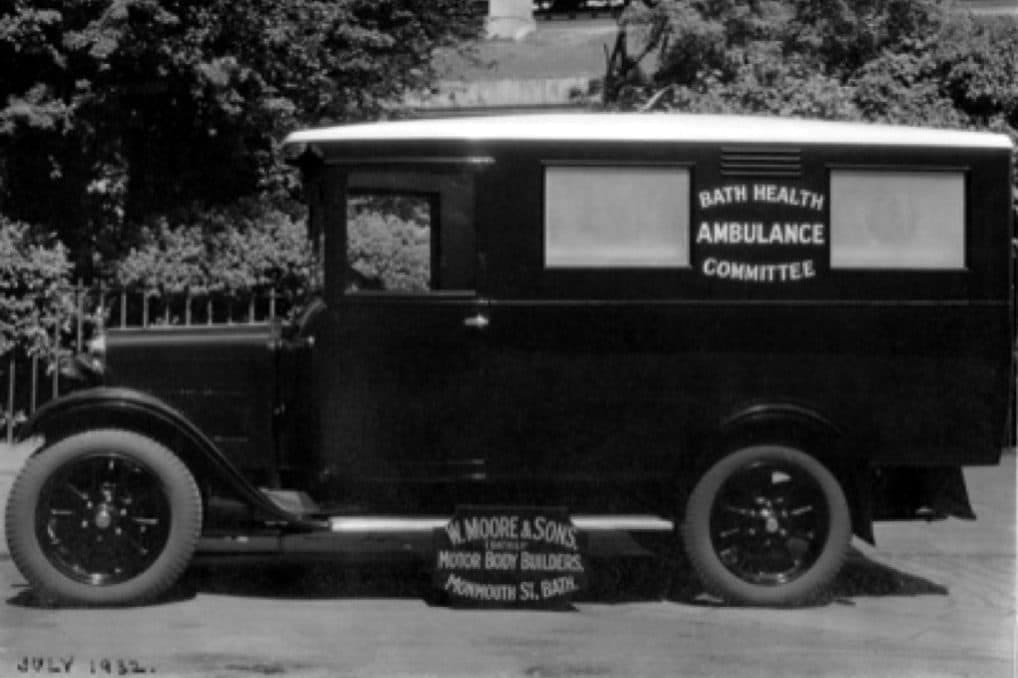




Monkton Mill
Monkton Combe Mill

Monkton Combe has two mills listed in the Domesday Book – Monkton Combe Mill and Tucking Mill. Beside the Midford Brook there are sluice gates and a millpond for the Monkton Combe mill.
From at least 1884[67a] it was owned by the Freeman family, who also had mills at Freshford and Avoncliff.
It was run by Thomas Richard Freeman (1860 – 1920) and later his sons Charles Henry (1889 – 1947) and Thomas Leonard (1892 – 1947).
The Freshford and Avoncliff mills were run by his brother William Osbourne Freeman (1855 – 1913), who seems to have been a poor business man as he was bankrupted in 1897, owing his brother and his brother’s wife – Sarah Ann Mountstevens (1860 – 1947) – £700 between them as well as loans from a money lender at 40%[67b].
The mill at Monkton Combe was by the station and used the railways to to import the raw material of old clothes from the rag and bone trade.
This was turned into flock, from the Latin floccus meaning lock or tuft of wool, for use in the upholstery trade stuffing mattresses, sofas, pillows, bolsters and other furniture items.
Water power drove the turbine operating the “devils” which broke up the rags.

Reports to The Local Government Board Reports on Rag-Flock, HMSO, 1910 describes the process:
"Rags may be imported in bales from abroad or collected in this country. In this country rags are bought by rag and bone men from private houses. They may also be collected by rag-pickers from the roads and streets, from city refuse heaps, or wherever they can be found. Generally, they are sold by the rag-pickers or rag and bone man to the small marine store dealer, and by him to the wholesale rag merchant, by whom they are sorted into grades, particular grades being sold to the flock manufacturer...Disinfection of rags before sorting appears never to be done...Linen and cotton rags are sold for the manufacture of paper; woollen and mixed rags for that of shoddy, and of flock...Rags of mixed wool and cotton...are subjected to a process called ‘carbonizing’ for the purpose of extracting the wool...In the wet way the rags are steeped in sulphuric acid somewhat diluted, at a temperature of 160 - 190° F., then rinsed in water and dried in a stove. In the dry way the rags, spread out on racks, are heated for some hours in a stove in an atmosphere of hydrochloric acid gas, evolved by pouring sulphuric acid on common salt in an iron retort, or by heating the crude hydrochloric acid...By one or other of these processes the cotton fibre is destroyed, being converted into a powdery matter, probably glucose, which flies off as dust when the rags are beaten, but the wool, being unaffected by the acid, remains, and undergoes further processes for conversion into shoddy...the parts of garments which are used for flock by the shoddy-maker are just those parts which are most liable to harbour excremental and other filth, vermin, and parasites...is only exceptionally washed or cleansed...the lowest and cheapest grade of rags, sometimes known technically as “lanns” because it used to be cast on the land as manure...difficult to exaggerate in describing the filthy nature of the above material...Old trousers, often badly stained with urine and faeces, are among the commonest of the articles which I have seen passed unwashed into the tearing-machine in many flock factories...Several foremen and workpeople who have been many years in the trade have assured me that they have not infrequently seen surgical bandages and dressings and even sometimes stained ‘‘towels” torn up unwashed for flock...The tearing-machine used in the manufacture of flock is known in the trade as a "devil”. In this machine the rags are passed on an endless band into the grip of fluted steel rollers which hold them under the teeth of a rapidly revolving wooden cylinder studded with steel nails. The torn flock falls out at the other end of the machine, and the dust is sucked out by a fan. The number of teeth on the cylinder varies in different specimens; I have seen from 9,000 to 16,000. The cylinder revolves at a rate of about 700 revolutions a minute...into which the torn fiock is drawn by suction and willowed to remove the dust...To reduce the loss by dust...manufacturers employ oil, which is allowed to trickle from a can over the feed of the machine, while some even work up the rags with the oily waste from tanyards for the same purpose..."
It was not a pleasant process and there were frequently fires[67c]. After Charles Henry and Thomas Leonard Freeman died, in 1947, within a month of each other and only a month or so after their mother, and, with more modern bedding becoming preferred, the mill was put up for sale in 1951. Eventually it was turned into retail premises.

Combe Down School
Combe Down School
Combe Down School was founded by William Franklin (1852 – 1921) in 1886. Based on the 1891 census the school was in 2 properties (Combe Villa, which is now Scott House, and Southfield Villa) and had 40 pupils, 4 assistants, a butcher, school matron, 2 domestic servants and a pantry boy as well as William and Emily Franklin and her daughter and grand daughter.
Combe Down School moved to Weston super Mare in 1896, having grown too large for Combe Down, and was renamed Clarence School.
The purpose built buildings were in Clarence Park South.
In 1923 Clarence School with its headmaster and 100 boys moved away from Weston to Wimborne, becoming Canford School.
This was orchestrated by Rev Percy Ewart Warrington, Vicar of Monkton Combe from 1918 – 1961. He was “the world’s greatest schoolmaker”, though his machinations were to end in tears.
There is a good description of the development of the school in an article written for Old Canfordian by Richard Knott in 2012:
William was a member of the Plymouth Brethren by the time he arrived at Monkton. There is some evidence that Emily’s family were as well, so William may have converted after he met her, but the Brethren had been based in Bath since at least 1837. Willie Ball-Acton, sadly to die of meningitis after only one term as a pupil at Monkton Combe, gives us a glimpse of William Franklin in his letters home. One of only five or six masters at the school, Franklin was described as ‘a very good master and teaches excellently’. Willie had been promoted from the third form where discipline was lax and ‘you could hardly learn anything there as the master is not very good; he talks about punishing but never does hardly. Franklin is very strict, but it is a good thing’. Although William was fully part of the school when, in 1886, he took the decision to leave the security of Monkton and set up his own school, many at Monkton were pleased that the school had lost its non-conformist element. William named his new establishment Combe Down School, despite there being a primary school of the same name in the village. Within five years, it had over forty pupils from across the globe. At least four other teachers lived in the school, including the obligatory French master, and there were others who did not live in. In around 1893 Emily’s younger sister, Isabel, sent three of her sons to Combe Down School, a significant decision for Canford as it turned out. Isabelhad married George Macnutt, an Irish-Canadian whose family were important members of the Prince Edward Island community. George was a polymath who had arrived in England as a Baptist minister but immediately set about training as a doctor. He had two children in different parts of Canada, then eight more as he moved from Islington to Brighton, the Isle of Wight, Wimbledon and then Barnet, where John Stewart Macnutt, destined to be Canford’s first headmaster, was born in 1880. William Franklin decided that the school had outgrown its present site and needed to move. Weston-Super-Mare had grown from a tiny village at the start of the century to a thriving seaside resort. Several private schools were being set up there as it became fashionable to send= children to seaside boarding schools. In 1895, Combe Down School moved into large buildings overlooking Clarence Park, which had opened only yards from the sea in 1888, and was renamed Clarence School. Like all other schools on the coast, Franklin’s prospectus made much of the healthy air and its benefits for delicate children. The school was, he said, ‘open to the invigorating breezes of the Atlantic. The air, impregnated with iodine and ozone is pure and bracing and less humid than that of most seaside places’. Franklin’s public ambitions for the school seemed modest: even twenty years later the school prospectus said that with ‘... Protestant and Evangelical principles there is every prospect that the school will continue to grow till, in time, it takes rank among the smaller public schools of the country’, and preparing pupils for entrance to other, more prestigious schools was included in their advertising. Clarence School was genuinely comprehensive: a number of bright pupils left for more academic schools, but many others remained. Although religious teaching was advertised as ‘strictly scriptural and evangelical’, it was also stated that ‘Pupils attend Church of England or Non-conformist services as desired by parents.’ The result was that on Sundays, two crocodiles of boys made their way to church, one moving towards the Plymouth Brethren assembly and one to Holy Trinity church. As the First World War started, there were just over eighty boys in the senior school and twenty more in the prep department. The Clarencian records the names of 62 former pupils who volunteered to fight as war broke out, many of whom were amongst the 56 on the memorial stone that was later unveiled for the OCs who had lost their lives. As the war ended, Franklin’s ‘lifelong bodily weakness and suffering’ was becoming more of a problem. The school had been made into a company in 1913, with a small board of directors overseeing operations, and Macnutt was now the joint principal and presumably doing the lion’s share of the work. Franklin died on 14th June 1921 and eighteen months later, his wife, Emily, followed him. His obituary said that, although there had been a ‘touch of the austere’ about him, he had mellowed in old age. His legacy is, of course, Canford School. The links between Combe Down School and Clarence School were clear, with the latter including the former’s name in its prospectus, and pupils from both considering themselves as part of a common past. The same was essentially true when the school moved to Canford: the pupils, staff and motto were much the same, and the first Canfordian suggested that it was a relocation rather than a new birth. In smaller ways, too, continuity was assumed: the sports calendar listed some who had been awarded rugby colours from 1921 to 1923, including therefore their time at Clarence and Canford. Why, then, did we not celebrate the 125th anniversary of the school in 2011? Michael Rathbone asks and answers this question in his history: Canford was intended to be a different type of school. Clarence was a private, proprietary school, but Canford was to join the ranks of the public schools. It has certainly done that but, when the centenary is celebrated in 2023, let us not forget the two men who had spent nearly forty years preparing the way for its birth."
Magdalen Hospital School
Magdalen Hospital School at Rockhall
Around 1100 a deed of gift was made by Walter Hosat, who gave his house and the Chapel of the Blessed Mary Magdalene at ‘Holeweye’ to the Abbey Church of St Peter, Bath. Its isolation, 500 yards from the city walls and across the River Avon, was an ideal location.
It is said that in 1212 Hugh, Bishop of Lincoln, made a bequest to the lepers outside Bath and a small hospital for lepers was founded close to the Chapel to be cared for by the Abbey’s monks. An undated deed in the Bath Cartulary records a grant of land by John Wyssy to the master, brethren and sisters on condition that their chaplains should celebrate in his private chapel at Bath. Bishop Ralph in 1332 granted an indulgence to those who supported the hospital of Holy Cross and St. Mary Magdalen at Bath, and it occurs from time to time as the recipient of legacies.[68]
Bath waters were still attracting lepers in the 16th century. Although leprosy was no longer prevalent, those who contracted it came to Bath in search of a cure by the waters. John Cantlow, Prior of Bath, petitioned the Pope in 1486 to unite the hospital of St Mary Magdalen to Bath Priory. The hospital was ruinous, impoverished and in debt. No brothers were living there and only two or three poor people. Prior Cantlow promised that he would repair its buildings and did so. Bath Priory was dissolved in 1539 and the hospital hospital survived the Reformation. However the Master, Simon Sheppard, took the revenues and provided no support. An investigation into these abuses in occurred in 1559 and by 1560 there was a bequest to the poor lazar people of St Mary Madgalen.
But leprosy was dying out and the hospital building was demolished in the 18th century, by which time St Mary Madgalen itself had become a home for the mentally handicapped and its endowments were being diverted from their original purpose.[69]
In 1856 ‘A Bill Intituled an Act for Confirming a Scheme of the Charity Commissioners for Saint Mary Magdalen Hospital Near Bath’ was passed and the Bath Municipal Charity Trustees took over.[70]
In 1846 Harriette Helen White (1820 – 1889), the third wife of the Rev George William Newnham (1806 – 1893) who was perpetual curate of Combe Down from 1842 – 1877, had set up a school for mentally deficient children with her sister Charlotte, inspired by the work of Johann Jakob Guggenbühl.
It opened in April 1846 in two rooms with a resident matron and three pupils. It was unique amongst the Idiot Asylums in being managed by women.
In 1849 this became the Institution for Idiot Children and those of Weak Intellect, which later moved from 5 Walcot Parade to 35 Belvedere and then, in March 1887 to Rockhall House[71] which had been built by quarry master Philip Nowell (1780 – 1853).
By 1891 it was renamed as Magdalen Hospital School for Idiot and Imbecile Children having been merged with St. Mary Magdalen Hospital under the Bath Municipal Charity Trustees. It was later known as Rockhall House School which then became part of the NHS and closed in 1980 and Rockhall House became sheltered housing.
Fullers Earth
Fuller’s Earth Company
There is evidence of Fuller’s earth mining in the Bath area from Roman times.[72]
Fuller’s earth resembles clay but is actually an absorbent silicate, mostly composed of silica, magnesium, iron, and aluminium. It has been used (and still is with many other modern uses as well) for thousands of years to absorb dirt and oil.
The name comes from its use in cleaning wool, when a fuller or tucker would pound the woollen cloth to remove dirt and oils before the cloth was finished. The words tucker and tucking come from the old English tūcian ‘to punish or ill-treat’.
So Tucking Mill shows that the presence of Fuller’s earth was well known in the area.
By the 1880s Tucking Mill was leased by George Dames and his brother Charles Richard Dames from the Midford Castle estate and had opened a mine and processing works for Fuller’s earth. The mines extended nearly 20 acres (8.1 ha) through four adits.[73]
In 1884 an explosion burst a tank, but in 1885 at the International Inventions Exhibition held in South Kensington they won a bronze award for improvements in the preparation of Fullers’’ earth.[74] However it seems that the explosion had probably cost them more than they admitted and by December 1885 the company was in liquidation and up for auction.
It was purchased by Henry Newson Garrett. He was the son of Richard Garrett IV (1829 – 1884) proprietor of Leiston Works in Suffolk, which was established in the year 1778 as an iron foundry, sickle and general agricultural implement manufactory.[75]
He was left his father’s firm in 1878. Henry Newson Garrett (1841 – 1912) also became a director of the City of Bath Electrical Lighting and Engineering Company[76] set up in 1891 to run the public lighting under a contract with the corporation.
He was married twice and had ten children. His first wife died in 1900 and he remarried in 1907. In the meantime he had taken as his mistress Miss Alice Mary Sauvarin, who was a nurse; they had met in September 1904 and had an affair until September 1905.
He had introduced his son Alec to her as a patient in September 1906. On Friday 1st April 1907 Alec Garrett and Mary Sauvarin married.
They went to Weston super Mare for 2 days honeymoon. On 5th April he disappeared. His body was found at on 2nd May in the river Avon at Kensington Meadows.
At the coroners inquest there was conflicting evidence about whether his father wanted him to marry or did not. A verdict of suicide was returned.[77]
Some months after Alec Garrett’s death his father was in court asking for £200 from a £500 life policy that he had paid for on his son, the proceeds of which had been paid to his estate, which was administered by his wife, after he died. He lost and the judge was really quite vicious:
Institute
Combe Down Institute and Combe Down Rugby Football Club
In 1896 there was a proposal to form the Combe Down Institute.[78] Church and other institutes were popular as they brought wholesome entertainment and sport to an area.
The Institute at Combe Down was formed and a (rugby) football section started. It seems likely that Combe Down RFC evolved from Combe Down Institute. By 1902 it appears in the letters of the Bath Chronicle.
At the AGM at the Church Rooms (at that time in Tyning Road) for 1904 it was stated that they were to play in green and white hoops, income was £31 15s 9d, expenditure £19 13s 5½d thus leaving a surplus of £12 12s 3½d. There were new players including H. Shore, a Welsh half back, and the club had “rosy prospects”.[79] The colours of black and amber for the club were adopted in 1907.[80]
All seems to have gone well for some years, but something went wrong as a new club, was formed to replace the old club, which had “never been properly dissolved”, in 1912.[81] Quite what the issue was I have not established though it sounds like finance was part of the problem.
The First World War interrupted things and after the war the club was revived.[82] Combe Down RFC still, of course, exists in 2014. In 1957 a long-held ambition was realized and the club was able to buy the ground at Holly’s Corner which it had tenanted since 1922. In 1966, The Combe Down RFC Club house was officially opened.[83]
Did he murder her?
At the Court House, Weston, on Monday, Frederick Mitchell, of Monckton Coombe, was brought up before Mr. J. Butler and Capt. Sainsbury, having been apprehended on Saturday afternoon by Supt. Morgan, on a charge of the wilful murder of his wife, Martha Mitchell, aged 56.
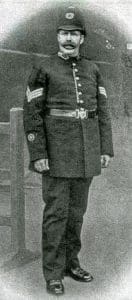
The accused, who is a respectable looking man of 66, did not seem to realise the gravity of his position.
The main facts of the case were elicited at the inquest on Saturday week. It was stated by Mr. Fisher, a farmer, and brother of deceased, prisoner led a drunken life, and was often in a state bordering on insanity from that cause. Prisoner frequently threatened to take the life of deceased, and after being left alone with her for a brief period on the Sunday previous to her death on the Thursday he WWI he bad given “white powder.”
Nothing was thought of these circumstances till Mr. George E. Lawrence, the medical man in attendance, discovered symptoms which led him to inform the family that an irritant poison had been administered.
At the inquest Mr. Lawrence said he had never ordered the deceased to take any white medicine, and at the time the – husband said he had given her a dose he had directed that all medicine should be stopped.
The inquest was adjourned for the purpose of an analysis of the stomach, and having been ascertained that Mr. Gatehouse, the public analyst of Bath, to whom the analysis was entrusted, had detected arsenic in the intestines, the prisoner was arrested. Several witnesses having been called the prisoner was remanded until Monday next at Shepton Mallet.
SUSPICIOUS DEATH AT COMBE DOWN.
Mr. S. Craddock, coroner for North Somerset, opened an inquest at Combe-down, on Saturday afternoon, on body of Martha Mitchell, wife of Frederick Mitchell grocer and fly proprietor.
The coroner said that he appeared there that day on account of his deputy and friend, Mr. Biggs, being about to take a holiday. He came knowing nothing of the case, except what was conveyed in the formal information he had received from the police, and which stated that Mr. Lawrence, the surgeon in attendance, was unable to account for the cause of death. Under these circumstances he telegraphed to have a postmortem examination made, and he hoped that the matter would be elucidated to their satisfaction.
Charles Fisher, farmer, of Prior-park farm, stated that the deceased was his sister. She was the wife of Frederick Mitchell, a grocer and cab and omnibus proprietor, living at Combe-down. Heard Saturday last that his sifter was very ill, and he went to see her. Subsequently till her death he saw her daily two or three times. She complained of painful symptoms in the chest. Was at the house on Sunday evening. After seeing deceased, witness left the room with some friends and relatives, and proceeded downstairs to partake of tea. After staying a few minutes, it struck him that deceased ought not to be left alone with her husband, as he was very tantalising at times, and witness thought he might fatigue her. The husband of deceased had been in the habit of tantalising her, and to the knowledge of witness he had been at times very unkind to the deceased.
The coroner: In what way?
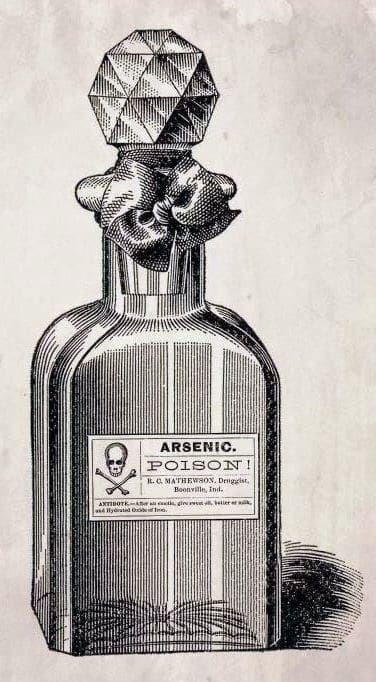
Witness: Am I bound to tell you?
The coroner: Yes.
Witness: He has cursed and sworn at her and threatened her.
The coroner: In your presence
Witness: He has cursed her in my presence but has never threatened to take her life.
The coroner: Can you bring forward evidence that he has threatened her?
Witness: Yes, my sisters and her daughters have heard him.
The coroner: Have you any reason to suspect that there was anything unfair in your sister’s last illness.
Witness: Yes. On Sunday morning I was my sister’s house, when Mr. Lawrence and Dr. Coates came to see deceased. I asked Dr. Coates if there was a chance of deceased getting over it, and he said there was just a chance.
The coroner: Have you any reason to suspect that her death occurred from other than natural causes?
Witness: I fancy I have.
The coroner: You have reason to believe that deceased did not come to her death natural means.
Witness: That is my opinion.
The coroner: What are your reasons for that opinion?
Witness: When we left her room to come down to tea, we left the husband in the room. Witness remarked to others present that he thought somebody else ought to be there. Someone present remarked that the nurse was there, but this proved incorrect. The nurse soon afterwards went to the room of the deceased, and the husband came down immediately.

He soon afterwards remarked, “I have given her the medicine.” Witness remarked, “How strange, when the medical men said she was to have nothing till they came the evening.” One the women present said, ” What medicine did you give her, and he replied, ” Something white out bottle.” The subject then dropped, and witness thought nothing further of the matter till he heard of the suspicions of the medical men. On the following day deceased was suffering from burning in the chest, and on his being asked if that was a good sign, he replied that it was not. He did not mention the fact of the husband giving her medicine till Mr. Lawrence intimated to him that he could not account for the symptoms.
A juryman: It has been rumoured that Mr. Mitchell has not been sound in his mind.
Witness: It has been at times.
The coroner: Do you think he was unsound in his mind at this time. Did he drink?
Witness: He did at times, and when he gave way to drink, he was practically unsound in his mind.
Deceased died at half-past five on Thursday morning. Mr. G. E. Lawrence, surgeon, stated that he was called to see the deceased on Friday week. She was suffering from vomiting and diarrhoea. Saw deceased on Sunday in consultation with Dr. Coates. Considered her a trifle better. As the vomiting was incessant all medicine was ordered to be stopped, and only ice and champagne administered, and other remedies to be taken.
Saw deceased three or four times on Monday, and from the symptoms which then appeared, he thought it possible that some irritant poison might have been administered. On the Tuesday he was of the same opinion, and he requested to have Dr. Falconer consultation.
At this time deceased was very collapsed and was suffering at intervals from intense abdominal spasms. Dr. Falconer was likewise suspicious an irritant poison, and on Wednesday Dr. Falconer saw her again with witness. The symptoms were worse, and the pains increasing. Deceased died at half-past five on the following morning. A few hours subsequent to her death witness made a postmortem examination. All the organs the chest were healthy, and in the abdomen he found nothing that would satisfactorily account for death.

The intestines, which he did not fully examine, an analysis had been ordered, were internally congested. All the other organs were healthy. The stomach, liver, and intestines were removed and placed in three jars, under the direction of Dr. Falconer and himself.
The coroner: Is that all you have to say?
Witness: There is one remark I should like to make. I never ordered any white medicine, and as far as I know there was no white medicine given her.
The coroner: What made you suspect that deceased was suffering from an irritant poison?
Witness: Her symptoms were quite consistent with it. During the last two years I have been constantly appealed to by deceased and members of the family in reference to the constant violence of the husband of deceased. Some months ago, his conduct was such that arrangements were commenced with a view of confining him in asylum. Immediately before the husband admitted given her the white medicine deceased was better.
The coroner: Were the symptoms of deceased inconsistent with natural disease?
Witness: They were not, so far, my experience goes, inconsistent with English cholera. I have only seen two or three cases.
A juryman: Would not Mrs. Mitchell have known if anything wrong had been administered?
Witness: No, she was in too great a state of collapse.
By the Coroner: The medicine I gave her would not in the quantities taken amount to an irritant poison.
The coroner: It is utterly impossible to close this case to-day. have taken it up and suspicion has been aroused, and we must sift the matter thoroughly. We must adjourn to have the intestines thoroughly examined by an analytical chemist. The jar containing the intestines must be handed over to the superintendent of police. Mr. Gatehouse, the city of Bath public analyst, having been selected to conduct the examination, the inquiry was adjourned.
THE ALLEGED MURDER ON COMBE DOWN. MAGISTERIAL EXAMINATION.
Frederick Mitchell was brought up, for the fourth time, at the Court House, Weston, on Monday, to answer the charge of the wilful murder his wife, Martha Mitchell, July last. The magistrate present was Mr. S. Butler. Mrs. Barry (sister of the deceased) having recovered from her recent remarkable illness, was court. Mr. H. R. Hodson appeared for the accused.
Mr. J. W. Gatehouse, public analyst of Bath, was recalled for cross-examination, but no fresh fact was elicited. In reply to the magistrate, the witness stated that any kind of salt of copper would give results similar to those he found. Aromatic vinegar, containing Verdigris, could not now be purchased.

Mrs. Barry was then recalled, and the Clerk read to her the evidence she gave on a former occasion. On re-examination, she said: The night-dress produced (containing stains) is the one I took off the deceased on the Tuesday before her death. That was the only time changed her night-dress. I took charge of the sick room on the Saturday, and the deceased was then wearing the nightdress produced, and continued doing so until the Tuesday spoken of. I cannot say whether the green stains upon the night-dress were there on the Saturday; I first observed stains on the sheets on the Monday after Mr. Lawrence had mentioned his suspicions to me. ‘I the sheets are also used upon the bed in which the deceased was taken ill and were placed upon the bed the daughters’ room, when my sister was removed there. I cannot say if they were not, there then. On the Wednesday, when I went up to my sister’s room, the prisoner was violent, and had the appearance of having drinking. I don’t think he knew what he was about. When he broke the candlestick pieces, I don’t think he was accountable for his actions. looked upon him for some months
Mr.: Don’t say that.
Witness: The accused at the time I speak of seemed like man “off his head.” He said things without any sense or reason perfectly ridiculous. One the thing 3 he said was how much better he might have married. She had been ill for some weeks before, complaining of a burning in the stomach and bad taste in her mouth. I was distressed to see her look so ill.
The Magistrate Do you think that she so overworked herself by her distress that she took poison?
Witness: Never; she was too conscientious a person to do it. She had too much love for her children and husband too.
Mr. Butler: You see when the balance thrown over, we are poor creatures. Did you never see anything that would lead you to suppose she committed such act?
Witness: Not the slightest.
The Clerk: Was the prisoner like rational man at all on the Wednesday? — I don’t think there was an interval on the whole of the Wednesday.
By the Magistrate: Mrs. Head, the nurse, was known to the family, and was there with their approval. There was nothing unsafe in the room. There were no copper cooking utensils in the house. She said during her illness several times ” What can this illness mean What can it mean?’
One evening before her illness, I was bidding her goodbye, and said “My dear sister, how ill you look. I wish I could take you out of this.” The deceased made no reply, but the prisoner, who was present, said ” You may take the lot if you like.
On the Wednesday before she died the fellow was on one side of the bed.
Mr. Hodson (warmly): What did you say?
Witness: The prisoner was on one side of the bed.
Mr. Hodson: No, you said “fellow,” did you not?
Witness: I did. .
Mr. Hodson (to the clerk): Take that down.
Witness proceeded to say: The prisoner was by the side of the bed, and the nurse and I were in the room. The deceased was in great agonies and said to me “Don’t leave me. Do take me out of this. The prisoner remarked “Yes, you shall soon be taken out of this, and have a ride down the hill,” and laughed.
The Magistrate: What do you understand by the phrase “down the hill?” ….. ~
Witness: The cemetery, which is down the full, the night before or after the remarks I have just mentioned, I saw the prisoner come outside his door, and towards the room where I was, sitting up with the deceased. He put his hand against the wall and made a stride and paused. He afterwards made another stride and came right to the door. I was terrified and awoke my niece. She sat in bed, and motioned him to return, and he went back.
The Magistrate: There is nothing remarkable that.
Witness: It was the stealthy manner which he came.
The Magistrate: The nurse was indebted to family. I could not get her to obey me. Did the nurse seem in any way to favour the prisoner more than the rest of the family? -I think so.
Am I to understand he made a friend of her?
—Yea, sir. I could not get her obey me in the sickroom. could not keep anything in the room for use, and when wanted it had to fetch it.
In fact, all you say is that her conduct was not such as to satisfy you? — it did not satisfy me at all.
Mr. J Lawrence told me to keep the things my poor sister died in. I put them down and told her not to take them away. Whilst I was doing something, she whipped them away, and when looked out of the window, she was carrying them to her house. I called out to her to bring them back, when she dropped them in the garden path, and I had to fetch them.
Cross-examined
Mr. Hodson: I have been ill. was so a week before the death of the deceased, when I was with her. I was taken ill half-an-hour after I returned home from giving evidence here on the 13th of August.
The symptoms of your illness were diarrhoea and vomiting. — Mr. King said poisoning.
Answer the question, were you suffering from diarrhoea and vomiting? — Yes, sir. Those were the symptoms.

Were they identical with the symptoms from which your sister, Mrs. Mitchell, suffered? — identical.
Do you know whether Mr. King made analysis, so as to state, if necessary, what the symptoms were
— Yes. He analysed for arsenic.
Don’t tell us that. He made an analysis.
— Yea The deceased came to my house on the Tuesday before she was taken ill but did not dine there. I don’t think she took any refreshment all. She was then complaining about her condition.
Mr. Hodson: May I infer from your manner and tone to-day that you have a strong animus and feeling against the prisoner.
Witness: have.
The Magistrate: You can qualify that if you like.
Witness: I feel like this; he has treated my sister very badly and was always threatening what he would do. What other conclusion can I come to? What other feeling can I have?
Mr. Hodson: That is an argument. How long has this feeling on your part existed? May I ask whether for the last ten years you have entertained a strong hostile feeling against the prisoner?
— Not at all. I never had any hostile feeling against him. I considered during the last two years that he was nothing but a lunatic.
May I ask if you have had for the last two years strong feeling against him?
— l have not had a strong feeling against him. I cannot say that.
But you told me you had a strong animus against him?
— I had a strong feeling that he treated my sister ill.
You had no friendly feeling towards him?
— No friendly feeling, still I haven’t showed him
— I am not asking what you showed, but what your feelings were.
— Of course, could not have very good feeling towards him, but I could not say I had any revenge against him.
May I take it since your sister’s death that feeling has been intensified?
— Since my illness (after a pause) I can scarcely coincide with your remark about having these feelings towards him. I considered him lunatic, and I treated him such. When he has said anything, I have not replied.
Mr. Hodson: I did not say you did. I make no imputation against you. You cannot say that when he made the remark about going down the hill, he did not mean that he hoped his wife would soon get well that he could take her for drive to Bath.
— I cannot tell. How is that you did not, you have got such a wonderful memory, on the 13th August, state what you have told us to-day?

— ln the first place, I was not well, and I had to undergo a long examination, and I said what I could think of. I have not made inquiries as to the nature of the evidence given before the magistrates and at the inquest since, my illness.
Portions of the proceedings have been read to me from the newspapers, but not much. Mr. Lawrence, surgeon, was recalled, at the request of Mr. Hodson, and stated that he could not swear whether he had in his possession any bottles of medicine taken from Mitchell’s house when the deceased died.
The boy, Albeit Burnell, was also recalled, and spoke to the prisoner’s drinking habits. The witness also said he had seen the prisoner good many times at the house of the nurse talking to her.
The prisoner was then remanded until Monday next, at 11 o’clock.
INQUEST — FOURTH DAY. — VERDICT.
The coroner’s inquiry was resumed on Tuesday the Hadley Aims, before Mr. S. Craddock. Mr. H. E. Hodson again appeared for the husband of the deceased.
Eliza, wife of James Head, quarryman, in her evidence, said that on Tuesday, before her death, deceased said “What can it be, Eliza?” I said, “Did you ever feel like this before, Mrs. Mitchell?” She replied “No, I never did.” Dr. Falconer and Air. Lawrence came to see her again, on Tuesday, but was not in the room. the following morning, she was still worse the sickness and diarrhoea were not great, but she was weaker in herself, and said all the doctors in the world would not save her. She continued to get worse during Wednesday night. I left the house about ten o’clock that night by request of Miss Annie Mitchell. I had said I should like to see the last of Mrs. Mitchell, having known her many years, but she said it was a custom of Roman Catholics tint the relatives only should be present, and I then went. From the Friday, when I was first called to the deceased, to the Wednesday night previous her death, Mrs. Barry and myself nursed her entirely. We both stayed with her night and day. Her daughters also sat up well. I put a clean night-gown upon the deceased the day I went there, and another on the Wednesday, the day before she died.
I do not recollect seeing any green spot upon either of them. If there had been any, I think I should have seen them. I recognize the night-dress produced by the analyst as being the one I put on on the Friday. The stains upon the left side of the neck are those of beef tea spilt upon it by Miss Julia Mitchell when giving her mother the tea. I did not notice the green stains now pointed out to me. My attention was never called to these stains whilst I was in attendance. They were not there when I put the night-dress, which was clean one, on the deceased. I did not notice any stains upon the sheet. never noticed in the bedroom any medicine bottle containing a green liquid; if there had been, I should have seen it. I laid the deceased out, being called about half-past five on Thursday morning.
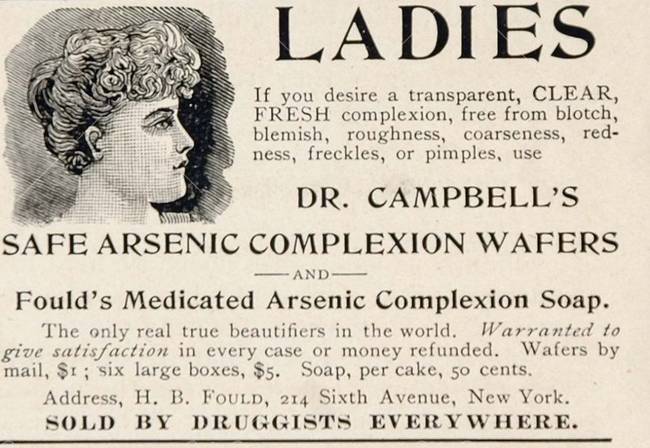
Mrs. Barry arranged the bed clothes. I was taking the sheet and the deceased’s under garment away when Mrs. Barry, who seemed angry, called out to me not to do so, and dropped them upon the grass. She had previously said nothing to me about taking things away. Her husband saw her five- or six-times day when she was first taken ill. He was very anxious about her. He would ask to see her, but he was not allowed. He continually asked me if Mr. Lawrence’s medicine was doing her good, and whether it had abated the sickness, and told me to get her anything she required. During the latter part of the illness, he saw her two- or three-times day. He was not allowed to see her more because she was to be kept quiet.
Did he ever see her alone during the time she was ill?
— No, I cannot say that he did. I never left him alone with the deceased. They disagreed sometimes, but he was very kind during her illness, and appeared anxious that she should live. said he should miss every hair of her head. I have heard them quarrel many times, but never knew him to threaten her life. The deceased never helped herself to any medicine or food during her illness, being too ill to do so. Deceased never suggested to me that she was taking anything which was given to her unfairly. Remembered on the Sunday evening Mrs. Barry and Mrs. Hill going downstairs tea. Her husband did not give her anything.
Had not heard the evidence of Mrs. Hill, wherein one said she saw downstairs.
The coroner: Then I will read it to you. Having done so, Mr.Craddock asked the witness “Then what Mrs. Hill has said is untrue?”
— Witness: Yes, untrue.
Mr. Hodson: Did you upon any occasion, when you had to leave the rick room, upon your return find Mr. Mitchell alone with his wife?
— Witness: Never.
Mr. Fisher, recalled, said in answer to questions from the coroner and Mr. Hodson, that when he left the bedroom of the deceased, at 5.30 on the Sunday evening, he left Mr. Mitchell there, but saw no one else. The room was large, and there might have been somebody there, and he have not seen them, but to the best of his belief there was one else there. Did not see the nurse in the kitchen when got down to the tea. He saw her downstairs, just before seeing the prisoner come down.
By Mr.: I remember before the magistrate, my sister, Mrs. Hill, stating in cross-examination that Mr. Mitchell had been downstairs 10 minutes before she saw the nurse go upstairs. I remember her saying she saw the nurse go up but not come down.
Did you have any conversation with Mrs. Hill after she gave that evidence?
— I don’t think I saw her for several days.
Have you had any conversation with reference to this case, with Mrs. Hill, when she was cross-examined by before the magistrates?
— l might have said. here was some little discrepancy.
The coroner: Can you recollect saying there was any discrepancy?
— I think I did.
By Mr. Hodson: I think I stated this to her at 29, Monmouth-street, Bath. I think it was about a couple of days after her examination, and before she was examined at the inquest. I expected she was going to be witness before the coroner. Then you were not all surprised that she gave contradictory evidence here ?
— I did not hear it, I was ordered You read her evidence in the papers afterwards
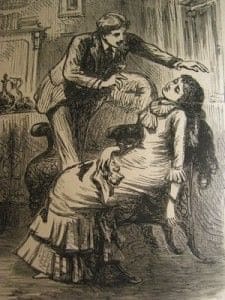
?— I think I did.
‘And you looked the paper very carefully as to what she said with reference to the Sunday evening?
— l did not look at the paper very carefully. I don’t read papers in the way you do (a laugh). I did not have any conversation with her after she gave her evidence here. I do not recollect saying before the magistrate in answer to you, that I was not sure whether Mitchell was left alone with the deceased or not. I think I have said that before and since, have I not? Mrs. Barry and Mitchell you know were not on very good terms have never known that they were not. Come. Mr. Fisher. — l have not, except so far as the abuse of the wife and daughter. Is Mrs Barry very good tempered? —take the rest the women (much laughter). Is she, aa a general rule, of an amiable disposition is, as a rule, a mild, nice, good-tempered woman.
Mr Hodson: I sure you did not have opportunity of seeing her face then, when she was being examined.
John Miles (Mr. Coller’s man) was recalled and said the bottle of lotion and powder that he gave to the man. Head was for the young bay horse. It was m May, and not in June, as he stated upon the last occasion. He had since had an opportunity of looking at the books of his master, which contained an entry of some blistering ointment witness took up fortnight before. There was no reference to the lotion or powder in the books.
By Mr. Hodson: I am not confounding one box of ointment with the powder.
Mrs. Barry was the next witness, but our readers are already familiar with her evidence, it being in the main features the same that given the magisterial investigation. She repeated and maintained her statement that the prisoner was alone with the deceased for some time on the Sunday evening, adding in answer to the coroner that she knew this was so, as she saw the nurse come in at the front door. Subsequently Mr. Mitchell entered the kitchen. If he had come in the front door they must have heard him.
The reason why she had not been able to give evidence here before was that she was taken ill after returning from the Court-house, at Weston, on the 13th August. Her symptoms were identical with those of her sister, and her medical man said she had been poisoned.
The Foreman: One of the jurymen is anxious to know if Mrs. Barry told the deceased what Mr. Lawrence’s suspicions were?
Witness: No, I never hinted such thing to her.
By a Juror: I might have said to Mr. Lawrence, he mentioned his suspicions, that “I thought it would come to that.”
What did you think?
— I might have said would end bad.
Mr. Henwood (a juror): How long had Mr. Mitchell been in prison before you were taken ill?
He was arrested on the Saturday, and I was taken ill the Monday following.
Mr. Kenwood: clear two days.
Witness: But I had been there all the week.
By Mr. Hodson:
Certainly did not communicate to the nurse the statement made to me by Mr. Lawrence as to his suspicions. made it known to the family in this way, what might be the cause of her death. think must have told them before her death of Mr. Lawrence’s suspicions, not Mitchell.
The coroner: Do you recollect Mr. Lawrence telling your brother of his suspicions in the presence of yourself cannot recollect, l am sure.
Mr. Hodson: Can you tell me whether in any positive way you communicated to your sister’s family the suspicions?
Mr. Lawrence, I told them it all it would count towards the end of my sister’s death. I did not consider it my duty to tell them till Mr. Lawrence had fully satisfied himself as to the real cause of the illness. Mr. Lawrence asked me not to mention it. So, in point of fact your sister was lying there in bed dying of poison, and you were aware of the fact, and you did not mention it to any member of her family did not. do not know when it was, I first mentioned it to John. Would you be surprised John told you never told him till after death?
— No, sir. Would you be surprised if the daughters said you never told them till after she was dead think did tell them. It never occurred to me to write down everything that happened after Mr. Lawrence mentioned his suspicions. I had no time to do anything of the kind. did my duty to the family.
Mr. Hodson: What did you mean by saying to Mr. Lawrence, you thought it would end bad.
— Witness (sharply): What do you mean Do you mean to insinuate anything, sir? I have come to speak the truth. Don’t twist my words into anything that is not true.
— Mr. Hodson: On the contrary I wish to assist you.
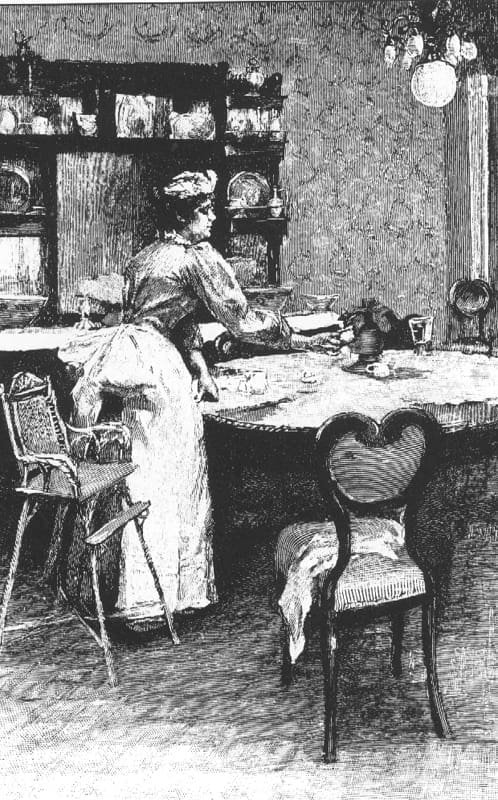
Witness (emphatically): I won’t have it, sir!
Mr. Hodson: You must have it. You are here to answer everything you can.
— Witness: Everything that is true I will tell.
The coroner: Don’t lose your temper, Mrs. Barry. Keep as quiet as you possibly can. You shan’t have any questions put to you that I don’t think right.
Mr. Hodson: Now, did you say to Mr. Lawrence when he pointed out his suspicions I thought it would end bad?”
Witness: When Mr. Lawrence gave an idea of what my poor sister was suffering from I might have said I thought it would end bad or was afraid it would come to something bad.
What do you mean by that?
— From the ill-treatment my poor sister received for many years. did not think it could end any other way.
The coroner: As I understand the witness, she would not have been surprised to find her sister was poisoned after the treatment she received.
— Witness: That is it.
Mr. G. E. Lawrence, surgeon, was recalled by Mr. Hodson, and said: I have had a fair amount of experience of cases of diarrhoea and am aware that in some form copper is sometimes administered. I do not administer copper. I took three bottles from the house which contained remains of medicine supplied at the order of myself from the chemists.
The coroner and jury then proceeded to the residence of Mr. Culler, farrier, Circus-mews, to take his evidence, Mr. Coller —owing to his infirmity—being unable to leave his house. In examination, he said that during the last ten months he had been occasionally in the habit of supplying medicine for Mr. Mitchell’s horses. bottle of lotion was supplied in May, but it was not entered in the bill sent to Mr. Mitchell from April 13th to June 12th. Mr. John Mitchell (son of the deceased): was never had.
The coroner: Don’t you speak.
Witness continued and said bottle lotion was taken with small box of blue powder. Said to Miles, “You, John, go up with the ‘bus. I believe it leaves at half-past four or a quarter to five and dress the horse’s leg once.” John returned, and said there was one there, and he could not go Midford and catch the horse himself, he left it there for Mr. Mitchell to dress the horse’s leg when Mr. Mitchell came, recollected that the lotion was omitted when this matter was first mentioned to him. Accounted for its not being entered because it was not put on the slate by Miles.
By Mr. Hodson: When witness was able to do so kept the ledger. Sometimes he was unable to write for months together, and then it was kept either by his wife or the little ******** There was no entry about the lotion in the daybook, which was made up not from memory, but from the slate, which was hung up in the yard. With the exception of one or two entries, the writing in the ledger from April 13th to June 12th was not his. had the slate up every evening. The lotion was sent to dress wound on the horse’s leg that had previously been blistered, and to keep the flies off. was composed of vinegar, treacle, and a small quantity of Verdigris —between two or three drams. It was in six-ounce medicine bottle. A box of ointment, composed of tar and lard, and small chip box of Verdigris, were also sent up at the same time. The latter would hold about two drams. Fixed the date which the mixture was supplied by the entry with reference to the blistering. The inquiry was then adjourned to the York House Hotel.
The coroner, addressing the Jury, said would endeavour to be as brief in his summing as was consistent with the gravity of the case. He thought it would be unnecessary to go over the bulk of the evidence that had been taken, as he felt sure that all the salient points were fresh in their memories, and they had had abundant opportunities of refreshing their memories by means of the press, and the adjournments were short. first thing be considered was the direct cause which led to this poor woman, Martha Mitchell’s, death. rom the evidence of the medical man and Mr. Gatehouse (analyst) they arrived rapidly at the conclusion that the deceased died from the administration of copper, which caused inflammation of the stomach and bowels, which produced such prostration as led immediately her death.
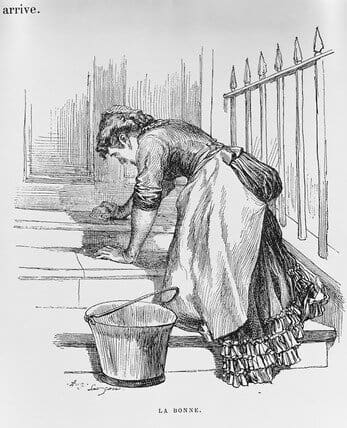
He said there seemed to be no doubt whatever, that the deceased died of copper. Copper, Mr. Gatehouse told them, was abundantly found in the liver and intestines, and Mr. Lawrence, after hearing this, had no hesitation in stating as his opinion that the deceased died from the administration of copper. That being the case, it was the duty of the jury to endeavour, if possible, to discover by what means the copper found its way into the body of the deceased. Did the deceased take the poison herself, either accidentally or with criminal intent, or was it administered to her by any other person or persons acting in collusion, with a criminal intent must confess that so far he could judge, there seemed to be no evidence to justify the belief that the deceased took the poison herself.
Mrs. Head distinctly told them that during the time she nursed the deceased, from the Friday her death, she never helped herself to any medicine, or even food, and that owing to her prostrate condition she was unable to do so. The green spots discovered upon the nightdress stated by Mr. Gatehouse be composed of copper, and identical with that fount! in the body, had important bearing upon the matter, tending, as did, in his opinion, to show that the deceased did no; take poison herself, but that it was given to her. they believed that she did not take it herself, it was for the jury then to try and find out whom it was administered. They had to bear in mind who were immediately associated with the deceased during her last illness and must say that the matter was involved in perfect mystery, and that the evidence was most conflicting. They would take first of all the evidence bearing upon the inuendo that the husband of the deceased administered the poison. Granted for moment that he did, they found it was only alleged that was left alone with her twice, and the evidence bearing upon this was very conflicting. The cross-examination Mrs. Barry impressed him very strongly with the idea that it would be very difficult for her to have seen Mr. Mitchell come, which was confirmed by a small drawing of the premises which had been made.
Having referred to the evidence of Mis. Head, in which she denied being absent from the room on Sunday evening the time she was said to have entered the house, the coroner directed the careful attention of the jury point, and also to statement made by Hill that she found the prisoner at home: with the deceased on one occasion, the nurse being adjoining room. the jury believed poison was administered the deceased, they most upon the eliminating principle with regard to the persons who were brought into immediate association with her, namely, her two sisters (Mrs. Barry and Mrs. Hill), Mr. Fisher, the nurse (Mrs. Head), and Mr. Mitchell.
The jury must say if in the case of either of them they could discover the existence of a motive such as would induce the killing of the deceased in this subtle way, and in a: riving at a conclusion they had a most serious and difficult task to perform. One could not for a moment believe that anything pointed to either of the sisters, or far as he could see, to the nurse. If suspicion pointed to anyone was to the husband, who had been heard to threaten the life of his wife, though only, as Mrs. Hill told them, conjointly with the whole of the family.
[Mr. Hodson: ” Cut their heads off.”]He (the coroner) could not from the evidence before him point out to the jury a motive for the husband administering the poison, neither could unreservedly recommend them to return a verdict of wilful murder against Mr. Mitchell. He would impress upon the jury the fact that killing by poison one of the most subtle ways of destroying the life another, and it was a very rare circumstance, as the history of poisoning cases showed, that the person was discovered in flagrante delicto. He left the case their hands, fully believing that they would give it the attention which it deserved, and that they would carry out the obligations their oath, without fear, favour, or affection. The coroner added that it had been suggested by Mr. Hodson that should remind the jury that cases of copper poisoning were very rare on account of the easy way in which they could discovered.
A Juror: The jury, I think, are fully aware of that. After about quarter of an hour’s deliberation, the announced that they had found that the deceased was poisoned by copper, but by whom it was administered there was no evidence to show.
THE ALLEGED MURDER ON COMBE DOWN.
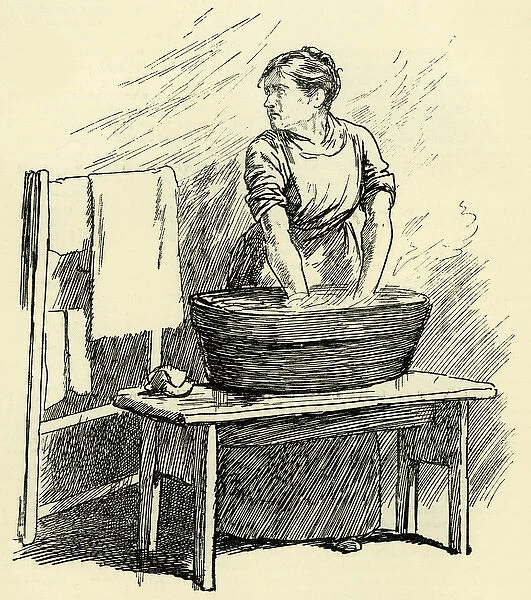
Frederick Mitchell was brought up, for the fifth time, at the Court-house, Weston, on Monday, upon the charge of the wilful murder of his wife, Martha Mitchell, August last
The magistrates present were Mr. Butler (in the chair), and Captain Sainsbury .— Mr. H. R. Hodson, of the Western Circuit (instructed by Messrs. F. H. and R. A. Moger), appeared for the prisoner, who looked good health and good spirits.— The Clerk (Mr. I. Williams) asked Supt. Morgan if he had any further evidence to bring.— Mr. Morgan having replied that had not, witnesses who were present (Mr. Fisher, the boy Burnell, and the Heads) then signed their depositions.
Mr. Butler then said: Frederick Mitchell, the Bench has come to the conclusion that they cannot send you for trial, and therefore you are dismissed from the charge, but it is not for me or for the Bench to say you are guilty not guilty. Every man who is taken up on a charge, if it is not pursued against him, it is assumed that he is innocent; but there are very many suspicious circumstances in the case which lead to the conclusion — an irresistible one — that your wife came to her end by bad means, and the evidence points to time when those means were used.
It is not for us now to attempt to incriminate you or anybody else, but justice for the present is defeated, and it becomes you, as it becomes all your family, and everybody who was connected with your wife, to see that justice is not defeated. Somebody, it is believed, will be pointed out criminal. Whether it will ever be cleared up or not it is not for me to say. You have been put under restraint for a considerable time — a restraint you would probably have not been put under if you had behaved in a decent manner towards your wife and family.
It is to be hoped that your locking-up will lead you to more serious thoughts and to your behaving more kindly to those about you. Nothing you can do will bring your wife back to life, but with regard to the restraint you have been put under, it is a very, very small punishment for the very, very sad conduct that you have exercised towards those about you. As said before, if any light can be thrown upon this, and if anyone is suspected within your circle, it will be your duty, as the duty of everybody else, to let that light be seen, and have the whole thing brought out.
Mr. Hodson: The prisoner is discharged, then?
Mr. Butler: Yes.
Mr. Hodson: I must thank you on behalf of the prisoner for the great pains and care you have taken in investigating this matter, and in seeing that the prisoner’s interests have not been allowed to suffer in any way. As far as am concerned, I must also thank you for your courtesy and impartiality. Mr. Butler said it was always the desire the Bench to see that the interests of accused persons were protected. He wished to say that the magistrates did not intend to allow the costs of all the witnesses, more particularly Mrs. Head and her son, who would not be allowed any expenses. It was quite evident from the depositions that her conduct throughout was not what could be desired, and that the son’s evidence was of such a character that the Bench did not attach any importance to it. Therefore neither Mrs. Head nor her son would have any expenses allowed to them.
Disastrous Fire
DISASTROUS FIRE ON COMBE DOWN. A HOUSE BURNT DOWN.
DISASTROUS FIRE ON COMBE DOWN.
A HOUSE BURNT DOWN. TWO LIVES LOST. A LADY INJURED.
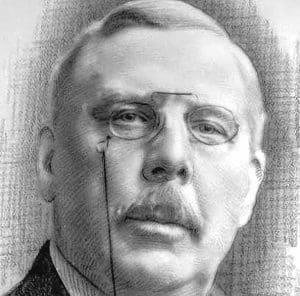
News reached Bath early on Tuesday that a fire of a serious character had broken out Combe Down about daylight, but the reports which came mto the city did not give any adequate idea of the shocking nature of the catastrophe.
We regret to have to state that not only did the fire consume a quantity of valuable property but that two young lives have been sacrificed, while a lady is suffering greatly as result of the outbreak.
The” scene of the conflagration is well-known to those’who have any acquaintance with Combe Down. Some years ago Mr. T. D. Clarke erected by the side of theroad running from the top of Prior Park to just the right hand side of the lane known Entry Hill just on the rifght side of a lane known as Foxhill two villas. The houses are one block, and would be described as semi-detached villas.
They have rooms on the basements level with the road; on which is the principal entrance, gained by a sloping raised pathway; and above that a second door The basement is entered a side door, above which juts out a small conservatory supported on iron.
Both houses are exactly alike or, it would be more correct to say “were” as one is now a complete wreck. That is the house thay you face to the right as you face the front or the one farthest from Fox Hill. This was occumed by Mr. Jolm Cunningham, a retired merchant, his wife four children, and two servants. Mr. Cunningham’also owned the house, which was named Southview The adjoining villa, known as St. Ellen’s, the home and property of Mr. Samuel Crisp, who recently came into prominence as one of the victims of the infernal machine.
How the fire which has caused so much damage and sorrow originated at present a mystery and probably will remain so.
Mr. Cunningham states that about ten o’clock on Monday night there were family prayers. According to the daily rule, and Mrs Cunningham and the two servants retired to bed. Mr. Cunningham at first intended to do the same, but there being a nice fire in the drawing-room he took up a book and sat reading until half past eleven. He then went over the house to see that everything was safe, and being satisfied in that respect went to bed.
All the household were sleeping on the top floor. In the principal front bedroom, over the drawing room, were Mr. Mis Cunningham and their youngest child, a baby boy of three, who occupied the crib by their bedside. In small bedroom adjoining also out in front, were the two servants Eliza. Gerrish, aged 18, and Emily Jordan, aged 15 In one bedroom at the back were two little boys, the eldest 10 years of age, and in another bedroom at the rear a, little girl who usually had her sister, Mr Cunnmghams eldest child, for companion, but she happened to away.
Early the morning, between five and six oclock, Mr Cunningham was awakened hearing the boys the back room cry out, and he told his wife he would go to them. She said, ” You had better tell them you are coming,” and their father did so.
When Mr. Cunningham opened his bedroom door he says the heat was intense but there was no smoke or flame. He gave the alarm to his wife at once, and hastened into the boys’ bedroom, carried the children down the stairs, out of the front’ door. He returned, and also brought out the bttle girl, and his wife having picked up the baby, gave him to her husband, and managed also to get the youngest child out in safety.
But he could not return upstairs again, for this time the fire, which seems to have developed all at once, had burst out the passages and the smoke was dense. As it was Mr. Cunningham, in bringing down the children, was badly singed about the head. He was only in his night attire, and the children were on the roadside in their nightfrowns.
How it is Mrs. Cunningham did not come down with her husband when he took out the baby is not quite clear She tried to come down the stairs.but was driven back the flames, and her forehead bears bums, showing that it was then impossible to make a way down. She then went to the window, and obeying the frantic shouts of her husband and of Mr. Crisp, who had come from his house, she stepped from the window slid over the roof of the drawing-room bay and jumped into the garden below, a depth of 25 or 30 feet.
Her husband and Mr. Crisp with help carried the unfortunate lady into the basement room of the adjoining house. She had evidently alighted on her elbow, and one arm was broken. Subsequently Mrs. Cunningham was kindly sheltered Mr T. Bodman, of the Foresters’ Arms, and later in the day was taken to the Nurses’ Home, Rivers-street.
How the servants became aware of their peril is not quite certain, but they seem have flown to the window which is situated immediately over the front door. Had they dropped from the window on to the pathway leading to the entrance it would only have been a matter of 12 feet or so to fall. They were implored Mr. Crisp and others who had now arrived on the scene to jump out, but they were too terrified to do so.
A quarryman named George Nowell, made a heroic attempt to reach them through the back of the house and reached the door of their bedroom, only to find it locked. He tried to force it open but failed, and had only just time to retreat with his life. How he acted will be described fully in an interview with him Evidently the poor creatures soon became overpowered and suffocated by smoke for they seem to have suddenly disappeared from the window and were lost to sight.
Ihe fire raged so furiously and the structure offered so slight a resistance to its ravages that before six o’clock the roof had fallen and the place was practically gutted. Everything it contained was destroyed except a tew articles thrown out of a back window by Nowell.
Mr Crisp and one of Nowell’s sons seem to have been the first to go for thebrigade or police. Young Mr.Crisp who is about 20 years of age says he ran own Entry-hill fast as he could, and when he got to the Bear Brewery smashed the fire alarm there, then ran down into the city and aroused tho Fire Brigade attheir quarters the Terrace-walks.
Mr. Crisp, with the help of neighbours, before the police or brigade arrived saw lt , was a question of saving his own property. There were in his house beside Mr. Crisp and his eldest son Mrs Crisp, Miss Cook, a servant, and seven children.
With out waiting to put on any clothes they all once left St. Ellen’s, and it was well they did for th flames soon found their way into that house.In the top bed room and drawing-room the effect of the fire onl Mr- Crisp’s house is most apparent. Great holes were.burnt through the dividing wall the walls and are blackened, and what was left in the rooms is destroyed by fire and water. Furniture was dragged out pell mell and piled in the front and back garden, and on the road side.
The police arrived first with their appliances, apparently about half-past six and were shortly after wards followed by the Brigade. Then they could not get water, the difficulties this direction being great. How these arose will endeavour to show later on.
From large rain water tanks at the back of the premises and from the ordinary taps buckets were filled and emptied in Mr. Crisp’s house to prevent the fire trom destroying his premises. This was difficult duty, tor the smoke was overpowering, and those at work were beaten back by the fumes and heat. At last, about eignt o’clock they were aided by water from the Fire Brigade hose.
The fire in South View practically burnt itself out. It was a risky thing to go near to the burning premises, for the falling debris from the roof and walls was a source of great danger, and the greenhouse at the side fell through with a tremendous crash.
Mrs. Cunningham, is a sister of the Rev. R. Nelson Howard, the Vicar of Combe Down; one child was taken there and three to St. Kilda, the residence of Mrs. Stanley Howard, sister-in-law of Mrs. Cunningham. Mrs. Crisp and her family proceeded to an empty house not far distant, where such articles as were urgently needed were taken for their use.
To add to the misery of the situation drenching rain began to fall, and the belongings of Mr. Crisp which were littered about the gardens, suffered from the down pour. When our representative arrived at the scene of the fire smoke was still issuing from the debris the bottom of the gutted house, and the Brigade were pouring water upon it. It appears that both Mr. Cunningham’s house and furniture were insured, but Mr. Crisp, who had many valuables residence, does not think his loss will be covered by insurance.
The remains of one of the poor girls were discovered in the debris near the side door by and Captain Bright, of the Fire Brigade. As of a human body it hardly recognizable being only a burnt fragment. Mr. Eddolls. Master of the Workhouse who was early on the scene, sent from that institution a wooden shell, in which it was placed. At first it was lying in the back garden of South-view with one of the broken doors covering it, but subsequently the was taken to a room in St. Ellen’s, and locked up.
MR. CRISP’S STATEMENT.
When our representative saw Mr. Crisp on Tuesday he was engaged in picking up ornaments, articles personal attire, etc., from the garden, where they had been saturated. Naturally he was in an excited state, after the terrible experiences of the early morning. He stated that he went to bed in the top room at the back of the house, about ten o’clock. Waking up in the night once or twice he fancied he smelt smoke, and even looked out of the window, but could notice nothing. Just about daylight he heard, through the dividing wall, Mr. Cuningham’s little boy crying “Dada.”
Thinking something was amiss Mr. Crisp ran out the front door and saw flames in the drawing-room of South-view, and Mr. Cunningham was at the door in his night shirt with his children, who were crying. Mr. Crisp had aroused his son, who having put on his trousers also rushed out.
The Crisp” family having been made aware of their danger Mr. Crisp, with Mr. Cunningham, did his best to save the lives of Mrs Cunningham and the servants. He urged Mrs. Cunningham to jump out, which she did, wearing only her nightdress, and he also shouted at the girls to do the same. Mr. Cunningham entered Mr. Crisp s house and tried to get to the servants from a window at the back, but found it impossible. It was so quick about, Mr. Crisp says, that there was no time to think of much, South View seeming to come down with a rush in a few minutes.
Mr. Crisp was helped by Mr. Bodman, junior, the Messrs. Russell, White, the waterman of the High Level Water Company, and many other neighbours to save his goods. Carpets were torn up in the lower rooms, but on the top floor the fire was so much possession that but little could be saved from that part of the house. A pile was made on the grass the roadside and covered over with etc Mr Crisp said his house was insured for and its contents for £300, hut this did not represent their value as he had costly pictures and ornaments as well as quantity of jewellery and prizes won his son in swimming contests in the house. His insurance was with an office of which Mr. Edwards, of Burtonstreet, the agent.
GEORGE NOWELL’S NARRATIVE.
We have referred to the gallant effort made by George Nowell to save the lives of the two servants. Nowell, who is about 50 years of age, lives at 1, Greendown-cottages and in an interview with our representative he said; “About five o’clock this morning, when passing Mr Cunningham’s house, I saw a light, in the drawing room and knew at once the house was on fire. Mr. Cunningham some children were outside with Mr Crisp and his son, all in their night clothes, shouting to the top front windows jump out. I knew there was a ladder, 25-rung ladder, down at Charlie Evans’s, and I ran to fetch it. On my way I woke up my sons, shouting out to them For Christ’s sake along to Mr. Crisp’s, it’s all on fire.”
They, I believe, woke up Mr. Bodman, young Mr. Bodman being one of the first here. When I got the ladder Davy Morris came along with me. We went with it into the back garden and I got up to the back window Morris gave me stone with which I smashed the glass and undid the bolt. This was at tho top. Morris came up after me and we got into the room. I could hear moaning in the front room and I went across though the fire and smoke were terrible bad. The door was locked. I put my knees against it and pushed with all my might but it would not open. Then I said to Davy ” It’s too hot here I can’t stand it,” and we got out of the window agaiu and down the ladder. I did not see the lady jump out but when I got round to the front again she had been taken into Mr. Crisp’s. The girls were not to be seen If I had only had something to break open the door with I believe I could have saved them.” Nowell then went on to describe how he helped preventing the flames spreading in Mr. Crisp’s house and in saving his furniture.
CHIEF INSPECTOR NOBLE’S INTERVIEW
It should be stated that the part of Combe Down , where South View is situated lies within the city. Chief Inspector Noble, of the Bath Police Force, although wet through and badly wanting rest, kindly gave our representative some information of the fire as he knew it.
He said “The intimation we had at the Central Police Station of anything wrong was att 6 o’clock. I was on duty hen the bell from the private telephoe from The Workhouse rang. I got up and answered it but no one replied.I rng up The Wokhouse but they sid they had not rung. Shortly after this Isaw some firemen running across the south side of Orange-grove.. I called out to them and theyn told m there was a bad fire on Combe Down. I had just dismissed the night men, but on hearng this I detained several, and we set out our large hose truck which we took down to Mr Cutting, fly proprietor, in Railway-street who horsed it. Sergt.. Clothier, Sergt. White, Sergt. Whippey, and several constables were with me.
We came up Entry-hill, but some of the men came across the fields to get there sooner. We took the hose to, near the weighing engine (close to the High Level Tank) we could connect there, but we found it was an old ratchet arrangement and we could not connect, was no hydrant nearer at all than that by Crosswaycottages at the top of Etnry-hill, and it was such a long distance we had not sufficient hose to reach tne fire The Brigade came soon after we were here and connected the tank. When we arrived the roof had fallen in and South View was past hope.
The servants must have lost their lives before we got here. The telephone bell which rung in the Police-station, and spoken of Chief Inspector Noble, was evidently set motion by young Mr. Crisp breakuig the alarm at the Bear Inn. The question naturally occurred to our representative why it was that the Fire Brigade and police did not join their hose and thus reach the fire from the Entryhill hydrant, but Mr Noble stated, and Lieut. Wadman, of the Fire Brigade, who was standing by, corroborated, that the hose couplings of the police and Brigade would not fit! Thus the hose could not be joined. Lieut. Wadman explained the difficulty with which the Brigade got water for their hose. They got the steam engine into the field-at the corner of which the destroyed house is situated—and ran it along to the High Levelncompany’s tank. Then they could not get water for a long while. An iron plate, secured with dozen rusty nuts, had to be unfastened before they could tap the water from the four-inch pipe feeding the tank above.
White, the Company’s official, helped them this, and then the water was allowed to flow into a hole, from which the steam engine sucked it up. Only one delivery was possible, and the police did not play on the fire at all. It is certain that the question fire extinction means, or the want of them, on Combe Down will be warmly discussed after this deplorable incident, though it would seem that the loss of life which has happened could not well be prevented.
Tuesday no trace of the other girl had been found, and it will be impossible from the fragment discovered to say which of the poor girls it is. Both Gerrish and Jordan belonged to Combe Down, and one of their fathers was among the earliest to arrive at the scene of the conflagration.
Dr Jones, of Combe Down, is attendance on Mrs. Cunningham. It was feared first that her hip was brokenfbut this happily is not so, though one arm fractured, and the lady lies m a critical state. Mr. Cunningham found shelter the Vicarage. Though not actually injured he is prostrated by shock.
Some delay, it appears, arose getting the steam engine to Combe Down, one of the four horses provided to draw turning out a jibber.
An accident happened to the police who were returning to the fire on the hose truck. It turned over near Devonshire Arms, and the party were thrown mto the road. P.S. Moon was cut about the head and other constables were slightly hurt. Despite the wretched weather the scene of the catastrophe has been visited by many people since. the frie The police are in charge of the ruins of South View and also of the adjoining house.
CAPTAIN BRIGHT’S STATEMENT.
Mr W. H Bright has given us the following facts: he had not then drawn up an official report: — The fire Brigade was called at 5.56 by Mr. Crisp’s son, who ran down in his shirt and trousers. A start was made about 6.10 and the Brigade when they arrived at the scene found the police there and doing all they possibly could. There was great difficulty about water as there is no hydrant nearer than the Crossway House, Entry-hilL The engine was taken through a field to the high water tank. and breaking an iron plate off the up pipe feeds the tank water was obtained. This which goe-into a large hole, was utilized, but it had to be carried between 700 and 800 feet. The house was gutted when they arrived, and what was done was performed by the combined efforts of the police and the Brigade.
The servants at the house, who both lived on Combe Down, were burnt. Their names are Jordan, aged 10, and Gerrish, aged 18. They were seen alive at the window of the third storey and were called upon by Crisp, Bodman and others to jump The trunk of one of them was found in a door at the basement on the top of the debris. It is thought probably that she fell through from the top of the house Mr Eddolls the Master of the Workhouse, provided a shell for these remains. The fire cannot have been discovered much before 5.30. At 4.30 everything appeared usual to Hiscocks (Mr Spear’s bailiff), although Crisp professes to have been uneasy about it the whole night. Mr. Cunningham was removed to to the Vicarage and his wife to Mr. Bodman’s private house.
She has a.broken arm and is altogether in a very bad state.
FURTHER PARTICULARS.
Mr. B. H. Watts, Deputy Coroner for the city, has decided to open the inquest upon the remains of one of the girls burnt to death at South-view, Combe Down, at the Guildhall this afternoon. Owing to the dangerous state of the ruins no steps will be taken to search for the remains of the other victim untd the walls have been levelled..
Mrs. Cunningham had so far recovered from her terrible experience that on Tuesday afternoon she was removed from Mr. Bodman’s house to a private nursing institution in Bath. She has so far improved that she can talk about what occurred on Tuesday morning, states that she endeavoured to get down the stairs when her husband was rescuing the children, but feeling that she was being overcome by the smoke she retired into her bedroom, afterwards jumping from the window.
Mr. Cunningham has recovered from the effects of the fire. He says that he banged the door of the servants bedroom which was close to that of the room where his wite and he slept, and shouted ” Fire.” He took it for granted that they would come down while he was rushing out with the four children, but they do not appear even to have unlocked their bedroom door.
No cause can he assigned for the outbreak. The idea that it had anything to do with gas light cannot be entertained, as before Mr. Cunningham retired he saw that no light hail been left burning. The fire is more likely to have arisen from timbers a chimney becoming ignited, for an inspection of Mr. Crisp’s now desolate residence shows that the houses were constructed in a manner not calculated to withstand a conflagration, especially in the arrangement of the beams supporting the floors.
As to the lack of hydrants on the main belonging to the High Level Company, this is not a lack for which the Bath Waterworks department is responsible, hut the Urban Sanitary Authority could compel the provision of hydrants in their district, and would have to defray the costs. In the Odd Down district where new mains were recently laid under the direct.on of Mr. Gilby, hydrants are provided, but we understand they are very scarce in Combe Down.
OFFICIAL REPORT BY THE POLICE.
The following report by Chief-Inspector Noble has been entered in the police book under Tuesday’s date:
“At 6 a.m. information was received at this station that a fire had broken out at South-view, Combe Down, and having just dismissed the men from night duty, in consequence of the information received I at once took steps to recall a portion of these men, and sent Sergt. Moon to the Rainbow Stables, Upper Borough Walls to obtain horse for the large hose truck, but failed to get one; we then took the large hose truck to the Kingstonroad, where we obtained a horse from Mr. Thomas Cutting, fly proprietor, who drove the truck with all possible speed to the scene of the fire. The police who accompanied me were Sergeants Clothier, White, Whippy, Short, Moon, Acting-Sergt. Horler, Constables Nos. 19, 16, 37, 38, 39, 54, 61, and upon our arrival we found the house, South-view, in one mass of flames; we satisfied ourselves that all was out of the house that could be got out, and we directed our attention to obtain water with view of preventing the fire from extending to the adjoining house, and at once proceeded in search ot water, and took the hose near the High Level water tank, thinking we could attach, but found was an old ratchet arrangement, and useless to our hose; there was no hydrant near the scene of the fire, the nearest being Crossway-cottages, near the top of Entry-hill, and it was such a distance we had not sufficient hose to reach the fire. The Fire Brigade under Captain Bright and Lieut. Wadman soon arrived, and after great difficulty obtained a supply of water from the High Level Water tank, which is situated in front of Greendown-cottages. The house was occupied by Mr. John Cunningham, a retired merchant, his wife and four children, and two servants, named respectively Emily Jordan, aged 15 years, and Eliza Gerrish, aged 18 years, who are both natives of Combe Down, and I regret to say that both of the above-named servants were burnt to death in this serious fire; a portion of one of the bodies was found by Captain Bright and myself, and steps taken to remove it to the adjoining house, to await an inquest. The police and Fire Brigade worked well together, and Colonel Gwyn was now in attendance and took charge of the fire. It cannot be ascertained at present what is the amount of the damage or the names of Insurance Companies. A subscription has been started for the families of the poor girls who lost their lives. The mother of one of them (Gerrish) is a widow who has brought up her famdy respectably, and still has several children dependent upon her” The poor woman is so heartbroken by the loss of her daughter that she cannot go out to earn her daily bread. Mr. E. R. Dolling, of Ihe Bank, Combe Down, will be glad to receive small subscriptions for the purpose indicated”

THE FATAL FIRE ON COMBE DOWN. MRS. CUNNINGHAM DEAD.
We regret that the fire at South View, Combe Down, has been responsible for another death.
The remains of the two servant girls were to be buried to-morrow, and now Mrs. Cunningham has passed away.
Mrs. Cunningham was a delicate state health at the time of the fire, and the jump which she took from the window fractured her elbow as well as causing other injuries. The excitement, too, must have had a bad effect upon one in her condition, and it was not to wondered at therefore that the daily bulletins issued after her removal to Surgical Home in Church-street showed her life hung upon thread. Since her admission this institution she had been attended by Mr. H. Terry, of Green Park, but all efforts to save her life proved futile, and her death took place at two o’clock this morning, the immediate cause of death being exposure and shock. Mr. Cunningham, who has been staying at the Vicarage, Combe Down, is affected this heavy blow, and the deepest sympathy will felt him and for his motherless little ones. Messrs. Ealand and Co. have the funeral arrangements.
THE INQUEST.
At the Guildhail on Thursday Mr. B. H. Watts, acting as Deputy for the City” Coroner, Mr. B. A. Dyer, opened inquest touching the death of a female unknown whose burnt remains were found in the debris after the fire at South View, Combe Down, on Tuesday morning. The Chief of Police, Lieutenant-Colonel Gwvn, occupied a seat on tho Bench by tho side of the Deputy Coroner. The Deputy Coroner, addressing the jury, said as at the unfortunate fire on Combe Down two” persons lost their lives, only one whose bodies had been found, he proposed to take only such evidence would justify him issuing order for the burial and then adjourn tor fortnight, during which time an examination might, made of tho ruins for the other body. The inquiry could then be resumed and evidence taken regarding the two deaths.
Mr. J. Cunningham, who was the first witness called, said he had lived at South View, Combe Down. He had no occupation. His wife, four children, and two servants lived in the same house. He last saw the two servants quarter-past ten on the night before the fire. He had not seen them since. Mr. Wm. Arthur Jones, registered medical practitioner, of Combe Down, said he was called see Mrs. Cunningham aud then afterwards saw the remains of a human body. There was only small portion left —a few ribs on either side, the vertebra;, and the thighs. The head was not to be found. That was about eight o’clock in the morning. Chief Inspector Albert Richard Noble stated that on Tuesday morning he proceeded to the scene the fire. When he reached it the roof was in and the house was nearly destroyed. Some time after, and when the fire was pretty well under, Mr. Bright and himself were together and Mr. Bright called his attention to what he found; afterwards was found to be the remains of a human body. This was the same examined by the doctor and viewed the jury. Mr. Eddolls, Master of the Workhouse, kindly sent along a shell. In this the remains were placed. The inquiry was then adjourned till 3 o’clock on Thursday, the hist., and the jury were bound over to appear on that date.
DISCOVERY OF FURTHER REMAINS.
The search of the police on Saturday in the basement at South View, Combe Down, for tho remains of the other poor girl was rewarded by the discovery of several charred bones. Had the search been delayed longer is doubtful whether these traces would have remained, as when the constables turned over the debris they found it was burning hot and smouldering, and water had to be poured on before they could proceed with their work.
The remains, with those found the morning of the fire, prove that two lives were lost. The police, by the direction of Chief-Inspector Noble, took the further remains to the Workhouse mortuary, where the shell containing the fragment found on Tuesday, was lying. But the Master, Mr. Eddolls, objected to it stopping there, and the coffin with all the remains it was brought down to the Walcot mortuary on Saturday evening in a cart.
Thousands of people wended their way on Combe Down on Sunday to view the scene of the catastrophe, and several policemen were on duty keep them off the premises. At Combe Down Church Sunday, the Vicar, the Rev. R. N. Howard, made suitable reference the painful event, mentioning that the younger of the deceased girls, Jordan, was worshipping that church last : Sunday evening. He also told the touching fact that Mr. Ctumingham’s little girl of seven, who went from her room out of the front door alone, when asked how she ‘ knew of her danger said ” God woke me.”
Mr. Dolling, who it will be remembered initiated subscription for the bereaved families, has up this time received £23 odd. This includes £1 15s. 6d. collected at the Combe Down Chapel on Sunday and £5 2s. 6d. collected by the Combe Down Football Club match on Saturday and from the visitors to the scene of the fire on Sunday.
OPENING THE SECOND INQUEST.
At the Guildhall on Monday, Mr. B. H. Watts, to enable the remains to be buried, opened an inquest concerning the death of Emily Jordan. Chief-Inspector Noble stated that on Saturday, in company with Sergts. Short and Bates, P.C.s Dyer and Rapsey, he searched, the scene the fire”. They turned it over very carefully, and a number of bones, which were placed in a box. later the day Mr. Fisher, the undertaker, told him the the remains were taken to the Walcot mortuary.
A Juror:
Did Mr. Eddolls give any reason,
Chief-Inspector Noble: Not to me. Mr. Fisher said he told him the remains were net removed he should have to bury them.
The Coroner: What is that?
Witness: Mr. Fisher told me so.
The Coroner: That’s an extraordinary statement make. He could not bury them without a doctor’s certificate or the Coroner’s order. Chief-Inspector Noble thought that Mr. Eddolls’s remark applied to the remains first found, for which Mr. Mr. Watts said in that case Mr. Eddolls was quite right, and could have buried them.
A Juror: One would have thought that at a public place which the ratepayers keep up there would be objection them remaining there.
In answer to this juror Mr. Noble said Mr. Eddolls made no objection to him when he took tiie remains to the Workhouse Saturday.
The Juror: Then for some reason unexplained he must have suddenly changed his mind?
Mr. Noble: It appears so. Mr. W. A Jones said the bleached bones formed an almost a perfect skeleton. From the lower jaw and the development the they were the remainsof a girl il aged 15.
THE FATAL FIRE COMBE DOWN. RESUMED INQUEST.
At the Guildhall on Thursday, Mr. B. H. Watts, Deputy City Coroner, resumed the inquest concerning the deaths of Emily Jordan and Eliza Garrish, who lost their lives in the fire at South View, Combe Down, on the 6th inst.
Mr. John Cunningham’s examination was proceeded with, the Deputy Coroner reading over the evidence given by him at the last hearing.
He said: My wife and servants had retired about a quarter past ten. There was a little fire the front sitting-room and I sat up, may be until half-past eleven. I then went to bed and can remember nothing until I was called by my wife saying the boys were calling.
The Deputy Coroner: Do you know what time?
—No, I don’t. It was about five to half-past. It was quite dark. I lit the candle and went towards the bedroom door. I opened it and then was struck with horror. I saw no flame or smoke but it was very hot. The whole place was like a furnace. I shrieked out ” Oh, we are on fire.” I dashed down to the half landing where the boys slept, and taking one by the hand and one in arms I rushed down the other half flight of stairs. My sitting-room door was open as I had left it overnight, and I could see as I rapidly passed the door that the fire was localised by the chimney. was crackling and beyond all hope of being put out.
The Coroner: It was blaziag well?
Witness: Oh yes.
The Coroner: Yet you saw no smoke upstairs.
Witness: There must have been smoke because the boys had been parched with the fumes.
The Coroner: Was their bedroom over the fire ?
Witness: No it was the back of the house but they were a half-landing nearer the fire than we were.
The Coroner : Was their door shut ?
Witness: Yes.
Mr. Cunningham, continuing: I rushed to the front door which I unbolted and took the two boys down the slope as far from the house as I could, leaving the front door open. Then I rushed hack again upstairs into the room where my wife was. It was all dark.
The Deputy Coroner: What had become of your candle then?
Mr. Cunningham: That I had left in the boys’ room I suppose, and it was blown out. I can’t remember anything about that. I said ” Where are you ?” She had got the youngest child out of his crib and brought it from the chimney side, the further side of the room near to the door and she gave me the little boy, the youngest. I rushed downstairs with him. I gave him to somebody I don’t know who and then I remembered that the little girl was still inside, and I shrieked out her name. “Oh Phoebe, where is she ?”
The Coroner: Was she sleeping in the same room as the boys?
Witness: No; on the same landing as ourselves and the servants in a room at the back. I heard someone answer ” Oh, she’s down here.” That was on Mr. Crisp’s side. She had gone over by herself. In answer to the Coroner the witness said their bedroom and the servants’ room occupied the front of the house on the same floor; the back, on the same floor, was the room where Phoebe was sleeping, and six or seven stairs down was the little room at the back, projecting out, where the boys slept, His wife must have moved a large duchesse dressing table from the front window to have got out. The Coroner: Why didn’t your wife come downstairs ?
Witness: I’ll tell you. When I saw her at the open window I said ” Why don’t you come and she replied ” I cannot.” There was no time for explanation. She said ‘* Shall I jump ?” and we said ” Yes if you can’t come down, jump,” and she jumped.
The Coroner: All this time the front door and the sitting-room door were open?
— Yes.
It didn’t occur you to close the sitting-room door?
—It didn’t occur to me. By that time the flames had spread from the fireplace towards the window, and from that moment she could not have got there at all.
The Coroner: Then what did you do with regard to the servants?
— Nothing beyond shouting.
As you went out of the’door to run to the children’s room could not you have knocked at the door?
—No, I didn’t. I shouted. There was of course only a small partition between the rooms, and I shouted for them as I did for Phoebe.
Yes, but I understand you shouted for Phoebe when you went out into the garden?
— When I thought of them. I shouted to all three rooms when I was out on the landing. They were all within a few feet of one another.
Was the servants’ door locked?
—l don’t know.
Was it locked from the outside ?
—I can’t say.
But you know what is your custom. If was locked from the outside you or your wife must have done it.
— There was no key on the outside.
But surely it was not your habit to lock the servants’ door?
—Oh, no, certainly not.
And so to the best of your belief was not locked all from the outside on that night?
— Certainly not.
Do you know, Mr. Cunningham, whether your servants were in the habit of locking the door themselves?
—I believe they were, but I can’t swear to it.
As soon as your wife was down what did you do?
—I rushed down to where she lay.
Who was there at that time?
There was lot of people about, and this must have taken some considerable time, I suppose?
— Very little time—not more than five minutes at the outside.
How did it happen so many people were congregated in so short a time?
—l cant tell you. Are you quite sure it didn’t take more than five minutes?
—l am quite sure, for this reason: One can in such straits what time it would take me to rush and down stairs twice. That is all I can go by
– Besides this fire in the sitting-room what others were the house on that night?
— There was fire the kitchen, and the fire in the nursery all day. The fire in the sitting-room had been lighted in the afternoon only.
What time did the children leave the nursery ?
—After tea, between six and seven o’clock.
Did anybody sit the nursery afterwards?
— No.
So that the -fire there would “not be kept up?
—lt would be out or nearly out, I should think.
You say it would be, but you don’t know as a matter of fact whether it was so or not?
— No. But I was in that room after the servants retired. I make a point of going round the house.
When did you go round the house that night ?
—I can’t swear whether it was before mv reading or not.
The Coroner: It was after your wife had gone to bed ?
—Yes.
Witness said when he went round the fire in the nursery was out, and there was very little fire in the kitchen. None of these fires were raked out on to the hearths. He carried a candle when he went on this round. The house was lighted by gas; they used no oil at all. They had ordinary burners, with the exception of one incandescent light in the room in which he was reading. He put it out before he went to bed. He was sure the fire did not arise from it, as when he passed the room with the boys he saw that the fire was over the chimney, and not the centre of the room where the gas light was.
A Juror (Mr. J. J. Young): Didn’t it occur to you to knock at the servants’ door as you went down with the children ?
—No. I didn’t.
Mr. Young :Or to try the handle?
— No. Because I had shouted in such violent way that it didnt occur to me. My first thought was that the Are was the boys’ room as the call of alarm came from there.
Young: When you went into their room you found no fire?
— No.
Samuel Crisp, of St. Ellen’s, Combe Down, repeated the evidence he gave at the inquest on Mrs. Cunningham as to how he was aroused on the morning of the fire. He do keep on saying ” Dada, dada” ana Jiliza. When he looked out of the window he saw smoke from the back of Mr. Cunningham’s house. He broke their drawing-room window with step and threw water on to the fire. After Mrs. Cunningham had jumped and he was taking her into his house he saw the girls looking out of their window, and he said to them Why don t you jump?” When he came back he saw Gerrish, the elder girl, looking out of the window Mrs. Cunningham had jumped from. He again said “Why don you jump or come down the back.” He ran round to the back, but saw nothing of her, and came back to tne tront He heard screaming, but saw nothing more of the grrls Then Nowell came along. He had been shouting out “Fire” for five minutes When he first got to Mr. Cunningham’s house he could not get past the front door. He thought all three could have come downstairs had they come down at first.
By the Coroner: He first saw both the girls the window over the front door, which was open; it was only a minute or two afterwards that he saw Garrish at the window of Mrs. Cunningham’s room. He saw the girls after he had thrown the water into the room.
By a Juror: Gerrish must have come out of her own room and gone into Mrs. Cunningham’s room for him to have seen her at the window of the large room. He was positive he saw her in that room.
By the Coroner: He thought the girls could have easily come downstairs when he told them to jump.
George Nowell, of Down-cottages, was next called. He said his Occupation was that of quarryman. He said he was passing Mr. Cunningham’s house a few minutes after five o’clock on the morning of the fire. He saw a light in the drawing-room. Mr. Cunningham, Mr. Crisp, Mrs. Crisp, aud Mr. Crisp’s son were coming from the direction of Mr. Crisp’s house. Mr. Crisp and himself tried to get in at the door, but could not do so. Mr. Crisp threw a scraper outside the door at the drawingroom window and broke it.
The witness Crisp: You weren’t there till ten minutes afterwards.
Nowell reiterated his statement, whereupon Crisp, saying I won’t listen to the man, he’s telling lies, left the Court. Nowell, proceeding, said he saw the two servants standing with Mrs. Cunningham at her bedroom window.
Asked by the Coroner if he was quite sure about Crisp breaking the window, he said: Yes, the fire would not have been so fierce if he had not done it. But he did it without a thought I daresay.
Continuing Nowell said he saw the two servants with Mrs. Cunningham at the front window. He ran back, called Mr. Bodman and his sons, going back to the fire with a ladder. His brother-in-law was with him. When they got to Mr. Cunningham’s gate Mr. Crisp said ” For God’s sake go in at the back.”
The Coroner: What was the condition of the fire at this time? —It was coming out of the windows, and the wind was taking it through the back of the house.
Was the fire in the passage?
Witness did not think it was.
They put the ladder up the back, and he got into a back bedroom. He had to move a looking-glass to get in. He felt in the bed, and there was no one there. He tried to burst open the door, but coidd not as was locked from the outside. The flames coming under the door he had to get out.
In answer to the Coroner, Mr. Cunningham said the room into which Nowell got was a spare bedroom, underneath the boy’s bedroom. It was four steps down from the drawing-room landing. So the passage must have been well alight when Nowell was in there?
Mr. Cunningham: Yes.
Nowell, continuing, said he threw some bedclothes, the looking-glass, and other things out of the window of the room he entered. When he got out of the room they went into Mr. Crisp’s house. Subsequently he carried Mrs. Cunningham to Mr. Bodman’s. Benjamin Cambourne, of Fox-hill, a milkman, said he passed these houses about ten minutes or a quarter-past five on the morning of the fire, but in reply to the Coroner stated that it was the back the houses he passed.
The Coroner said he understood the witness passed the house at the front, where he would have been bound to see any signs of fire had there been any. Otherwise he should not have called him.
George Morris, builder, of 4, Manvers-street, said he examined Mr. Crisp’s house last Tuesday company with Inspector Noble. From his examination he should say the fire originated in Mr. Crisp’s house by the fire catching the joists. As to the fire in Mr. Cunningham’s house he could say nothing.
By a Juror: The fire did not break out in Mr. Crisp’s but in Mr. Cunningham’s, and burnt through into Mr. Crisp’s.
George Nowell, re-called, said he could give no idea as to what time it was when he was at the fire.
A Juror mentioned he was at the house at a quarter to six, and no floor had fallen in then; the sitting-room floor fell in first, then the bedroom floor, and then the slate roof.
Mr. W. H. Bright, of High-street, wished to make an explanation, and so was sworn as witness.
Replying to the Coroner, who asked if he was Captain of the Volunteer Fire Brigade, he said: Fire Brigade, not Volunteer.
You were called to this fire on the morning of the 6th inst?
—Yes, when we arrived there the police had preceded us with their truck. was found to be a great distance to the nearest hydrant from the fire. The distance from the High Level Water Company’s tank to the hydrant was somewhere about 2,000 ft. That was the hydrant in Entry-hill by Crossway-cottages. Inspector Noble informed him he had not sufficient hose to reach hack to the fire, and asked him if he had any couplings, me (Mr. Bright) answered yes.” He thought, however, they would be very little use owing to the distance from the hydrant to the fire. Just at that time he was told that White, the man who looked after the tank, wanted him. He came running up to him, and said he could get plenty of water at the tank. They took the engine, but there was more difficulty than they anticipated getting the water. He wanted to explain that because of a remark which was made in the Bath Chronicle,” in which it was stated: ” The question naturally occurred to our representative why was that the Fire Brigade and police did not join their hose and thus reach the fire from the Entry-hill hydrant, but Mr. Noble stated, and Lieut. Wadman, of the Fire Brigade, who was standing by, corroborated, that the hose couplings of the police and Brigade would not fit! Thus the hose could not be joined.” He wanted to explain that the hose could not be joined, and that they carried couplings for that purpose. could quite understand such an answer might be given when the men were busy. That was not quite the time to expect the most accurate answer on matters of detail. Some time ago, he proceeded, the Fire Brigade, adopted the latest and quickest mode in hose couplings, and he showed how these acted. So as to work with the Police they also ordered lot of connectors. The method of using these things was also shown.
A Juryman remarking : You should send them up on Combe Down.
Mr. Bright: We had them up there. Continuing, he said, his reason for not coupling up the hose was that the hydrant was too far away. If they hat! connected at the top of Entry-hill, 2,000 ft. from the tank, and brought the water back 1,300 ft. to the burning house, the pressure would have been so little that it would have been like pouring water out of a kettle. If they had had a hydrant within a hundred yards it would have been all very well. There was a good reason for not coupling the hose because was no use. Mr. Noble knew it, he knew it, they all knew it. He thought they had 13 of these connectors. He made this explanation because it had gone forth to the public, and might have given them the idea that they were working at cross purposes, and that was not the case.
The Jury returned a verdict of ” Accidental Death.” [The explanation which Mr. Bright has offered naturally calls for some comment from us. We are glad to hear that there are means by which the hose of the police and the Brigade can be joined. It was the idea that such connection ought to be possible that occasioned our surprise the statement that the couplings did not fit. That statement was made and nobody on Thursday contradicted it. Why Mr. Bright has not made the explanation earlier we fail to understand. The paragraph he quoted appeared on the 6th October; to-day is the 22nd October, and this is the first we have heard of it. Had Mr. Bright chosen to address us a letter we would gladly have given it publicity.—Ed. B.C.]


Avenue Hall
Avenue Hall
Avenue Hall was the original name for what are now the Church Rooms, built and donated by Captain Oswald Borland R.N. (1820 – 1915).
Captain Borland was also unfortunately involved in the Maikop oil boom of 1910. Companies were set up in the UK to operate Maikop oil fields in the Southern Kuban province of the Russian empire.
In 1910, as many as 20 companies with an aggregate capital of 54,580 roubles[84] were registered in Great Britain for crude production in Maikop. The stocks of most of these companies were quoted on the London Stock Exchange. In the same year, the stocks of 13 Maikop-based Russian oil companies were listed on the LSE. In the next two years, another 14 companies were established.
By 1916 only 5 companies were still in existence.[85] It seems Captain Borland had invested but that the company was a ‘bubble’, created solely for the benefit of the promoters and he lost money. He applied for a compulsory winding up even though it was winding up voluntarily as doing that was the only way to get an investigation. He did not succeed.[86]
Avenue Hall was at the centre of village life for many years.
In 1925 the trustees agreed to sell to the church which had wanted to replace the old Church Rooms with something that was not a “disgrace to the parish”.[87]
Avenue Hall became the parochial headquarters when they were dedicated in 1926.[88]






